

Stories featured on the cover are shown in orange

“Mitchell and Webb are everything their Peep Show alter egos aren’t—intelligent, funny and successful,” says features writer James Rampton.

“The lab I visited was very small and full of equipment,” says photographer Barry Marsden. “Yet out of unglamorous places like these come the most extraordinary scientific advances.”

“The impulse in tough times is for everybody to work harder,” says author Ian Price. “But, paradoxically, we could be more productive, happier and even wealthier working fewer hours.”
32 Reasons to Be Cheerful, Part 24
James Brown enjoys Bonfire night— but loves the build-up even more
36 Mitchell and Webb TV’s top double act on their new series, old jobs, and the joys of black pudding
42 The World’s Most Amazing Restaurants Is there nowhere you can’t get a decent plate of food?
50 The Future Stars of Medicine
Discover the big breakthroughs on the health horizon
56
Alice Cooper: “I Remember”
The undisputed king of rock ’n’ roll reveals how his wife saved his life
62 The Maverick: “We Don’t Need a Five-Day Week” Why working less is more productive and healthier
66 Best of British: Cinemas
Watch the lights go down in these wonderfully original film houses
74 A Legend in Its Own Teatime
How Countdown became a British institution
80 100-Word Story
£1,000 for the best tiny tale!
82 The Forgotten Temple
Meet the British architect who’s taken on the mother of all restoration projects—in the Cambodian jungle

90 FESTIVE FOOD SPECIAL
Easy-but-delicious dishes that are guaranteed to take the stress out of Christmas

What’s going on in the jungle? Find out on p82
NOVEMBER 2012 FEATURES
PHOTOGRAPHED BY CRAIG STENNETT

Whilst I struggle with the concept that burglars are brave (thanks for that, Judge Peter Bowers), I do agree that bravery can take many forms. For example, when we talked to Alice Cooper this month, for all his rebellious rock-star behaviour, he says the bravest thing he’s ever done is tell people he goes to church! See p56 for more intriguing insights into what lies behind that now-familiar face paint.




I’m afraid the bravest thing I can lay claim to this month is facing up to the fact that Christmas is looming, and starting to make the odd list or two. It’s just as well we have a food special on p90 to help gear up for the festive season—which I hope will also give me a fighting chance of finding time to see the new series of Peep Show, featuring our cover stars Mitchell and Webb. Find out more about what makes their remarkable friendship tick on p36.

2 READERSDIGEST.CO.UK NOVEMBER 2012
WELCOME REGULARS
Reader’s Digest the World’s Biggest Magazine published in 50 editions in 21 languages On our cover: David Mitchell and Robert Webb photographed by Ian Harrison/Camera Press, London Gill Hudson theeditor@readersdigest.co.uk facebook.com/readersdigestuk twitter.com/rdigest CONSUMER MEDIA EDITOR OF THE YEAR 2011 WINNER OF THE MARK BOXER AWARD 2011 ...at the front 9 Over to You… 13 Radar: Your Guide to November 19 You Couldn’t Make It Up… 23 Word Power 26 In the Future… 28 Instant Expert 30 If I Ruled the World: Phil Redmond ...at the back 102 1,001 Things Everyone Should Know 108 Medicine: Max Pemberton 110 Health: Susannah Hickling 114 Beauty: Alice Hart-Davis 117 Consumer: Donal MacIntyre 120 Money: Jasmine Birtles 127 Gardening: Bob Flowerdew 130 Wildlife: Martin Hughes-Games 132 Online: Martha Lane Fox 134 Motoring: Conor McNicholas 136 Travel: Kate Pettifer 141 The Reader’s Digest— our recommended reads of the month 149 Books That Changed My Life: Arlene Phillips 154 Test-Your-Knowledge Crossword 155 Teatime Puzzles 156 Laugh! With Alun Cochrane 160 Beat the Cartoonist








WRITE ON…
Send us your stories, jokes and letters—if we publish, we pay!
WE PAY
£50 for the star letter, £30 for regular letters and £15 for short extracts.
SMALL PRINT SUBSCRIBE!
Ensure submissions are not previously published. Include your name, email, address and daytime phone number with all correspondence. We may edit letters and use them in all print and electronic media. Contributions used become world copyright of Vivat Direct Ltd (t/a Reader’s Digest).
WE ALSO PAY SORRY!
Email readersletters@ readersdigest.co.uk or write to Readers’ Letters, Reader’s Digest, 157 Edgware Road, London W2 2HR £70 for the true stories, anecdotes, jokes in Laugh! and You Couldn’t Make It Up…, and contributions to end-of-article fillers, Travel and Gardening.
Email excerpts@ readersdigest.co.uk or write to Excerpts, Reader’s Digest, 157 Edgware Road, London W2 2HR
We cannot acknowledge or return unpublished items or unsolicited article-length manuscripts. Do not send SAEs. Article-length stories, poetry and cartoons are not requested.



“I don’t like it. Jerry’s too quiet… get out there, Tom, and see what’s going on”

Visit readersdigest.co.uk or write to Reader’s Digest, PO Box 444, Douglas, Isle of Man IM99 3ZF. UK: £42 a year. Republic of Ireland: €74.39 a year. Europe: £50 a year. Rest of the world: £60 a year. Prices include delivery. For Gift Subscriptions contact Customer Services below
CUSTOMER SERVICES
Contact Customer Services for renewals, gifts, address changes, payments, account information and all other enquiries. Phone: 0871 351 1000* Email: customer_ service@readersdigest.co. uk Minicom: 0870 600 1153
TALKING MAGAZINES
Reader’s Digest is available in a talking edition for blind and partially sighted people for £16. For details, phone: 01435 866 102; email: info@tnauk.org.uk, website: tnauk.org.uk.
twitter.com/rdigest facebook.com/
4 READERSDIGEST.CO.UK NOVEMBER 2012 *CALLS FROM A BT LANDLINE WILL COST 10P A MINUTE. CALL COSTS FROM OTHER PROVIDERS MAY VARY.
GO TO
TO FIND OUT MORE PRIZE DRAW
readersdigestuk SIGNED UP FOR OUR FAMOUS PRIZE DRAW YET?
READERSDIGEST.CO.UK













@READERSDIGEST.CO.UK

Online this month…
CUT YOUR FOOD BILL
Our Money expert
Jasmine Birtles gives you some great tips on how to keep your shopping bill down. Listen to her podcast at readersdigest.co.uk/magazine

EDITORIAL
Editor-in-Chief
GILL HUDSON

HOW TO LOSE WEIGHT


Dr Max Pemberton’s podcast on shifting the pounds could be exactly what you need in the runup to Christmas (and beyond). Listen to it readersdigest. co.uk/magazine


Managing Editor
CATHERINE HAUGHNEY
Design Director
MARTIN COLYER
Features Editor
SIMON HEMELRYK
Deputy Production Editor
TOM BROWNE
Assistant Features Editor

at readersdigest.
ELLIE ROSE
Art Editor
HUGH KYLE
Picture Researcher
ROBERTA MITCHELL
Website Assistant
VICTOR OPPONG
Contributing Editors
SUSANNAH HICKLING (HEALTH)
CAROLINE HUTTON
PLUS: Take a look at our great new range of Reader’s Digest Holidays at readersdigest.co.uk/holidays, and our exclusive shopping and discount club at readersdigest. co.uk/intrordextra


CHECK OUT our other fabulous apps, too! Go to the iTunes music store to download our magazine iPad app or our walking app.
Visit our online shop for over 1,000 great books, gifts, jewellery, bargains and more!


HARRY MOUNT
JAMES WALTON
LOLA BORG
ADVERTISING
Head of Advertising Sales
ADRIAN MILNER
Account Directors
SIMON FULTON
JIGS PANKHANIA
SUZANNE SMITH
Magazine Executive
MARINA JOANNOU
MARKETING
Subscriptions Marketing Manager
JAMES GREENWOOD
Subscriptions Marketing Assistant
LAURA LYNSKEY
CHIEF EXECUTIVE OFFICER
THIERRY BOUZAC
THE READER’S DIGEST ASSOCIATION INC
President and Chief Executive O cer
ROBERT E GUTH
President, International
DAWN M ZIER

6
© 2012 Vivat Direct Ltd (t/a Reader’s Digest). British Reader’s Digest is published by Vivat Direct Ltd, 157 Edgware Road, London W2 2HR. All rights reserved throughout the world. Reproduction in any manner, in whole or part, in English or other languages, is prohibited. Reader’s Digest is a trademark owned and under license from The Reader’s Digest Association, Inc and is registered with the United States Patent and Trademark O ce. All rights reserved. Cover and advertising reproduction by FMG. Classified advertising by Madison Bell. Printed by Polestar Chantry, Polestar UK Print Ltd. Newstrade distribution by Advantage. PUBLISHED BY VIVAT DIRECT LTD (T/A READER’S DIGEST), 157 EDGWARE ROAD, LONDON W2 2HR PAPER FROM SUSTAINABLE FORESTS. PLEASE RECYCLE
Follow us at twitter.com/rdigest. Like us at facebook com/readersdigestuk














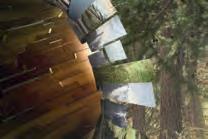









OVER TO YOU...
EMAILS, LETTERS, TWEETS AND FACEBOOK
£30 FOR EACH PUBLISHED LETTER, £15 FOR SHORTER EXTRACTS,
£50 FOR THE LETTER OF THE MONTH!
SEE P4 FOR MORE DETAILS

LETTER OF THE MONTH
I was horrified to read the Maverick article “It’s Our Duty to Have Designer Babies”. Professor Julian Savulescu shows real arrogance in thinking anyone might judge objectively what’s a blessing and what’s a curse in a child’s personality. No one wants their kid to su er an illness, but I’d rather have my sister (who successfully battled cancer in her twenties) than not at all—her life has a value beyond her condition. Making judgements about which foetus is “best” is intrinsically sinister. My husband works for the Ambulance Service, and his lower level of empathy allows him to stay cool when dealing with distraught patients. Who will do this if the trait is bred out? As for hot tempers, a genetic tweak won’t solve that. In the classroom, the worst tempers are usually linked to other factors, such as tough home lives.
I would hate to live in the kind of society Julian Savulescu advocates. Who wants humankind to be as bland as the apple section in a supermarket?
Abigail Watkins, Derbyshire
SHADOW PLAY
“A Walk in the Dark”, Andy Hamilton’s article about living without power, took me back to bringing up my kids on my own. There were days when I had to switch o everything to save fuel—we jumped into my bed early, told jokes and made up stories. My boys loved it, although it was hard at times. During tough periods, however, we must remember there are people around the world who can’t just turn on a tap or a light when they want.
Angela Quinn, North Tyneside
A WING AND A PRAYER
Your “Instant Expert” column on airport expansion claims that only five British airports are served with chapels and chaplains. Actually, most UK airports have chaplains, with many more around the world (a full list is on the website of the International Association of Civil Aviation Chaplains at iacac.ws). It’d make a good subject for a future article.
Reverend Roy Monks, Chaplain, East Midlands Airport
JUST A CLICK AWAY
As “Log On to Therapy” suggests, online counselling is a real innovation. My son
►
9 NOVEMBER 2012READERSDIGEST.CO.UK

“It’s a shame it’s such a clear day. When it’s cloudy you can’t see a thing from up here…”




gambled away over £15,000 at poker. He tried online therapy because he couldn’t do faceto-face sessions, but thanks to the help he received, he hasn’t played poker online for money for nearly 12 months now. If it works for gambling addictions, I’m sure it can work for other personal problems, too.
Name withheld
TURNING THE AIR BLUE
I was disappointed by your interview with Benedict Cumberbatch. Why does a well-educated and intelligent young actor have to swear so much? Given our rich language, it’s unnecessary. Don’t stoop to the level of tabloid journalism!
Don Hebron, Newcastle
SCAN OR SCAM?
Donal MacIntyre’s Consumer item about checkouts in the supermarket struck a chord
with me. On a recent shopping trip, a sta member insisted on rescanning all my items. Everyone was looking at me, so it was very embarrassing.
As it turned out, it was the supermarket that had made a mistake—one item hadn’t gone through with the “reduced to clear” price. But I won’t be using self-scanners any more.
Alan Jacobs, Cheshire
DARKNESS AND LIGHT
“Cresting the Waves” showed how soldiers can use sport to help with post-traumatic stress disorder (PTSD), but I’d also like to highlight a relatively new treatment for PTSD called eye movement desensitisation and reprocessing (EMDR), a near-miraculous treatment.
I recently retired from NHS Mental Health, and in 2009 we were told to prioritise referrals from recent combat soldiers. But as no soldiers referred

“COME AGAIN?”
● “…Yes, I glared at him through gritted teeth…”
● “…The furthest I could go was the front gate and shout across the road to my mate Billy Ferguson but it did not defer from having a good day at home…”
● “…Dying is easy. Anyone can do it…” [That was the whole email]
● “…I bought my ‘bikes’ as bits and pieces to be assembled exactly as I want my bike to be…”
● “…Every day Maz saw the doctor who gave the same question: ‘What’s your name?’ ‘My name is Maz.’ Doctor’s folder closes. Maz left…”
● “…This obviously isn’t meant for publication, but I thought you might like a peep anyway (not as much as the camera crews like obsessing over animals ‘in the act’, so to speak)…”
10 READERSDIGEST.CO.UKNOVEMBER 2012
ILLUSTRATED BY SAM FALCONER
◄
themselves, we couldn’t treat them. So I’d urge soldiers with PTSD to contact their local NHS mental health unit. They can have EMDR alongside any other activities they wish to do.
Sonia Keith, Edinburgh
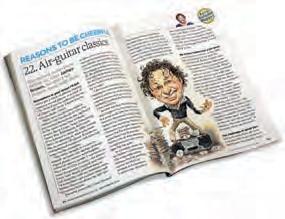
VINYL MEMORIES
It’s a shame that James Brown, while reminiscing about his CD collection in “Reasons to Be Cheerful, Part 22”, only made a passing reference to vinyl. I’ve been going through all the LPs I collected over the years, transferring them to computer in case my record deck packs up. It’s been agony looking at all the artwork and cardboard sleeves, wondering if I should
chuck them out or keep them as a reminder of the old days.
Francis Glasser, Manchester
SOLD A PUP
In addition to the information in “Best of British: Wildlife”, I think one of the best places to see grey seal pups is Donna Nook National Nature Reserve in Lincolnshire. The peak time for “pupping” is this month, and numbers have topped 1,000 in recent years. Visit lincstrust.org.uk for details.
William Ward, Grimsby
FIRING UP
The “RD Driving Special” suggested you should fasten your seat belt before switching on the ignition. But advanced driver training would advise the opposite—if you experience a problem when switching on the ignition, such as a fire, having to unfasten your belt could take vital seconds. It’s unlikely, but you never know!
Ian Latham, Milton Keynes
TWEET OF THE MONTH

Chris Hester @chrishesteruk @rdigest Sweet article in Reader’s Digest by James Brown, who gave up sugar. Now he sleeps better, has more energy and no more mood swings.

YOU’RE STILL TALKING ABOUT…
All the Olympics coverage in our July issue and beyond
● The Olympic slogan of “Inspire a Generation” has been etched into the hearts and minds of every person living in this country.
Hermion Tavarayan, London
● I’m worried by the sudden enthusiasm for compulsory competitive games. Let’s play voluntarily for fun or not at all.
Derry Jones, North Yorkshire
● As your “Animal Athletes” showed, we can’t compete with the speedy cheetah, the longjumping grasshopper or the weightlifting dung beetle.
Hannah Bryan, Liverpool
● I’ve been driven to distraction by the Olympics! Why did the media assume that everyone would want to know all about it all the time?
Claire Pilcher, Kent
11 NOVEMBER 2012READERSDIGEST.CO.UK















Film R A D AR
The not-blushing

Author and BBC2 Review
Show critic Natalie Haynes on the new releases
IN CINEMAS
Great Expectations As you may remember from the BBC Dickensfest at the start of this year, 2012 marked the author’s 200th birthday. So what better way to celebrate his double century than with a lush new production of one of his greatest novels?
Helena Bonham Carter finally gets her hands on Miss Havisham, the ultimate goth bride gone bad; Ralph Fiennes terrifies as Magwitch; and War Horse’s Jeremy Irvine plays the country-boy-turned-gentleman Pip. The film focuses neatly on the divisions that define the story: between love and hate,
YOUR SHORT, SHARP GUIDE TO NOVEMBER ►

wealth and poverty, and— most importantly—money and class. Meanwhile, the theatrical decay of Satis House and the chaotic squalor of London are beautifully realised.
Argo Ben A eck (below) directs and stars in this tense hostage drama, based on a true story. Six US embassy sta are caught up in the 1979 Iranian revolution; in

 bride: Helena Bonham Carter as Miss Havisham
bride: Helena Bonham Carter as Miss Havisham
order to keep them safe, the government’s best plan (really) is to pretend they’re a film crew, scouting Iran for locations.
It’s a ridiculously audacious story, and it’s to A eck’s credit that the fun Hollywood scenes (John Goodman and Alan Arkin are glorious as studio execs) doesn’t jar with the tension.
DVDS
Magic Mike
Hot guys, few clothes, dancing. The Amazing Spider-Man Andrew Garfield makes a lovely Spidey—vulnerable and funny.

E.T. 30th anniversary edition. The little alien went home… and now he’s back.
Gadgets

Siemens full-surface induction hob, around £1,400 If your dinner guests are impressed when you whip up Nigella’s meringues, they’ll be gobsmacked by this.

The intelligent ceramic hob can sense up to four pots and pans —of any shape or size—placed anywhere on its surface, and will heat only the area directly underneath them. This means your food is cooked more evenly and e ciently—it can boil water in 50 seconds (gasp!)—and the rest of the surface remains cool to touch.
AND CHECK OUT…
Apple iPhone 5, from £529 (or free with contract) The new smartphone’s post-launch frenzy has died down, so let’s reflect on its key points.
The four-inch retina screen: longer but

not wider. Hooray, I can still text with one hand!
Panoramic photos: a toy, obviously, but lots of fun.
The much-criticised Maps: well, it’ll be updated soon.
TeaGreen EnergyEGG family pack, £49.95 These wireless plug adaptors sense when you’ve left the room and turn o your electrical devices, saving energy and reducing bills.
Aukward fabric iPad case, £119 Handcrafted in the Cotswolds using traditional fabrics, these beautiful bookish cases have a sturdy wooden frame to protect your tablet computer. Technology expert and Answer Me This! podcaster Olly Mann reveals the latest must-haves
FaceTime: videochat on the move —the philanderer’s worst nightmare.
Overall: the thinnest, most intuitive smartphone ever.
Samsung, it’s over to you…
14 READERSDIGEST.CO.UK NOVEMBER 2012
R A D AR
◄

album in six years, and harks back to the spare, tender beauty of her first records.
The 2nd Law by Muse


Music


BBC 6
Music’s Stuart Maconie’s pick of the recent releases
Sugaring Season by Beth Orton
Think the sister between Joni Mitchell and Laura Marling. Long before people talked about nu-folk or anti-folk or whatever we’re calling it these days, Beth Orton burst onto the scene sated by Britpop’s braggadocio with music that was both hip and plaintive. Her songs were pleasingly indebted to an older English strain of bedsit balladry by the likes of Pentangle and Vashti Bunyan, but infused with a modern club cultural cool. This is her first
Think Radiohead admitting that they really want to be Queen. Depending whether you found their o cial London 2012 song “Survival” a gloriously anthemic realisation of the Olympian ideal or a bloated waste of time and money, you’ll either love or hate the sixth Muse album. Revelling in its own e ulgence, it makes Noel Gallagher sound like Nick Drake. A 3D Jerry Bruckheimer blockbuster of a modern rock album.
Greatest Hits: 50 Big Ones by The Beach Boys Think the summer we never had. Does the world need another Beach Boys compilation? Well, as the pop industry’s business model collapses, maybe, at least, a decent Beach Boys compilation is always a banker.
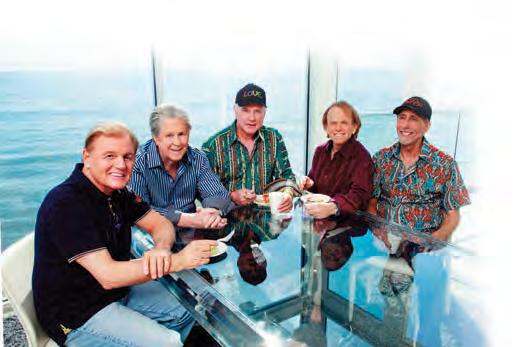
And this is certainly a decent collection—a comprehensive overview of their singles augmented by their latest release, the not-too-shabby “That’s Why God Made the Radio”. Which would have been a better title, in fact, for this whole album—a canon of unsurpassable pop genius.
15
►

Cross-country skiing, FIS World Cup, Round One, Gällivare, Sweden, November 24–25. Gällivare is a town that— according to Wikipedia—boasts a remarkably high incidence of a condition that makes you insensitive to pain. It’s a good place, then, for this masochistic event to take place. The UN recently voted cross-country skiing “Most Useful Sport to Be Good at When Being Pursued By a Bear In a Forest In Winter”. Defending men’s and women’s cup champs, Dario Cologna and Marit Bjørgen, have never been eaten by a bear.
India v England, 1st Test, Ahmedabad, November 15–19. England’s glorious ascent to the top of Mount Test Cricket in 2010 and 2011 has been

ESPNcricinfo cricket blogger, broadcaster and stand-up Andy Zaltzman previews the best of the month’s action





followed by a bumpy toboggan ride back down to the Valley of Normality this year. Their slide has been marked by inconsistency on the pitch and infighting o it—which led to key batsman Kevin Pietersen being sent to Coventry rather than India. New skipper Alastair Cook will have to keep a firm hand on an oddly irritable tiller.
AND DON’T MISS…
Barclays ATP World Tour tennis finals, The O2, November 5–12. England v Australia rugby union, Twickenham, November 17.
November 9–11 The Wine Show, Olympia. November 15 World’s Biggest Liar contest, Wasdale, Cumbria. November 23 The Human League 35th anniversary national tour starts.

Joanne Campbell, 39, part-time psychology lecturer
READING:
Dead Reckoning by Charlaine Harris. Vampires, fantasy and wit. It’s great escapism from my stressful job.
LISTENING:
Keep Calm and Relax by Various. Chirpy wee songs from people like Will Young and JLS.
ONLINE: pilates.about.com I slipped a disc recently, so this is a good resource for exercises to help me strengthen my back.
READING:
ALSO ON OUR RADAR READER
The Big Bang Theory (Channel 4). A US sitcom about science nerds. My husband is a doctor of physics, and he and his mates were just like this at college. ■
16 READERSDIGEST.CO.UK NOVEMBER 2012
RADAR Sport
R A D AR GETTY IMAGES














YOU COULDN’T MAKE IT UP…


¶ On my day o , I decided to do a spot of window shopping in town.
I had a lovely afternoon browsing the shops, sipping co ee and visiting my local art gallery. I smiled to myself on the bus home, thinking about what a perfect day I’d had.
Suddenly it hit me that I’d gone in the car and— although I was on my way home—it was still parked six miles away in the towncentre car park.
Nhadine Markham, Yorkshire
¶ I tried to post a parcel from my local delivery store, but was told that they only accepted parcels with a barcode.
My older sister jumped in, berated me for my “stupidity”, and o ered to buy a book of barcodes from the assistant.
Norman Wall, London
¶ Out with her dad, my three-year-old niece was fascinated by a group of people pulling on backpacks as they prepared to board a plane.
“What are they doing?”






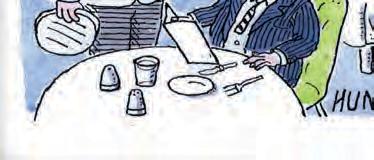

¶ A FEW YEARS AGO, IN MY JOB AS A POLICE OFFICER, I was sent to take a statement from an elderly victim of burglary who lived in a tidy period property. I arrived and began to scribble notes, but my attention was distracted when a large dog walked calmly into the room.
The dog sni ed around curiously, settled in the corner and proceeded to defecate on the floor. The lady glanced at me and smiled nervously. I smiled back. She made no attempt to clean it up, but I presumed, given the tidiness of the house, she’d do so when I’d left.
After a while I stood up to leave, thanking the lady for the cup of co ee, only for her to ask politely, “Are you not taking your dog with you?”
I never did discover the identity of the dog’s owner— nor how it got into the house—but the bemused look on her face still haunts me today. Andrew Howe, Leeds
19 NOVEMBER 2012READERSDIGEST.CO.UK
►
“Best give the broth a miss today, sir”
she asked. When her dad said they were going parachuting, she replied excitedly, “Oh, can we go parrot shooting, too?”
Paul Consterdine, West Midlands
¶ Walking out of the train at London’s Waterloo, I saw some tourists standing behind the open doors of a train, posing for a photo being taken outside.
Unfortunately, as soon as the photographer said “Cheese!”, the doors in front of them closed.
Andrew Yuen, Twickenham
¶ While working in the o ce, I took a call from an irate elderly lady who told me o for phoning her first thing in the morning, and demanded I “take her o the list”.
When I explained it must be a wrong number, as we don’t make calls to the general public, she started shouting and repeating her phone number. I apologised, and took a note of her name.
When the call ended, I turned to my colleague and said, “Phew,
¶ AS A FLIGHT ATTENDANT, it was my job to create a happy atmosphere and chat to the passengers.
In the business cabin, I approached a gentleman and said cheerily, “I do


“I can’t sleep a wink. It feels like I’m lying on minted pea purée and chanterelles in elderflower jus”

that was a rude old cow!” He glanced at the name I’d written down, and said quietly, “Erm... that was my mother.”
Helen Ritchie, Surrey
WIN £70 FOR YOUR TRUE, FUNNY
STORIES. EMAIL excerpts@ readers digest.co.uk OR GO TO facebook. com/readers digestuk
¶ “Look, mum, I’m a ninja!” shouted my young son as he rolled out of bed.
“I don’t think so,” replied my daughter in a sarcastic tone.
“Well, have you ever seen me doing that?” he replied.
“Doing what?” she said.
“Exactly!” he snapped back triumphantly.
Zainab Moiz, by email
like your surname—it’s very unusual.” I thought he looked a bit surprised. “Yes,” I carried on glibly, “I wish I had as attractive a name.” Failing to note the lack of delight, I ploughed
on, “Mr Christmas is such a great name.”
The man in the seat behind said, “I’m Mr Christmas. We swopped seats. That’s Mr Seaman.”
Sue Lewis, West Sussex ■
20 READERSDIGEST.CO.UK NOVEMBER 2012
◄


WORD POWER

Harry Mount explores the ancient sands of Egypt


November 4 marks the 90th anniversary of the moment British archaeologist Howard Carter uncovered the tomb of Tutankhamun, the Egyptian pharaoh. The wonders of ancient Egypt have captured the public imagination ever since. Test your knowledge of Egyptian terms by answering A, B or C.
1 ibis n
A pharaoh’s crown
B seal for documents
C wading bird
2 Copt n A Nile chicken
B Egyptian Christian
C ancient altar
A word is born: To salmon
The verb “to salmon” means to ride your bike against the flow of tra c, like a fish swimming upstream. Salmoning is extremely annoying to drivers, and useful but dangerous for cyclists.
RD Rating Useful? 6/10 Likeable? 8/10
Carter examines Tutankhamun’s sarcophagus
3 shadoof n
A irrigation device
B holy crocodile
C temple chamber
4 pharaoh n A ruler
B slave C evil curse
5 hieroglyphics n
A ploughs B group of priests C ancient writing
6 uraeus (you-reeh-uhs) n
A pyramid top B small cobra C royal bathroom
7 papyrus n A paper made from water plant B tax-collector
C palace wall
8 oasis n A counting table B building mortar
C desert watering hole
9 adobe (ah-doughbee) n A oil painting
B clay-and-straw brick
C sea view
10 sphinx n
A mythical female monster B riddle
C sharp claw
11 natron (neightron) n A bangle
B slave overseer
C embalming fluid
12 ziggurat (zigguhr-att) n A stepped pyramid B poisonous milk C winding road
13 Ra n A sun god
B mermaid C sculpture
14 bazaar
A magician B Oriental market C yacht
15 Ptolemaic system (toll-ih-may-ick) n A brutal regime B astronomic theory C religion with many gods
OUR COVER STARS’
FAVOURITE WORDS?
David Mitchell: seldom
Robert Webb: syllepsis (when a word governs two or more other words*) ►

*Example: “He hit the road and his friend.”
23
HARRY BURTON/GETTY IMAGES (CARTER)
WORD POWER ANSWERS
9–11 getting there
12–13 impressive 14–15 word-power wizard!
1 ibis C
wading bird. “The ibis has strikingly long legs.”
Egyptian hby.
2 Copt B
Egyptian Christian. “Many Copts have been persecuted for their faith.”
Arabic qubt
3 shadoof A irrigation device. “Shadoofs lined the banks of the Nile.” Arabic shaduf
WHAT’S YOUR FAVOURITE WORD? WIN!
We all like a nice beverage to keep the cold at bay, but did you know that “rumfustian” is an archaic word for hot drink? You’ll find it in the Word Lover’s Gallimaufry section of the Chambers
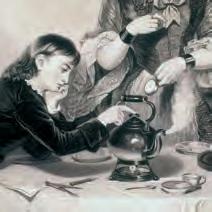
Thesaurus, along with many others. To mark the new edition, we’ve teamed up with Chambers to launch a word-lovers’ competition— all you have to do is tell us your favourite word and you could win £100 in cash plus £100-worth of Chambers products (there are 50 runner-up prizes up for grabs, too). Enter at readersdigest.co.uk/magazine
4 pharaoh A ruler. “The pharaohs first ruled during the New Kingdom.” Egyptian pr-o (great house).
5 hieroglyphics C
ancient writing. “The Rosetta Stone cracked the hieroglyphics code.”
Greek hieros (sacred) and glyphein (carve).
6 uraeus B
small cobra. “A uraeus on a headdress signifies royal power.” Greek ouraios (snake).
7 papyrus—A paper made from water plant. “Many great works of literature survive on ancient papyrus.”
Greek papyros.
8 oasis C
desert watering hole. “The thirsty man thought the oasis was a mirage.” Greek.
9 adobe B
clay-and-straw brick. “Houses in Egypt were usually built of adobe.” Coptic tobe (brick).
10 sphinx A
mythical female monster. “The sphinx had a human head and a lion’s body.”
Greek sphingein (to bind tight—sphinxes killed their prey by strangling).
11 natron C
embalming fluid. “The
Play WP online: go to readersdigest. co.uk/wordpower

pharaohs were soaked in natron.” Egyptian ntry.
12 ziggurat A stepped pyramid.
“Ziggurats were first found in Mesopotamia.”
Ziqqurratu (pinnacle), from Akkadian, an extinct Semitic language
13 Ra A sun god. “Ra had the head of a falcon.” Egyptian.
14 bazaar B
Oriental market. “The Cairo bazaar is a rabbit warren of shops.” Persian bazar.
15 Ptolemaic system B astronomic theory.
“Ptolemy thought the sun, moon and planets revolved around the earth.” n
24 READERSDIGEST.CO.UK NOVEMBER 2012
SCIENCE MUSEUM, LONDON

IN THE FUTURE…
...we’ll print our own homes, says Gary Rimmer
DIY building
Contour Crafting—brainchild of a Californian engineer— is a prototype system for 3D printing of entire houses. It uses a bespoke composite fibre concrete that holds its shape while wet, and is extruded from a nozzle on a gantry that moves back and forth like an inkjet printer. Floors, insulation, plumbing and wiring can be inserted as required according to sophisticated software instructions as the building rises. There are still some technical problems to solve but, in theory, the system could build a house in less than a day, at significantly cheaper-than-normal costs, using fewer people and with less environmental impact. This system could be tried and tested by 2020 and in widespread use by 2025.


Battle of the clones

By 2050, some researchers think we’ll be manufacturing artificial red-blood cells that could carry enough oxygen to enable Usain Bolt to sprint the 10,000 metres—even though it’d never be allowed!

Pill spying
Taking medicine at the right time is vital, yet many of us forget or fail to do so. A recently approved system to tell doctors that a pill’s been taken may therefore be a

welcome advance. A silicon chip the size of a grain of sand is embedded in each tablet. As the “mother pill” dissolves, the chip sends a signal to a skin sensor. A doctor is then notified the pill
But one area where bioscience is set to make its mark legally is in Olympic equestrian sport. Thanks to a recent ruling, cloned horses may now compete, though none will likely be mature enough before 2024. It’s felt that in equestrianism, equine genetics is an insignificant factor for success compared with, say, training and a rider’s skill. Not so in horse racing, where genes matter —cloning will stay as much a taboo as in the 100 metres.
has been taken via a mobile. After smart pills, by 2017 there’ll be smart sutures. Embedded with micro heat sensors to detect the heat of an infected wound, they’ll respond by releasing controlled amounts of antiinfection agents. ■ be
































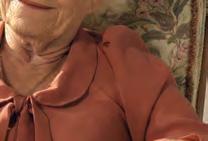






INSTANT EXPERT
Harry Mount reveals the facts behind the news
November 11 is the 70th anniversary of the day when the Nazis invaded Vichy France. To mark it, we take a closer look at one of Europe’s darkest periods
What was Vichy France?
It was the name of the French administration that collaborated with Germany during the Second World War, from July 1940 to August 1944. During those years, the unoccupied southern “free zone” of France was under Vichy control. The French government sat in the central spa town of Vichy, although Paris remained the o cial capital. The northern and western half of France, although occupied by the Germans, was also under Vichy’s administrative control (even if German law trumped French law in the region). AlsaceLorraine was directly run by the Germans, and a small chunk of land on France’s south-eastern flank was under Italian control.






Who was in charge in Vichy?
Marshal Philippe
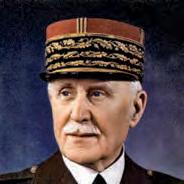
Pétain (above), a French soldier who was a national hero after the Battle of Verdun in 1916. In July 1940, he became Chief of the French State, as the French government was known during the war. At 84, he was France’s oldest-ever head of state; he also had the right to nominate his successor.
Why did the Germans invade?
When the Allies landed in North Africa, Hitler worried about his weakness on France’s southern flank. On November 11, 1942, German forces invaded. But despite this, Vichy retained civil control over practically all of metropolitan France until 1944.
ROSTISLAV BOTEV/WIKIMEDIA COMMONS
GERMAN ZONE FREE ZONE SIGMARINGEN OCCUPATION

Vichy France

Did the Vichy government actively support the Nazis?

Yes. Pétain was photographed shaking hands with Hitler, who was delighted with the arrangement. It meant French overseas territories— many of which were under Vichy control—weren’t ostensibly German-controlled and so were not invaded and controlled by the Allies. It also meant Hitler was ultimately in charge of France while conserving much of his own manpower. To make Hitler even happier, the French had to pay Germany for the costs of occupation—20 million Reichsmarks a day, 50 times the real cost.
The Vichy regime also collaborated in the expulsion of 77,500 French Jews, who were murdered in concentration camps. It also repressed communists, gypsies and homosexuals.

Did the rest of the world recognise the government?
Mostly—until the Germans invaded Vichy France in November 1942. Russia maintained relations and the US sent an ambassador. After the British attacked the French navy at Mers-el-Kébir, Algeria, in July 1940, to stop the fleet falling into Nazi hands, Vichy’s diplomatic relations with the UK ended.
What happened after the Allied invasion?
The rump of the Vichy government took refuge in Germany, and tried to run France from the German town of Sigmaringen.

Did the French back the Vichy government?

Lots did, although Charles de Gaulle (right) established a rival French government, the Free French Forces, in London, and the Resistance battled against collaborationists and Germans on French soil.


Britain, the US and Russia recognised de Gaulle’s Provisional Government of the French Republic in October 1944. Vichy collapsed when Sigmaringen was invaded in April 1945 by the Allied French. Back in France, there were many attacks on Vichy collaborationists— thousands were executed. French women who’d had relationships with German men had their heads shaved. Pétain was sentenced to death, but the sentence was commuted to life imprisonment. He was kept on Île d’Yeu o the French coast, where he died in 1951. ■
thousands
women who’d had relationships life coast,

UNIVERSAL HISTORY ARCHIVE/GETTY IMAGES; POPPERFOTO/GETTY IMAGES
29
IF I RULED THE WORLD
Phil Redmond
TV producer and screenwriter Phil Redmond grew up in the Liverpool suburb of Huyton. He used the formative experiences of his life to write the children’s drama Grange Hill. He also created Brookside and, later, Hollyoaks, one of the most established soaps on UK TV, now in its 17th year.
and, later,
I’d insist that anyone in power had experience dealing with teenagers. Then I’d know they were experts in negotiation skills and tolerance!
I’d make culture a front-line service. Too often, funding for things like libraries or the arts is cut as soon as public spending is under attack. The mantra “front-line services first” is supposed to protect areas like health and education. Yet to bring about any change, whether economic, social or political, requires cultural shift—a change in what we do together. As the Olympics and Edinburgh Festival have recently shown, culture not only creates an inspiring environment where people come together, but it also creates footfall. That means people spending money,
which is what fuels the engine of regeneration.


intervention. I grew up watching



what I wanted to create with
I’d force broadcasters to re-evaluate their contribution to public service. TV was once a powerful tool for social intervention. I grew up watching strong, relevant drama, and that’s what I wanted to create with Grange Hill and Brookie. We didn’t want to change the world, but to create a platform where campaigners and activists could get a better hearing. The BBC should be to the media what the NHS is to medicine. Channel 4 and the BBC are our two public-service broadcasters, and I’d like to take some of their channels and hand them over to public services such as education, health or the police so that they all had air time to talk directly to people. Other broadcasters can take care of light entertainment.

I’d make it illegal for companies to use premium phone lines, particularly when the customer is calling with a complaint or question. It’s outrageous to be charged £1 a minute for something that should be part of the service.
30 READERSDIGEST.CO.UK
I’d stop fiddling with the education system. Kids need to read, write and to understand how to learn. Then they should be taught the relevant skills to allow them to advance into full-time employment in their area. We should look at local needs—what companies require and value—above national benchmarks. If kids want to move beyond that, then that’s what higher education is for.
I’d enforce a single, agreed fee on any loan. That way, everyone would know what they’re supposed to be paying without finding themselves charged more than they borrowed in the first place. I’d also stop utility companies penalising people who don’t pay by direct debit. If someone put their hand in your pocket and stole your cash they’d be arrested; a lot of firms are simply digitally pickpocketing people. It should be up to companies to manage their own costs.

A lot of firms are simply digitally pickpocketing people ‘‘ ’’
money would have transformed a provincial city.
I’d make the eco argument relevant. The planet is warming, so let’s focus on the practical issues—how we should be coping with the e ects, rather than trying to stop it, which is impossible.
I’d redefine our idea of “working”. As chair of National Museums Liverpool, I see the huge benefits that can be gained by volunteers contributing to the workforce. We couldn’t manage without the 500 volunteers who work alongside our 600 salaried sta members, and their reward is to be doing something stimulating and useful. About 20 per cent of the NHS budget is spent on mental health, and many problems start with depression, often caused by loneliness or a lack of purpose— voluntary work can help to alleviate these feelings. A job is much more than a pay cheque.
I’d ensure big international events are hosted outside capital cities. The billions of pounds spent on the Olympics would have been a lot better spent outside London, where the As told to Caroline Hutton
I’d popularise my favourite saying. I’m a Scouser, and we say, “You can always tell a Scouser...but you can’t tell him much!” ■
31 READERSDIGEST.CO.UK NOVEMBER 2012 ILLUSTRATED BY SAM FALCONER
Phil’s new memoir Mid-term Report is out now
REASONS TO BE CHEERFUL
24. A Night of Mischief
Bonfire Night is fun, says James Brown, but the mayhem leading up to it is even better
When I was a kid, the build-up to Bonfire Night was as important as the night itself. In fact, back when I was running around the streets of Leeds with my mates, I preferred chumping —the gathering of wood to burn—and the night before Bonfire Night, known locally as Mischief Night.
Unlike scrumping (the ritualistic raiding of apple trees in gardens, prompted by the apples ripening), chumping just started—no one knew the date. Kids would roam the woods, wastelands, streets, building plots and backs of shops to find anything made of wood. Gates, broken fences and newsagents’ tables were all great finds. Tree branches that had been pruned but not cleared were a staple. Broken garages were stripped, dens plundered, and wooden pop-bottle crates were thrown onto the pile that would become the bonfire.
As soon as the bonfire was built— ours was on the rough ground at the bottom of some woods in Headingley —there was the matter of guarding it to stop rival areas coming and burning it. Guard duty would be debated for
hours, and then eventually cancelled with the news that someone somewhere got badly burned when guarding the “bommy” from within.
Once the bonfire was finalised, Mischief Night was pretty much a licence to run amok. Hedgehopping involved diving onto massive hedges. This was extended to hurdling over garden walls and hedges. Doors were knocked and run away from. Bangers were exploded in empty milk bottles. The angrier the response you got, the more fun it was. The climax of the evening was being chased by an irate adult.
By the time the lighting of the bonfire came around on November 5, strange food, powerful smoky smells and screeching fireworks were everywhere, and last night’s street terrorists were transformed once again into awestruck kids. Adults would try to force parkin down your throat (what the hell is parkin?). Toffee apples were both lethal and amazing, depending on where you bit. And there was a constant desire for more bangers, supersonic

32 READERSDIGEST.CO.UK NOVEMBER 2012
bangs, airbomb repeaters and rockets.
Ever since then, I’ve been a sucker for a superb firework display. The biggest I ever saw was on July 4 in the Hamptons, Long Island. The most haphazard and noisy were the New Year’s Eve bangers raining down from the flats in Kreuzberg, Berlin. And the most secret bonfire was the one four of us had in my back garden, which we disguised from my ex-wife—I spent a week dropping grass clippings, twigs and bark over an eight-foot-wide burn where the lawn had been.
But probably the most stunning Bonfire Night I’ve encountered is the Rye bonfire procession. This year it’s on November 10, and it’s just one of



the many processions and fires organised by the famous Sussex Bonfire Societies.


Lewes is the biggest and most popular bonfire, but many people don’t know the Sussex Bonfire Season lasts most of the autumn. Remember the climax of a Hammer Horror film, when the mob of townsfolk waving burning torches march up to Frankenstein’s castle? That’s what Rye High Street looks like—a procession of different bonfire societies with drummers and fire carts making alarming rumbles through the town as they pick up lost burning torches. The marchers dress in the blacked-up faces and outfits of traditional smugglers, strange orders of monks, skeletons, RAF pilots, ►

33 NOVEMBER 2012READERSDIGEST.CO.UK ILLUSTRATED BY DANIEL MITCHELL
There’s a definite air of irresponsibility and organised mayhem, and it’s all genuinely thrilling
◄
busty wenches, cavaliers, pirates, sailors, and pretty much anything that reflects the local history.
At the heart of it is a huge firebreathing dragon. Firecrackers leap out of heavy cauldrons, scattering their sparks and noise across the roads. There’s a definite air of irresponsibility and organised mayhem, and it’s all genuinely thrilling. For a moment you see a sight from times gone by, and then the procession winds round the
hilltop town, down onto the local fairground space where a giant bonfire is lit with the throwing of torches. The blaze is so hot you can feel it on your face 40 yards away. It’s Bonfire Night, it’s bigger than ever, and it’s a very obvious reason to be cheerful. n
James, founder of Loaded magazine, now edits Sabotage Times—an online magazine with the motto: “We can’t concentrate, why should you?” You can follow James on Twitter @jamesjamesbrown.
BUDDING AUTHOR S, TAKE A BOW
This apocalyptic yarn was one of thousands of tales submitted to last year’s 100word-story contest. We’ll be featuring a commended story in the magazine every month. See p80 for details of this year’s contest.

Submitted by Dan Bentley, Godalming, Surrey
Tuesday
The world ended on a Tuesday. This in itself is strange, because nothing ever happens on a Tuesday besides some light drizzle. It’s the dull younger brother of the other weekdays. It doesn’t carry the same mind-numbing dread as Monday mornings, or the reckless elation of Friday afternoons. It doesn’t have the distinction of being in the middle like Wednesday. Even Thursday sounds more impressive.
“What’s it like out there?” the shift manager asked as I hurried into work.
“The sky’s on fire and torrents of blood are falling from the heavens,” I replied.
“Really?” he said. “On a Tuesday?”
Dan says: “I used to work in a corner shop. Every morning, one of the regulars would say, ‘It’s warm out there,’ or, ‘It’s a bit nippy out there.’ It was typical of the British fixation with the weather—I could imagine her on the day of the apocalypse saying, ‘The sky’s on fire and torrents of blood are falling from the heavens.’ I was toying with, ‘The world ended on a Tuesday,’ as an opening, so this idea struck me.’ ”
Dan will receive a cheque for £70
34 READERSDIGEST.CO.UK NOVEMBER 2012
‘‘
’’





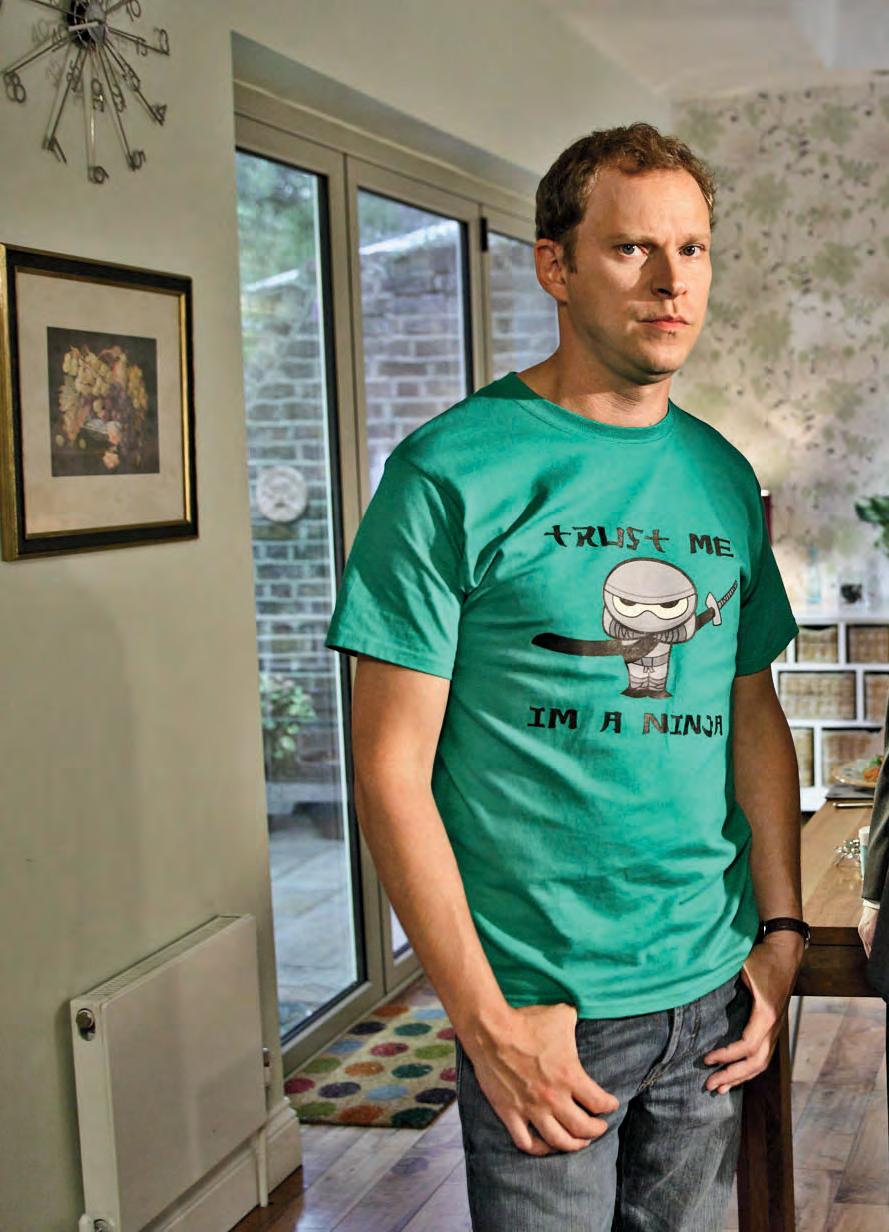

“It’s




a bottomless pit of potential problems”
Comedy stars Mitchell and Webb explain the odd appeal of their Channel 4 hit Peep Show—and why it may run for ever and ever
36
BY JAMES RAMPTON

I’m in an unremarkable pizzeria in Ealing, west London. But I’m hunched over a monitor, not a margherita.
This is the set of the eighth series of Channel 4 comedy Peep Show, and I’ve been invited to see some filming before talking to David Mitchell and Robert Webb, the show’s stars.
In the scene I’m watching, gloomy office worker Mark (Mitchell) is trying to look positive as his girlfriend Dobby chirps happily about life. But—as always on a show where we constantly hear the downbeat, confused thoughts of Mark and his failed musician flatmate Jeremy (Webb) via a voiceover—his inner monologue tells a different story.
My Tupperware box of tasteless misery sand, is his analysis as Dobby enthuses about his healthy couscous salad. I hate and fear every facet of that idea, he reflects upon her suggestion that they go InterRailing for a month.
It’s not surprising that many women believe they’ve learned more about the male psyche from Channel 4’s longest-running sitcom
► 37
◄
than they ever have from their partners. But Peep Show’s success (Ricky Gervais called it “the best British comedy on TV”) is also based around one of the most dysfunctional—and all-too-familiar —friendships in TV history.
“Mark and Jeremy make each other feel better because they have someone to look down on,” says David, 38, as he and Robert chat during a break in their schedule. “Mark thinks, My job is going badly, but not as badly as his, while Jeremy thinks, I haven’t embraced the dream, but he has even less. It’s like people who drink and smoke and say, ‘That bloke drinks and smokes more than me. I’ll be all right as long as he’s still alive.’ ”
“Jeremy and Mark are almost like a married couple,” adds 40-year-old Robert. “At one point, Jeremy considers ditching Mark for another friend. He thinks, I could be in the mainstream instead of stuck with Mark in our own little puddle. But Jeremy and Mark will always remain in their own little puddle. They
both think that, the moment they open the door, the party stops and everyone goes ‘Shhh!’ We all go through that feeling of being an outsider.”
The Bafta-winning Peep Show (written by Jesse Armstrong and Sam Bain) works, too, because of David and Robert’s on-screen chemistry, which has made them a TV fixture for almost a decade. As well as the Channel 4 hit, there have been four series of BBC Two sketch show That Mitchell and Webb Look. In real life, they’re absolutely on the same wavelength, are very good friends—both live near each other in north London—and can prompt jokes from each other by merely raising an eyebrow.
They began their double act at Cambridge University two decades ago. “We started working together basically as children, but we immediately found a dynamic that worked,” says David.
“As writers, there’s a very big overlap in what we find funny,” says Robert. “It’s
MITCHELL AND WEBB DOWN THE YEARS
CAMBRIDGE UNIVERSITY PEEP SHOW
Robert (centre) as Dick Whittington and David (right) as his dandyish cat in the Footlights panto.

After the little-seen The Mitchell and Webb Situation, they finally got their big break in 2003, playing misfit friends Mark and Jeremy.


© D A VID MIT CH E LL: BACK STORY (HARPER CO LLINS ) NOVEMBER 2012 READERSDIGEST.CO.UK 38
very rare that one of us thinks something is a great idea and the other doesn’t.”
This instinctive comedy rapport soon takes our conversation off-topic and down some unexpected alleys—like the worst jobs the pair have ever done.
Robert sighs. “I’ve had quite a few shockers in my time. I once stacked shelves in a supermarket in November, just after they turned on the Christmas tape. I had to listen to ‘Little Donkey’ for ten hours a day. It was hell.”
herded like cattle around a studio for several hours,” he recalls with a certain happy cynicism.

David, meanwhile, looks back in horror at his time working in a cloakroom in Hammersmith, London, on Chris Evans’ 1990s Channel 4 show
TFI Friday.
“I was dressed in a Riverside Studios T-shirt and had to take coats from dressy, pushy people who thought they were pretty fashionable and were coming to a party. In fact, they were coming to be
We segue straight into “Who Would You Like to Portray You in a Film of Your Life?” Robert plumps for Mark Hamill, aka Luke Skywalker from Star Wars. “He’d play me with a lightsaber—that’s always been a dream of mine. But I’d want it to be Mark Hamill in his twenties, not now. He hasn’t aged well, bless him!”
David opts for John Hurt. “He’s a great actor, who’s played everyone from ►
THAT MITCHELL AND WEBB LOOK PANEL SHOWS AND SITCOMS
Their radio
transfers to TV in 2006. Featuring a host of characters, it picks up a Bafta the following year.


while Robert has worked on stage and sitcoms including The Bleak Old Shop of Stu (right)
 David is a regular on panel shows such as Have I Got News for You, QI and Would I Lie to You (left),
sketch show
David is a regular on panel shows such as Have I Got News for You, QI and Would I Lie to You (left),
sketch show
OBJE CT IV E PRODUC TI ONS /CH ANNEL 4 (PEEP SHO W); BB C
Unhappy bedfellows: Mark (David Mitchell), Dobby (Isy Suttie) and Jeremy (Robert Webb) in Peep Show
Quentin Crisp to Alan Clark and the Elephant Man. I see myself as at the centre of the triangle made up of those three characters…”
Unlike their Peep Show alter-egos, they both seem remarkably chipper. If they do ever get down, how do they cheer themselves up?
“By having a full English breakfast for lunch,” David smiles. “I don’t tend to eat breakfast because I get up too late and don’t factor in the time for it. But I love all the stuff in a full English—sausage, egg, toast. I even love black pudding. People get put off because of what it’s made of. But that’s irrelevant. It doesn’t taste like blood. Don’t worry about all the science stuff!"
“I’m quite good at noticing when I’m about to be in a bad mood,” Robert chips in. “So I go for a walk or have a cup of tea. Anything that changes the chemicals. As a teenager, I used to be really badtempered, but I got bored with that and decided to cheer the hell up. It now makes me incredibly intolerant of other people’s moods—‘Just pull yourself together!’ I don’t think I’d make it as a counsellor!”
Perhaps what keeps David and Robert such an upbeat double act is that they aren’t constantly in each other’s pockets. David, who’s engaged to Victoria Coren, presenter of BBC Four’s Only Connect, has forged a successful solo career as one of the country’s leading panel-show guests and hosts, on programmes such as Would I Lie to You? and 10 O’Clock Live. Robert, meanwhile, married actress Abigail Burdess in 2007 and is an adept comic actor, appearing in shows such as Fresh Meat and The Smoking Room.
“When we were working together all the time, we could have done with some time off,” says Robert. “But now [our relationship’s] pretty cloudless.”
After Peep Show airs this month, Robert will star in a New Year episode of ITV1’s Marple, adapted for the screen by The Fast Show’s Charlie Higson. “I haven’t noticed any catchphrases in the script yet,” says Robert. “If Miss Marple suddenly starts saying, ‘Suits you, sir,’ then I’ll know I’m in the wrong show.”
But Robert and David will be back together next year in new BBC comedy drama Our Men. The diplomatic-servicethemed show, penned by Rev. writer James Wood, stars David as Keith Davis, the new ambassador to the corrupt and oil-rich Tazbekistan. Robert plays Neil Tilly, the deputy head of mission, with whom Davis constantly clashes.
“It’s such a good subject,” says David. “We couldn’t believe that something along these lines hadn’t been written before. Like a lot of things we do, it’s exploring different attitudes to authority. In contrast to Peep Show, these are highly capable senior people who very much have jobs. But they have very different views on [how to do them]. Some people will think my character is right and some people will think he’s wrong, and both sets of people will be correct.”
After that, they’ll be filming another series of Peep Show. And it seems Mark and Jeremy are doomed to live together forever, as Robert and David would be happy to carry on with the show for as long as they’re asked. “Two once-young men, now not quite so young, are living together and facing the problems that everyone faces,” says David. “There’s
NOVEMBER 2012 READERSDIGEST.CO.UK 40
◄
pretty much a bottomless pit of potential problems that we can cover.”
Other big-name comedy double acts, such as Alexander Armstrong and Ben Miller, have moved into more heavyweight straight acting. Is this something Robert and David have considered?
“Have we been offered some gritty drama that knocks out any possibility of a twinkle and says, ‘This is serious stuff’? No!” David grins. “My secret suspicion —and it’s so secret that I’m going to tell you, so you can print it in a magazine —is that straight acting requires the same technique as comedy acting, but you don’t have to be funny.”
“That’s right,” Robert agrees. “What do straight actors do when they’re not supposed to be funny? They just fiddle with the props more than we do.”
So no concerns for the future, it seems —although Robert admits that he’s frightened of “getting to the end of my life and having a long list of things I didn’t get round to doing. I’d like to die with a colossal sense of self-satisfaction!”
“But,” he adds, “thanks to a massive amount of luck and hanging around and not screwing up, we’ve had a lot of success. We’re not going away.” n
» The new series of Peep Show starts on Channel 4 early this month.

YOUR WHOLE LIFE IN ODD LANGUAGE
“The Horologicon” by Mark Forsyth (Icon, £12.99) uses arcane words to describe familiar situations—and what you should do about them. In this extract, Mark considers the awkwardness of asking for a salary rise.
This must be done with tact and discretion. Begin by approaching your boss in a sardonian manner. A sardonian is, according to the OED, “one who flatters with deadly intent”. The reason for this odd and unusually precise word is not a person but a plant. The herba sardonia was said to cause horrible
facial contortions that resembled laughter, followed by death.
You don’t need to kill your boss, of course, but a bit of calculated glavering and flattery will take the edge o any rogitating you happen to do (to rogitate is to ask again and again for the same thing, in the manner of a child who wants a biscuit). You could try the other route, and just call your paymaster a sting-bum every time they walk past, but people don’t like being called a sting-bum and it could all end up being counterproductive.
You may not get a real rise today, but you might at least get a brevet, a military term for a rise in rank without a rise in salary. Until then, you may simply fudgel (“to make a shew of doing somewhat to no purpose, to trifle”).
41 NOVEMBER 2012READERSDIGEST.CO.UK

The World’s Most Amazing Restaurants
dictators, comet-hunting, border

disputes, plate-throwing…Some eateries really go the extra mile
BY ELLIE ROSE


THE ROCK RESTAURANT, MICHANWI PINGWE, ZANZIBAR
If popping to the local chippie holds no peril for you, this eaterie—perched on a stony outcrop several hundred yards out to sea—might be a little more thrilling.
Diners at The Rock Restaurant, Zanzibar, must swim, take a boat or take their chances walking at low tide to get to the eastAfrican establishment’s island home. They then have to negotiate a rickety wooden staircase to get to their table.
But they’re rewarded with beautiful views across the Indian Ocean and the idyllic Michanwi Pingwe beach.
Advance booking is advised, as the tiny, informal restaurant is understandably popular. But if there’s really bad weather or even a tsunami warning, your reservation may be postponed.
The owner, reportedly a local fisherman, serves whatever he catches. The menu features spaghetti with lobster, octopus salad, fish carpaccio, and crab aplenty—the seafood here is as fresh as it gets! ►



43 BERTRAND RIEGER/HEMIS.FR/GETTY IMAGES
PYONGYANG, AMSTERDAM, NETHERLANDS
In an ordinary o ce building in the Amsterdam suburb of Osdorp, you’ll find a little slice of the world’s most secretive country.
Pyongyang restaurant is, according to its Dutch owner Remco van Daal, Europe’s first North Korean-themed restaurant. The modestly decorated, windowless eaterie o ers a five- or nine-course menu featuring authentic Korean fare such as cold noodles, cuttlefish and black-chicken soup. There’s also live singing and dancing from the four traditionally dressed North Korean waitresses, who were specially selected by the country’s dictatorial government to go and work in the decadent West.
The North Korean authorities have set up a chain of restaurants— also called Pyongyang—across Asia to generate some much-needed cash and good publicity for the regime. But van Daal says that his is a separate venture with no political motivations, which merely aims to give an insight into an unseen world.
STALIN’S BUNKER, MOSCOW, RUSSIA

Visited Pyongyang restaurant and developed a taste for oppressive dictatorships? Here’s another delight for you.
Built secretly in the north-east corner of Moscow in the late 1930s, Stalin’s Bunker is a warren of grandiose conference chambers, living quarters and a ten-mile escape tunnel from the Kremlin, dug to house the Russian leader (and up to 199 colleagues) should Hitler get too close. It covers more than 100,000m2, and now it has a restaurant.
Seating up to 40 people, it serves Georgian


44 READERSDIGEST.CO.UKNOVEMBER 2012 AFP/GETTY IMAGES
Karaoke NorthKorean style at the Pyongyang restaurant


food (a nod to the dictator’s origins), which is closest in flavour to Arab cuisine. Diners share the space with assorted Stalin memorabilia, including his military tunic and a lifelike sculpture of the mass-murdering tyrant cradling a child in his arms—good luck keeping your starter down with that staring out at you. And, as you might expect from the famously bureaucratic systems of the Soviet Union, advanced group reservation is required.

closest in military And, as the famously bureaucratic systems advanced reservation is required. ►


45 NOVEMBER 2012READERSDIGEST.CO.UK
2012
PERLAN, REYKJAVÍK, ICELAND
Perlan means “the pearl” in Icelandic, and it’s an appropriate name because this restaurant is set in a piece of dazzling white architecture.
The huge hemispherical dome sits on top of six huge water tanks, and houses shops and an exhibition space. The revolving glass restaurant is right at the top and, over the course of two hours, gives a 360-degree view of Reykjavík and the surrounding area.

Astronomical experience: 942 bulbs create a “star heaven” inside the dome
There’s also an artificial geyser in the grounds that blows at regular intervals. The dishes are on the posh side— why not try the duck breast with foie gras sauce?—but not that expensive. A four-course set menu costs around £40. And maybe, just maybe, on a clear night in winter you’ll get a viewing of the Northern Lights—through the restaurant’s 1,000 panes of glass— thrown in for free.

KALIN TAVERN, SLOVENIA/CROATIA
The former Yugoslavia—now dissembled into the states of Croatia, Slovenia, Macedonia, Bosnia, Montenegro and Serbia—is not known for its easy border relations. And, though the Yugoslav Wars ended 13 years ago, tensions still simmer (along with the soup) at Kalin Tavern.
The restaurant was built 180 years ago, but found itself straddling a somewhat over-precise stretch of border between Croatia and Slovenia (every bit of land counts in the Balkans) when the territories were redrawn in 2004.
The restaurant’s toilets are on one side of a yellow line that bisects the property,


sitting firmly in Croatia—but you dine and pay the bill on the other side, in Slovenia.
You’re allowed to move about freely within the tavern, but a row of plant pots outside delineates where one country ends and the other begins. With Kalin’s entrance in Slovenia, the armed Croatian border guards won’t be amused if you stray past the pots after one too many brandies.
If this all sounds like a bit too much hassle for an evening’s entertainment, the Kalin Tavern is famous for its fantastic roast pork and venison, with a clientele that includes Croatian and Slovenian politicians. Just don’t mention the war.
47 NOVEMBER 2012READERSDIGEST.CO.UK
► ARCTIC IMAGES/ALAMY
THE OBSERVATORY RESTAURANT, JOHANNESBURG, SOUTH AFRICA
Fancy dining with the stars? No, not Cheryl Cole or Adele— we’re talking Alpha Centauri and all that.

Located at Aloe Ridge in South Africa’s ancient fossil cave complex the Cradle of Humankind (a World Heritage Site), The Observatory Restaurant allows guests to look to the heavens through two huge telescopes. One of them—at 24 inches—is supposedly the largest used by amateurs in the southern hemisphere.



Guests are asked, table by table, to climb a ladder and peek through the larger telescope during their meal, as the resident astronomer takes them through everything from the composition of the Milky Way to the definition of a stellar nursery. The smaller telescope is o ered during and after dessert, and is particularly good for hunting comets and supernovas, allowing diners to engage in a bit of healthy competition over their Frenchstyle cuisine.
“It’s quite possible that a guest will one day discover a [new] comet from the comfort of his or her dinner table at The Observatory Restaurant,” enthuse the owners.


ISDAAN, TARLAC, PHILIPPINES
Not just a restaurant, but a “resto-park”, this fishy establishment—housed in a large hut that floats on a small lake—really wants its guests to relax.
You can have a massage at your table, be serenaded by traditional musicians, feed the fish, or—if you’re still refusing to
48

relax—release stress in the time-honoured fashion of lobbing things at a wall.
Cups, glasses, plates…they’re all fair game to be thrown at the tacsiyapo (“shame on you”) wall. It features targets labelled with common annoyances, to help you really channel your anger. Why not mount a crockery-based assault on “boss, managers, supervisors, etc!” for instance, or perhaps the “ex-wife!”.
According to local legend, the owner came up with the novel idea after he flew into a rage at home and wasted a range of his own dishes. Well, it’s probably cheaper than therapy.
Providing you still have any utensils left to eat them, Isdaan specialises in traditional Filipino dishes, including squid cooked in vinegar, and snails with coconut cream. ■
49

ARTPARTNER-IMAGES/GETTY IMAGES
WHAT’S COMING SOON (WE HOPE) TO A DOCTOR NEAR YOU?
THE FUTURE OF MEDICINE
MENDING BROKEN HEARTS
A generation ago, it would have been the stu of science fiction, but University College London researchers are on the verge of creating living pieces of one of our most vital organs. Molecular biologist Dr Anastasis Stephanou and his multidisciplinary team of scientists and engineers are hoping to undo the damage caused by heart attacks—which can turn muscle into non-beating scar tissue—by building replacement patches. The hope is to reduce the number of people living with heart failure (750,000 in the UK alone), which can make even performing simple tasks feel like running a marathon—and kills 75 per cent of severe cases within five years.
But growing heart muscle in the laboratory is a huge challenge. Each cell needs its own oxygen supply—provided through a network of tiny blood vessels—to give it the energy to beat, and it must sit within a network of proteins, made by fibroblast cells. So Dr Stephanou’s team has turned to a technique—previously used in nanotechnology to build tiny 3D ►
BY ELIZABETH ADLAM
51 NOVEMBER 2012READERSDIGEST.CO.UK


structures—called “electrospraying”, firing stem cells and the muscle’s other component parts through microscopic hoses onto culture dishes in a process that Dr Stephanou says is “like doing a jigsaw”.
And the pieces are coming together. Dr Stephanou’s team have already combined heart cells, blood-vessel cells and fibroblasts into a layer that can beat for several hours.
“We’re very hopeful of making a breakthrough that will help people with heart failure in ten to 15 years’ time,” he says.
» For more details, go to bhf.org. uk/findthecure


NOVEMBER 2012 READERSDIGEST.CO.UK 52
◄
The “electrospraying” method of growing heart muscle in the lab
Researcher Dr Suwan Jayasinghe holds a bottle of cells


BUZZ OFF, CANCER!

Who’d have thought the fruit fly could help cure skin cancer? But vismodegib, a drug that’s set to revolutionise treatment for patients with advanced basal-cell carcinoma (BCC), has just such humble beginnings.
Back in 1980, scientists investigating how cells become di erent parts of the body identified a new gene in flies—which are used in such tests because they share 60 per cent of humans’ genes and have short lifespans, so you can track biological development more quickly. The gene seemed to be telling cells whether or not to divide and, when it was deactivated, flies assumed a spiky appearance as their cells divided uncontrollably—earning it the nickname the “hedgehog gene”.
Professor Phil Ingham and his team at Cancer Research UK’s Oxford laboratory took up the investigation to find out whether there was a “hedgehog” equivalent in humans. After 15 years, they discovered that there was. They also found that faulty hedgehogs occur in people with BCC, which a ects 100,000 people in the UK each year, and may cause growths on the face, neck and body that can often only be removed and stopped from spreading by disfiguring surgery.
US biotech company Genentech has used this discovery to develop vismodegib, which stops cells dividing. It’s still awaiting approval in the UK, but clinical trials have already shown that it can help reduce or stop the spread of previously untreatable large BCCs.
“We always believed our work could have wider significance,” says Professor Ingham, now at the Institute of Molecular and Cell Biology in Singapore. “But only in our wildest dreams did we imagine it could set the stage for a new cancer treatment.”
“This is a landmark,” agrees John Lear, consultant dermatologist at Manchester Royal Infirmary. “[The drug] could help patients who would otherwise face surgery that could mean the loss of an ear or eye.”
Scientists are now exploring further. Could vismodegib be e ective in treating other cancers, such as pancreatic or non-small-cell lung cancer? ►
53 NOVEMBER 2012READERSDIGEST.CO.UK
PHOTOGRAPHED BY BARRY MARSDEN (LEFT); VISUALS U NLIMITED/ G ETTY I MAGES
A FRESH PAIR OF EYES

At Moorfields Eye Hospital, London, a radical clinical trial is assessing the safety of using retinal cells, grown from embryonic stem cells, to counter Stargardt disease. The currently untreatable eye condition, which causes a blank patch in the centre of your vision, is rare. But the exciting thing about the new treatment is that scientists may be able to use it to help the 500,000 Britons with other forms of macular disease—around half of whom are registered visually impaired.
The Moorfields procedure involves cells being injected into the eye (the macula is an area about 4mm wide in the centre of the retina). Three patients to date have received the cells and, though it’s too early to say whether it’ll work (results won’t be known for up to two years), the early signs seem positive.
“We’re very encouraged to see that the cells appear to be well tolerated so far,” says trial leader Professor James Bainbridge, chair of retinal studies at UCL’s Institute of Ophthalmology. “This gives us confidence to go to the next stage and inject a higher dose of the cells.
“The ability to regenerate retinal cells from stem cells in the laboratory was a significant advance, and the opportunity to translate it into treatments is hugely exciting,” he adds.
THE CALCIUM CONNECTION
A new way to combat heart disease may have been found in an unlikely location—our bones.
Recent studies have shown a clear link between osteoporosis—where minerals in the bone, particularly calcium, break down—and heart disease. Ninety per cent of heart-disease su erers have calcification within the aorta, and people with low bone density are more likely to have aortic calcification— increasing their risk of stroke, heart failure and heart attack.
Other research has shown
WARHEADS THAT HEAL, NOT HARM
The likes of chemo- and radiotherapy are well known for treating cancer, but they can bring nasty side e ects with them—from hair loss to infertility.
That’s why antibody-drug conjugates (ADCs) are a hot topic in oncology circles. These “armed” medicines combine antibodies with novel warhead drugs to deliver a double whammy to a tumour while doing little damage to the tissue around it.
“The antibody makes sure the package gets right to the specific cells in the tumour,” says Dr Julie Sharp, senior science information manager with Cancer Research

54 READERSDIGEST.CO.UKNOVEMBER 2012 SCOTT CAMAZINE / SCIENCE PHOTO LIBRARY

that bisphosphonates—a family of drugs used commonly to treat osteoporosis—also have the potential to reduce calcium build-up within the blood vessels. So Dr Michelle Frost, senior lecturer in osteoporosis at King’s College London, and her team at Guy’s Hospital are investigating whether these drugs could be used to reduce people’s risk of heart disease. “This is incredibly important, because there are no drugs to treat vascular calcification,” she says.
Measuring calcium in the aorta is a challenge: computed tomography—the gold standard for quantifying calcification in large blood vessels—is costly, and numbers
UK. Once the ADC is inside, the toxin (which is attached to the antibody via a linking molecule) is released. It binds to the cancer cell’s DNA and kills it.
Researchers at Duke University, North Carolina, have developed one ADC, known as T-DM1, to target a type of breast cancer called HER2-positive. The team took the Herceptin antibody, already used as treatment, and added a toxic dose of chemotherapy. At the American Society of Clinical Oncology conference in Chicago in June, they reported exciting trial results: women with HER2-positive breast cancers that had spread—and who had already been treated with Herceptin—survived five
of scanners are limited. But there’s an intriguing crossover possibility. “We’re investigating the feasibility of using the dual X-ray absorptiometry scanner that measures bone density,” says Dr Frost. “We can take a sideways view of the lumbar spine—which we do to see if someone has a vertebral fracture—and, luckily, because the aorta sits just above it, we can simultaneously look for calcium deposits.”
Of course, calcification is far from the only risk factor for heart disease. But, reckons Dr Frost, bisphosphonates have real potential to knock a hole in the 60% of all UK deaths caused by the condition every year.

months longer than normal when given T-DM1. The new drug was kinder, too —even those on the highest doses had quite minimal side e ects.
“Now they’ve shown that these women do better over the short term, researchers are following up with long-term trials,” says Dr Sharp.
Meanwhile, Cancer Research Technology (the charity’s commercial arm) and Swiss drug firm ACDT are working together to develop a range of ADCs that will destroy tumours in cancers across the board.
“This holds out real promise for a paradigm shift in the way we treat cancer patients,” says Dr Sharp. n
55 NOVEMBER 2012READERSDIGEST.CO.UK DA V ID MAC K/SCIENCE PHOTO LIBRARY



Alice Cooper
‘‘I remember...’’
…GROWING UP IN DETROIT. It was a very tough, industrial city. If you said you were from Detroit, others kids would give you a strange look—“Better not mess with this guy!” But, to me, Detroit only meant one thing: baseball. All the kids were crazy about the local team, the Detroit Tigers, and we played baseball every day. One day, we’d play the kids from the Italian neighbourhood, then the Polish kids, the Japanese kids, the black kids. There was a lot of talk about racism in America in the 1950s, but kids are way too smart to get caught up in all that stu . When you’re eight years old, you really don’t give a damn about race, creed or the colour of somebody’s skin.
of Detroit. Dad wanted to get me away from the smog and the factories, so we eventually ended up in Phoenix, Arizona. We made a lot of friends there, like the Daymar family. We always went on vacation together. This is us having breakfast after camping out in Sequoia National Park. I’m the good-looking kid in the middle [fourth from left]. That’s my mom and dad [far left, second from left] time I hit ten years old,
…MOVING TO PHOENIX. By the time I hit ten years old, my asthma had gotten so bad that Mom and Dad decided we needed to get out


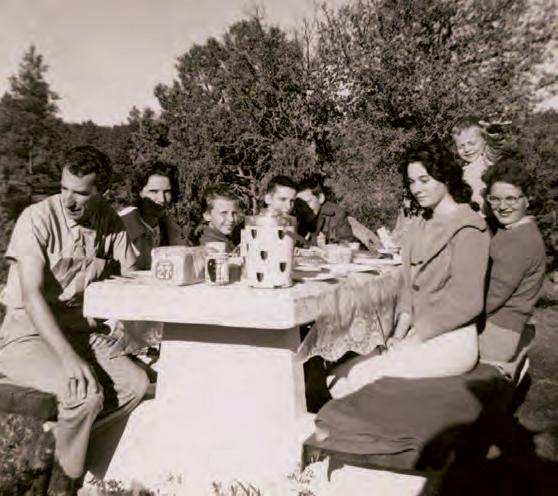

56 READERSDIGEST.CO.UK NOVEMBER 2012



Vincent Furnier, as he was once known, dressed for graduation with his sister Nickie





camera]. Wow, I’d forgotten how much she used to look like Elizabeth Taylor!



…LISTENING TO MY DAD IN CHURCH.












is way more rebellious than anything I’ve ever done on stage! You wanna prove how tough you are? Start telling people you go every Sunday!
…MY FIRST REAL BAND, THE SPIDERS.

My dad was a pastor and we were a religious family. As a teenager, I did all the usual stu that teenage kids do, but I was also involved with the church; that’s where I learned about how the world works. Kids can easily be put o going, but my dad was such a cool guy that he made the idea of church cool, too. Y’see, Dad was also into rock and roll. It was because of him that I fell in love with The Yardbirds, The Who and The Beatles.




People might be shocked by this, but I still go to church. In the rock ’n’ roll business, you hear a lot of talk about rebellion, but let me tell you something: going to church

By 1965, we were starting to get pretty well-known in Phoenix. We used to play at a place called The VIP Club and, man, we would pack it out every weekend. I was maybe 17 years old and I was clearing $200 a week! Back in 1965, that was a hell of a lot of money —more than my dad was making as a designer at Goodyear! This is me with my girlfriend at the time—her name was Debby Hickey—and John Tatum, ►
57 READERSDIGEST.CO.UK NOVEMBER 2012
guitarist with The Spiders. Kids in Phoenix loved that British mod look. We had the Beatle haircuts, the Beatle boots, the thin ties…we were so desperate to be British because all the great bands came from there.
…BECOMING FRIENDS WITH JIM MORRISON

. By the late 1960s, my band had moved to LA, and we eventually changed our name to Alice Cooper. To begin with, nobody in the city wanted to know us, apart from The Doors. Somehow, we met the band and they kind of took us under their wing. We were their punky little brothers! Of course, Jim was a big star, but it was obvious that he hated all the razzamatazz that went with being in a band. He wanted to get out of the spotlight so bad that he kinda had this death wish. Nobody could talk him out of it.
Once, me and Jim were on the roof of this hotel. He was drunk, staggering around the edge of the building. I said, “C’mon, man, you’re gonna fall o .” He really didn’t care. People say it’s a shame that Jim Morrison died at 27. I always say it’s a miracle he even made it to that age.
…GETTING
TO NUMBER ONE. After the band became Alice Cooper, I really started to grow into the character of Alice.

Cuddling up to the Cyclops on the 1975 tour
Welcome to My Nightmare
I guess a lot of people were kinda freaked out by the whole rock-horror thing, but after we had a number-one UK single in 1972 with “School’s Out”, the world started to take notice. By 1973, we were selling literally millions of records, making big money, and that money allowed us to make the band even more outrageous. For our stage show we had blood, Cyclops monsters, guillotines, snakes, axe murders. Of course, the crazier we got, the more the fans loved it!
…WHEN MY WIFE SHERYL SAVED MY LIFE. I have an addictive personality. Unfortunately, addiction and rock ’n’ roll don’t mix. I was an alcoholic for many years…a functioning alcoholic. I was drunk 24 hours a day, but never missed a show. Sheryl is the person that saved me from it. After we got married in 1976, she started
58 READERSDIGEST.CO.UK NOVEMBER 2012
◄ PHOTOGRAPHS COURTESY OF ALICE COOPER
The spoils of fame: Alice with his Rolls-Royce
Some people say it’s a shame that Jim Morrison died at 27. I always say it’s a miracle he even made it to that age
to kick my ass over the drinking. It took her a few years and she even threatened to divorce me at one point, but, eventually, I got some help and cleaned myself up. I’ve been sober for more than 30 years now. We’re still together, and she’s still the most beautiful woman in the world!
…MEETING FRANK SINATRA. In 1977, I was playing at a celebrity baseball game in Las Vegas. I could see this young kid trying to get in to watch the game, so I found
Sheryl, Alice and Calico in 1982 and, inset, the couple today
him a seat on the bench with me and the other players. After the game, two guys stopped me. They just said, “The Boss wants to see you.”
We walked through a couple of doors and there’s Sinatra, Martini in one hand, cigarette in the other. Turns out this kid’s dad was a friend of Frank’s. “Coop,” he said, “I owe you one.” A few months later, I got sent tickets to his show at




59 READERSDIGEST.CO.UK NOVEMBER 2012
the Hollywood Bowl, which is where this photo was taken. [On the left is Cooper’s friend, Bernie Taupin, Elton John’s co-songwriter.] When my

mom saw this photo, she said, “Thank God you’re finally doing something with your life!”
…BECOMING A FATHER.
My first daughter Calico was born in 1981. I’m sure all new fathers will tell you the exact same thing: there’s a switch goes on in your head and you experience a love that you’ve never known before. Sheryl got pregnant about the same time as I was trying to quit the booze, and that gave me an extra incentive to get some help. I wanted to remember what it was like being a father. Quitting drinking gave me a lot of free time, so I filled my days with dad stu —helping with the homework, taking the kids to school and fixing breakfast. And the great thing about being Alice Cooper is that when your kids are playing their music too loud, you can go upstairs and tell them to turn it up!
…GETTING ADDICTED TO GOLF.
If you take alcohol away from an alcoholic, that addict will try and get hooked on
something else. For me, it was golf—and when I say hooked, I really mean that. The first time I hit a ball, I knew I’d found my new drug!

Of course, the great thing about golf is that it actually makes you healthier—I turned 64 this year and I’ve never felt better. People always ask me what I like about the sport and I sometimes find it hard to answer that. I guess it’s all about peace. For so many years, my life has been filled with the chaos of rock ’n’ roll, but when I walk onto the course, it’s just me and the ball: a moment of stillness.
…MEETING LADY GAGA. As soon as I saw her on TV, I fell in love with the outrage. I couldn’t wait to see her show. Last year, we met backstage and she was wonderful. She got down on her knees and did the whole “we’re not worthy” bit from [the film] Wayne’s World. She said, “Alice, thank you for letting me steal your show.”

I said, “Gaga, I created a character called Alice. But it’s
60 READERSDIGEST.CO.UK NOVEMBER 2012
◄

important to keep Alice on stage. I never let Alice take over my real life.” I guess what I was trying to say was, be outrageous for the cameras. Wear a chicken on your head… but don’t get suckered into thinking that stu is real. When you’re at home, just be yourself. If you can learn to co-exist with both Gagas, you’ll be OK.
…PLAYING AT WEMBLEY 40

Be outrageous for the cameras. Wear a chicken on your head… but don’t get suckered
YEARS AGO. I first played Wembley in 1972 at the height of my so-called “shock rock” fame. For the publicity shot, we decided to have a photo of me wearing nothing but a snake. It was taken by [legendary photographer] Richard Avedon; he said that Alice Cooper was art. This image went up in Piccadilly Circus and it stopped the tra c! This year, I’m playing Wembley again. They tell me I’m the first non-British artist to have played there every decade since the 70s. What will you
READER SPOT/B EER O ’CLOCK
I spotted this sign outside a pub in Emsworth, Hampshire, earlier this year. I had to admire their chutzpah, even if I didn’t follow their advice! Submitted by Michael Weston, Brentwood, Essex
see if you come to the show? Oh, you know the kind of thing I like…blood, horror, beheadings, Frankenstein’s monster, giant spiders. Fun for all the family! ■ As told to Danny Scott
» Alice Cooper’s Halloween Night of Fear III tours the UK from October 24. His album Welcome 2 My Nightmare is out now

61 READERSDIGEST.CO.UK NOVEMBER 2012
CA M ERA PRESS /P ETER S HILLINGFORD
THE MAVERICK

6262 READERSDIGEST.CO.UK NOVEMBER 2012
Thinking differently!

“WE
DON’T NEED A FIVE-DAY WEEK”

Working fewer days could boost our productivity, our home life and our society, says business consultant Ian Price
In the midst of the lumbering euro crisis, international lenders recently urged a struggling Greece to work a six-day week in order to revive its stagnating economy. At first glance, this makes sense—something must be done, so why not get everybody to work harder? Surely this will generate more output and be the sought-after fillip to kick-start growth?
And yet a growing number of economists and social scientists suggest this is not the way to go. “The conventional wisdom says that, in hard times, what we need to do is double down and work harder because we’re poorer,” said Juliet Schor, professor of sociology at Boston College, at a recent LSE conference. “That’s the standard view. But it’s a fallacy.”
How about doing the opposite—working fewer days? How about a four-day week? The answer to our economic woes surely lies not in a redistribution of wealth but, as Schor advocates, in a redistribution of paid working time. Indeed, think-tank the New Economics Foundation (NEF) goes further still and calls for a 21hour week, 21 hours being the average number worked each week by all Britons of working age.
63 NOVEMBER 2012READERSDIGEST.CO.UK
► ILLUSTRATED BY NICK LOWNDES
Were this to be mandated, there would, of course, be problems for those whose reduced wages failed to cover living costs, even while there would be a reduction in the benefits bill. The NEF doesn’t suggest forcing the issue; rather, they’d like to create the conditions whereby it can happen over time.
But it need not be a zero-sum game, as is evident from the shining example of the four-day weeks that already exist. In June 2008, the US state of Utah implemented the idea for most of its publicsector workers, who moved from five eighthour days to four of ten hours. While neutral in terms of hours, this shift meant that staff spent one day fewer travelling to and from work. One year on, reductions in overtime and absenteeism were calculated at more than £2.5m, with big falls in carbon emissions and petrol consumption.
A three-day weekend would improve our mindfulness and mental energy, leading to improved quality of output
His firm makes upwards of £1.8m in annual revenues, and finds recruiting and retaining talented employees easier than ever. Facebook has repeatedly tried to poach Carson’s staff. “Do you work a four-day week yet?” is the question that usually ends the dialogue. Crucially, Carson gets to spend a three-day weekend with his kids. Yet his business is clearly not just about lifestyle —he’s raised some £3m from investors.
The point about productivity for information workers is a critical one. We’re no longer in manufacturing, where more is better. And yet, when at work, it often feels like it. We attend interminable meetings and conferences while firing off innumerable emails. Addled and distracted, our brains’ ability to engage in any deep thinking is hugely impaired. A three-day weekend would improve our mindfulness and mental energy, leading to improved quality of output.
Is this something only the state can do?
Refreshingly, there are signals of a likeminded approach in the start-up sector.
Florida-based serial entrepreneur
Ryan Carson, founder of online webdesign-tutorial provider Treehouse, has his whole firm work a four-day week—Monday to Thursday, nine to six, “because we think that information work isn’t like manufacturing”.
Ryan Carson’s treasured time with his children is surely where the greatest benefits of the four-day week lie. While Save the Children rails against “child poverty”, is this really just about money? Former GP Anthony Daniels wrote in The Daily Telegraph recently of homes he’s visited that were awash with flat-screen TVs. While only a short distance from Indian shops selling fresh
6464 READERSDIGEST.CO.UK NOVEMBER 2012
◄
vegetables “so cheap that you could hardly carry away all you could buy for £10”, these homes contained no evidence of cooking other than reheating prepared food in a microwave.
Would a four-day week work for you?
Join the debate at facebook.com/readers digestuk or email readersletters@ readersdigest. co.uk
This isn’t so much about relative wealth but about absolute parental time poverty, something equally true at the other end of the socioeconomic scale. Clarissa Farr, first mistress of £18,000-a-year St Paul’s Girls’ School in London, describes a culture of “ultra-working” that leads to parental neglect among the uppermiddle class, too.
The four-day week would free up a day for caring—for elderly relatives as well as for children. The additional time would allow us to give proper attention to our own and our children’s diets, replacing takeaways and frozen meals with freshly cooked food. Obesity and
its consequences, such as diabetes, could be reduced with further savings for the public purse. With a greater parental presence in their lives, kids would be less likely to riot or drift out of education. Best of all, the four-day week would free up time for volunteering, capitalising on the Olympic spirit and genuinely ushering in the Big Society.
If the four-day week strikes you as appealing, but seems like a distant dream, fear not—there are some influential recent recruits to the cause. In June this year, MPs put forward a proposal that the House of Commons sit from Monday to Thursday. It’s not law quite yet, but watch this space.
» Ian Price is founder of Grimsdyke Consulting and author of The Activity Illusion (£13.99)
HOW DID LLOYD GEORGE DODGE A BULLET?
Well, actually, it was a poisoned dart, fired at him while he played golf. Or, rather, that was the plan devised by the Wheeldon family to knock o prime minister Lloyd George, during the “spy mania” panics of 1917.
But enter undercover spy Herbert
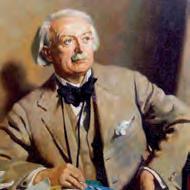
Lloyd George: not poisoned, thankfully
Booth, who conned his way into the circle of villains by claiming he was in a radical outfit called International Workers of the World. Booth discovered the gang’s code, used in letters to other agents, and based on the sentence,



Questions from history answered



“We’ll hang Lloyd George on a sour apple tree.”
Ma Wheeldon, head of the mob, showed Booth pellets full of strychnine and curare. The family was nabbed, and Ma ended up with ten years’ penal servitude. It was one of British Intelligence’s first coups.
Stephen Wade


65 NOVEMBER 2012READERSDIGEST.CO.UK

Best of Brıtısh



 BY LOLA BORG
BY LOLA BORG







Cine
Cynics predicted the death of cinemas, but they were wrong. Thanks to recessions and bad weather, business is booming.
And what could be better on a chilly night than a trip to the local? Here’s our pick of the most enticing

►






mas 67
MOST CIVILISED
The Rex, Berkhamsted, Hertfordshire
“Every public building should be this special,” they say, and they’re not wrong. Housed in a lovely art-deco cinema for starters (with original proscenium arch), it’s been dubbed the most beautiful cinema in the UK.
There’s a varied programme with di erent films every night—a mixture of high- and lowbrow, plus blockbusters. And there are some nice touches. Hotdogs and popcorn are banned—instead, you take drinks and nibbles on a plate back to a little table next to the seat. And a real person answers the phone when you call.


The Rex is held in such high esteem
BEST FOR TAKING PART
Secret Cinema, London

done Q&A sessions—Charles Dance, Dame Judi Dench, Alan Bennett…the list is endless. Do go, if only once, to see just how a cinema should be run. Visit therexberkhamsted.com or call 01442 877 759 (people travel for miles to come here, so book in advance!)
Everything is a secret—the location, the venue, the film itself. The only thing you know in advance is the price (around—gasp! —three times the price of a local multiplex). But
if you’re in London, you’re feeling reckless and you want something more than the usual trip to the flicks, see the website for details of the next event. Visit secretcinema.org
Keep your ear to the ground for the Secret Cinema (you can bring your own New York police car, it seems)







THIS ARTICLE WAS INSPIRED BY THE FOLLOWING TWEET

raghavmodi Raghav
@rdigest Independent cinemas of the UK. There are quite a few and good ones. #RDTwissue

68 READERSDIGEST.CO.UK NOVEMBER 2012
BARNABY STEEL/THEFOUNDCOLLECTIVE.COM
ROBERT STAINFORTH/ALAMY (OPENING SPREAD)

BEST MODERN
The Broadway, Nottingham
A cinema has been here since the 1960s, when local fashion designer Paul Smith (below) would come to see arty foreign films—something, it’s said, that heavily influenced his career choice. Later, he designed the stripy sofas for Screen Four. The Broadway was previously a Wesleyan chapel (Salvation Army founder William Booth had his Damascene conversion on the site where Screen One now sits), but locals love it for its independent, art house, DIY spirit. Revamped and given a spangly glass frontage in 2006, the Broadway also has a right-on restaurant—with locally sourced vegetables and salads—and even serves its own beer (Broadway Reel Ale…geddit?). As far as movies go, it mixes art house and mainstream over four screens. Rightly, a Nottingham institution. Visit broadway.org.uk or call
0115
952 6611

►


69
MOST QUIRKY
Kinema in the Woods, Lincolnshire
It’s a wooden cricket pavilion on the outside and a two-screen cinema on the inside, all nestling among pine trees in a tiny spa village. The Kinema showed its first film in 1922 (a Charlie Chaplin silent), and the first six rows were deckchairs. Today, it’s more lavishly decorated, with film knick-knacks in the foyer and a Compton organ in the auditorium that rises from the ground.

“People come here because it’s a fantastic experience,” says manager Philip Jones. “Many multiplexes are sterile, but we try to retain everything that makes cinema special.”
The Kinema holds Christmas singalongs on the first Sunday in December with renowned organist Robert Woolfe. Expect “90% mainstream films”, they say, but with some classic nights and regular organ recitals during the interval on a Saturday night. Visit thekinemainthewoods.co.uk


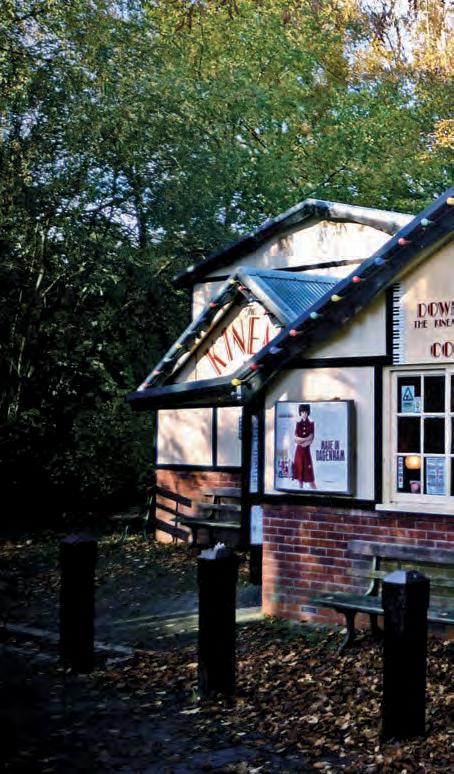
BEST FOR HIPPIES

Bristol Cube
You have to hand it to them for going against the grain. The Cube couldn’t be more di erent from a local multiplex (they call themselves a “microplex” for a start). In fact, it’s not really an independent cinema—more of an “anarchic collective” it’s


 A model of Charlie Chaplin stands in the Kinema foyer
Bristol Cube: the revolution will not be projected in 3D
A model of Charlie Chaplin stands in the Kinema foyer
Bristol Cube: the revolution will not be projected in 3D

(their words), a not-for-profit cooperative run by volunteers, which has been operating for the last 15 years in the Stokes Croft area of Bristol (famous for the anti-Tesco riots last year).
They are “unique for what we do, which is operate seven nights a week and with no funding”.
Ethical? You bet. They make their own cola, import “feral trade”
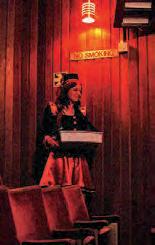
co ee from El Salvador, and probably knit their own yogurt, too. Just don’t expect anything in 3D (although they do have an accessible list of screenings and plush seats). Entry is free for asylum seekers and refugees. Come the revolution, more cinemas may work this way. Visit cubecinema.com or call 0117 907 4190 ►
71 NOVEMBER 2012READERSDIGEST.CO.UK
Reels on wheels: the Screen Machine trundles to a screening at Eilean Donan Castle in the western Highlands


BEST SCENESTEALER
Screen Machine, Scotland
It’s a novel idea: a mobile-cinema unit in a thumping great articulated lorry that brings local multiplex fare to towns and villages in the remote Highlands of Scotland. It’s got 88 comfy seats and air con (would you need that in the Highlands?). There are no loos, but they promise to park near some. Take your own snacks. Visit screenmachine.co.uk

BEST LOCAL
Duke of York, Brighton
It’s been voted the best local cinema in the UK, and is instantly recognisable from the saucy can-canning legs (see picture). Local patron and singer/screenwriter Nick Cave says this Edwardian gem is “one of Britain’s truly great independent cinemas”. When it first opened in 1910, its tagline was “Bring her to the Duke’s, it is fit for a Duchess”. Shabby chic was its trademark for many years—it was even a bingo hall for a while—but it’s just had a refurb and now has extra-comfy seats. Visit picturehouses.co.uk/cinema/duke_ of_yorks or call 0871 902 5728
72 READERSDIGEST.CO.UK NOVEMBER 2012 HIGHLANDS AND ISLANDS ENTERPRISE/EWAN WITHERSPOON (ABOVE)
The Tyneside cinema owes a debt to the Scott dynasty: (from top) great-uncle Dixon, Ridley and Tony


BEST OF OLD AND NEW
Tyneside Cinema, Newcastle upon Tyne
This is a classic 1930s picture house that’s been given a sleek interior restoration. Originally a newsreel cinema (built by a great-uncle of director Ridley Scott and his late brother Tony), the Tyneside hit the skids in the 1960s and 70s.
“What did for cinemas was partly the onset of TV, but also the fact that pubs started to become more womenfriendly,” says David TrevorJones, chairman of the Cinema Theatre Association.
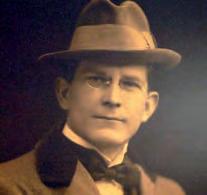
Tyneside’s three screens now boast state-of-the art equipment. Events range from baby clubs to vintage-footage screenings, shown free every day at 11.30am.



year—and local families
With thanks to: David Trevor-Jones, chairman, Cinema Theatre Association (which works to preserve Britain’s cinemas); Robin Duval, ex-director of the British Board of Film Classification and author of Bear in the Woods and Below The Thunder; and Jon Williams of The Heritage Lottery Fund.
screen you rush to
Is there a particular screen you rush to on a Friday night? Or any night, for that matter? Then we’d love to know about it. Send us an email—with a picture if possible —to theeditor@ readersdigest.co.uk

Saved by a £7m revamp in 2006, the

The 1930s co ee room is “always heaving”, with a bar serving themed cocktails. But the highlight of the year—and local families rave about this—is the annual Christmas screening of It’s a Wonderful Life, shown in the Classic Cinema, which even has an oldfashioned curtain. Visit tyneside cinema.co.uk or call 0845 217 9909 ■

Saved by a £7m cinema.co.uk or call
NEXT MONTH: QUIRKY SHOPS
73 NOVEMBER 2012READERSDIGEST.CO.UK
2012
A LEGEND IN ITS OWN TEATIME
How Countdown became a 30-year-old mild-mannered TV cult
 BY DANNY SCOTT
BY DANNY SCOTT
It began quietly at 4.45pm on November 2, 1982, the first programme on the launch day of Channel 4—watched largely by an audience of pensioners, children after school and students. And it’s continued in much the same way ever since. But 5,600 episodes later, Countdown celebrates its 30th birthday this month. So how has an intellectual words-and-maths quiz, famed for its occasionally naff humour, endured for so long?
IT BRINGS PEO P LE TOGET HER
“These days, it’s easy for four or five members of the same family to be under one roof and yet all be doing different things,” says former Countdown champion— and now series producer—Damian Eadie. “Laptop, TV, Xbox, mobile…there’s no interaction. But almost every contestant and audience member I talk to on the show has played Countdown with another member of their family.” Eadie, 43, who became a researcher on the show after triumphing in the 1994 ►

Images from the first-ever episode. In case it’s bothering you, the solution to the numbers board is: 10 + 7 = 17; 50 – 1 = 49; 49 x 17 = 833
C RAIG P. JEWELL/FLIKR RF/GETTY IMAGES; CHANNEL 4 75
final, used to challenge his father and older brother to games. “It became our thing,” he remembers. “No matter what else was happening, we’d sit down and play. We weren’t just staring blankly at soaps—I’d constantly be discussing words with my dad. I’ve since met hundreds of other families who gather round the TV like we did.”
“There are certain shows that have gone down in student history,” reckons the National Union of Students’ deputy president Toni Pearce. “Obviously, you’ve got the likes of Home and Away and Neighbours, but Countdown is right up there. Yet its appeal is very different. Lots of students will have played along at home—like I did—and I think they like its cross-generational approach. And I’ve heard stories of Countdown
CELEBRITY FANS
EDWINA CURRIE, AUTHOR AND POLITICIAN
“I went on the show in 1998. My mum Pese insisted—she absolutely adored Countdown.
From 1982’s first episode to the day she died in 2004, none of the family was allowed to ring her when it was on.
student societies being set up, where members constantly compete against each other and try to get on the show.”
IT IMPROVES US
“Education is never far from the headlines,” says Susie Dent, Countdown ’s lexicographer and Dictionary Corner resident. “And in this show you’ve got a programme that’s about the fundamentals: maths and English. Countdown isn’t scared of language, or of complicated or uncommon words—it brings them into the public arena.”
Susie, 45, says the production team frequently gets letters from viewers saying that their children learned their letters through watching it and, from there, began to build their own words.
Indeed, even Susie, an Oxford graduate


“She was very good at it, too. Mum came from a very poor, working-class background in Liverpool. She had brains, but she had to leave school at 14 and get a job. Her brother had won a scholarship to college, but there was only enough money for one of them to go. It was Mum who always pushed me to get a decent education…she always said I had brains and I ought to do something with ’em!
“Sadly, my appearance on Countdown didn’t impress her. She kept saying, ‘They should have invited me on. I’d have showed ’em!’ ”
JON CULSHAW, IMPRESSIONIST AND COMEDIAN
show [Jon appeared last year],
“Countdown is just one of those programmes that puts me in a good mood. Someone asked me what it’s like being on the show [Jon appeared last year], and I said, ‘It’s like going round to your favourite aunt’s house for a nice cup of tea.’ I’m not sure if they understood what I meant by that…I was just trying to get across what a warm, friendly atmosphere there is.
It feels tremendously inclusive. The audience, the guests and the fans feel like they’re part of the family.
“A very particular type of
76 READERSDIGEST.CO.UKNOVEMBER 2012
◄
in modern languages who used to work for Oxford University Press, finds the show an eye-opener.
“A contestant came up with a word recently…boilover. It’s from Australian/ New Zealand English, and it means a shock sporting defeat. It’s not a particularly beautiful word but, in more than 20 years of studying language, I’d never heard of it.”
“What I really admire about the show —this should appeal to Michael Gove!— is that the standards have never altered,” adds Toni Pearce. “Students like the fact that it’s genuinely challenging.”
IT’S REAL AND REASSURING
“If someone went to a modern TV executive with the idea for Countdown, it wouldn’t get made,” reckons Lynne

humour works when you’re on there. A bit of ribbing, a few anecdotes and merry little tales. Certain voices, too. Les Dawson and Michael McIntyre always go down well. I’m thrilled that it’s still here—as long as Countdown’s on, you get the feeling that all’s right with the world.”
Truss, author of grammar bible Eats, Shoots & Leaves and a former Times TV critic. “They’d want more drama… they’d want public votes for the most interesting words. Thank God Countdown refuses to go down that route. You could say that it’s fighting a rearguard action for straightforward quiz shows, free from that cynical manipulation of the viewer.”
The continued success of Countdown has paved the way for other glitz-free quiz shows, such as BBC Four’s surprise hit Only Connect and Alexander Armstrong’s Pointless.
“The fact that Countdown has been on for 30 years—an amazing run—and its format has hardly been touched is proof that not everyone wants bells and whistles, manufactured melodrama
SIR TERRY WOGAN, BROADCASTING LEGEND
“I’ve been watching the show since those wonderful days when Richard and Carol [Vorderman] ruled the roost, and I still enjoy the charms of Nick Hewer and Rachel Riley. To my delight, I’ve been invited onto a show in the past [as a Dictionary Corner guest], but as an armchair contestant I’ve never been more than a fiveor six-letter man. It’s one of those programmes that will sprain the brain once in a while, but it always seems to provide relaxing afternoon entertainment.”

►
THE SECRET WORLD OF
COUNTDOWN
● Earlier this year, a female contestant had to be sent back to the dressing room because her cleavagefriendly outfit wasn’t suitable for daytime TV.
● Actor Sir Anthony Hopkins rang the studio in 1994 to discuss a word he’d heard on the show. Other reported celebrity fans include Sir Alex Ferguson, Liam Gallagher, Amir Khan, Julie Andrews, Stephen Fry, Gordon Brown, and the Queen—who sent a message of congratulation to the show’s 5,000th episode.

show. Recently, recording had to be stopped when she was standing next to the word GROWLERS— a slang term for a lady’s private parts!

● The clock is the same one that appeared on the very first show. It’s malfunctioned just twice in 30 years.
● The Countdown clock music has played more than 60,000 times. That’s 1.8 million seconds—some 20 days of music.
● In 2007, one contestant was caught cheating. He claimed he’d cracked the maths round in the same way as his opponent— but when he was asked to show his workings, his solution was nowhere near the target number.
● Current co-host Rachel Riley’s giggles have to be edited out every time a rude word appears on the
end-of-show conundrum, the presenter asks if anyone in the audience has got it, and they receive a Countdown mug if they’re right—and appear on TV. On this occasion, one lady said she had her hand up first, but her disputed claim led to an expletiveladen argument with other audience members.
● Countdown teapots change hands for threefigure sums on eBay.

● Out of around 5,000 contestants to have appeared on the show, only two have failed to score—one man in 1987 and one woman in 1998, in case you’re wondering.

● There have been 250 di erent celebrity guests, including Ernie Wise, Kenneth Williams, Mo Mowlam and Jon Pertwee.
man in 1987 and one mug! If
● Last year, the show’s producers had to break up a fight over a Countdown neither contestant has solved the



and wannabe contestants,” says Truss. “All you get if you win Countdown is kudos and a teapot!”
IT’S FU NNY—BUT NOT SHARP
Many modern comedy and quiz programmes go for the jugular. The humour can be controversial, rude and even vicious. But, says stand-up and occasional Dictionary Corner guest Dave Spikey, you’ll find none of that on Countdown.
“There do seem to be a disproportionate number of comedy shows on TV that set out to shock,” he says. “Don’t get me wrong—I’m full of admiration for political comics like Mark Thomas, or surreal stuff, but we’ve forgotten TV’s mainstream comedy audience.”
Countdown is stuffed with wordplay, anecdotes and little in-jokes. The word “leotard” always raises a cheer when it appears on the show, for instance, because the late Richard Whiteley—Countdown anchor from 1982 to 2005—repeatedly informed viewers that the stretchy item of clothing was invented by French trapeze artist Monsieur Léotard.
“Some comedians will turn their nose up at it,” continues Dave, “but Countdown is a funny show. The humour is smart without being too clever, and it never
R EADE R SP OT/ DISASTE R DIAL
This is a photo of the emergency telephone at Sea Palling in Norfolk. The phone only comes equipped with the numbers 1, 2 and 3, which renders the sign underneath slightly redundant!
Submitted by Steve Bunce, London
HOW TO ACE THE LETTERS GAME
► Pick four vowels. This gives the greatest choice of words, while still providing a challenge to your opponent.
► If you can, discard the likes of W, V, F, Y, Q and J, and concentrate on common consonants such as R, T, N, L, P and S, which you’ll find in lots of words.
► Find the consonants that go together. C and K, as in TRICKLE, say. Don’t forget endings: I, N and G, as in FINDING; E, S and T, as in TALLEST; L, E, S, and S, as in WITLESS. Or compound words—DARK and ROOM give you DARKROOM, for example). Remember prefixes: (OVER and USED, gives OVERUSED).
► Experiment with some of the classic seven-letter words that appear on the show, and see how you can add to them. Let’s take RETAINS. Add a P and you’ve got PERTAINS. Replace the P with a U, reorder the letters and you’ve got URINATES.
Damian Eadie
gets personal—you’re not always looking for someone to be the butt of the joke. Modern comedy is a big enough umbrella, so I’m glad Countdown’s still here.” n

79 WITH THANKS TO C OUNTDOWN P RODUCER D AMIAN E ADIE
◄
WORD STORY
After launching our third annual 100-wordstory competition last month, we thought we’d whet your appetite further with three more stories from professional writers, written exclusively for Reader’s Digest. If these get your creative juices flowing, follow the details opposite on how to enter*
Cathy Kelly
Even the table looked sad, Daisy thought miserably. Asymmetrical. Three place settings instead of four.
“Darling, I can’t come tonight. Mother’s not well, you know how it is…” Nick had said on the phone.
Daisy knew. Mother had been sick for their trip to Paris and for the Vivaldi recital.
Nick’s mother, she realised, would always win. Always.
Daisy phoned Carole, who said she and Mark were looking forward to the dinner party.
“It is still on…?”
“Of course.” Daisy hesitated. “Any chance Mark’s brother would be free tonight? It’s just I have a space at my table…”

WIN £1,000!


▪ Cathy Kelly’s latest book The House on Willow Street is published by Harper Fiction in paperback at £7.99

ISTOCKPHOTO.COM 1
*And see readersdigest.co.uk/magazine for the rules
Philip Kerr
“Don’t look now,” said Laura, “but that old girl’s been staring at you ever since we came into this restaurant.”
Before the elderly woman left, she stopped by our table.
“Excuse me, but you look just like George Clooney.”
Later, I went for a run through the Venice streets. Despite Laura’s mocking laughter, it wasn’t so bad to be compared with Clooney, was it?
Trying to ignore the heat, I pushed myself hard.
As I finished, I caught a glimpse of a red-faced, wizened old man, and realised to my horror that it was my reflection in a shop window.

▪ Philip Kerr’s new novel Prague
Charlie Higson
Bored of doing evil, the devil went on holiday. Sitting on the beach he noticed God on the towel next to him, slapping on sun cream.
“Are you on holiday, too?” God asked. “Brilliant, isn’t it?”
That night they got drunk together and found they had a lot in common.
After two weeks they went home, but the devil discovered he’d been locked out of hell.
He texted God who told him he’d found a note from mankind pinned to the pearly gates.

Fatale is published in paperback by Quercus this month



HOW TO ENTER:
▪ Please send your stories —which should be original, unpublished and exactly 100 words long—to 100word story@readersdigest.co.uk by January 31, 2013.
▪ There are three categories —one for adults, and two
“They reckon they can get along perfectly well without us,” he said. “So I’ll see you back on the beach.”
▪ The Sacrifice, the fourth book in Charlie Higson’s The Enemy series, was published by Pu n in September at £12.99
categories for schools: one for children aged 12–18, and one for children under 12.
▪ In the adult category, the entry voted best by our panel of judges will receive £1,000, and two runners-up will each receive £100 in book tokens.
▪ In each of the school



categories, the prize for the winner is £500 of high-street vouchers of their choice, and £500 for their school. Mark each entry either “Adults”, “Schools 12–18 category” or “Schools under-12 category”. Winning entries will be published in a future issue. ■
81 NOVEMBER 2012READERSDIGEST.CO.UK ANDY PARADISE (HIGSON)

82
The Forgotten Temple
Meet the British man determined to restore a magnificent temple in the Cambodian jungle—and turn it into a tourist attraction with a di erence

WORDS AND PICTURES
BY CRAIG STENNETT
A LIFE LESS ORDINA RY
83

Bumping along a dusty pot-holed track in north-western Cambodia, my driver says, “This is only the second time in 15 years that I’ve been asked to go to Banteay Chhmar—and the last time was ten years ago.” We’ve left behind the tarmac road of Siem Reap, one of Cambodia’s major cities, and turned onto what is rather optimistically called Highway 56. Our destination is the remote and littleknown crumbling temple complex of Banteay Chhmar, hidden deep in the jungle, four or five suspension-wrecking hours away.
Banteay Chhmar (pronounced Ban-tay She-mar) is one of the last great untouched temples in Cambodia. Built by King Jayavarman VII in the late 12th or early 13th century, it was left for hundreds of years to the ravishes of time, monsoon seasons and the advancing jungle. But
Statues of gods and demons line the temple’s causeway.
Bottom right: the site was only cleared of landmines a few years ago

now, thanks to the Global Heritage Foundation (GHF), the temple is being restored with the Cambodian people.
Essential to the restoration is John Sanday OBE, a remarkable British architect and conservationist who regards Banteay Chhmar as one of the great architectural masterpieces in southeast Asia.
Sanday, the GHF’s regional director for Asia, studied architecture at Bristol University. He went to Nepal on a Unesco contract in 1970, then moved his wife and first son to Kathmandu in 1972, and has lived there ever since. He’s dedicated his life to preserving cultural buildings and monuments all over Asia, including monasteries in the Himalayas and palaces in India. From 1999 to 2006 he worked at Angkor Wat, Cambodia’s most famous temple. But whereas an estimated 7,000
►
84 READERSDIGEST.CO.UKNOVEMBER 2012
◄





Labour of Love
John
stonemasons
The tarpaulin
them from the blistering temperatures
38C. Fans are also used against the heat, and to disperse the dust created by the constant chiselling. “The Khmer stonemasons have an a nity with the stone,” says John. “They’re always touching it, feeling for the accuracy of the join.”
85
Sanday advises
at the temple.
protects
of
tourists a day descended on Angkor Wat in 2011, barely 700 a year make the challenging journey to Banteay Chhmar. A long overdue road is expected to be completed next year, and that, plus the restoration, might bring the 800-year isolation of this temple to an end.
Standing at the southern entrance of the temple, a causeway over the lotuschoked moat that encircles the complex, John says: “Most tourists have a dream
of visiting Cambodia and walking alone around an ancient historic city in the middle of the jungle. We hope we’ll be able to keep some of that romance alive here at Banteay Chhmar.”
Although he’s in his sixties now, he nimbly weaves his way over the piles of fallen stones, while sharing his vision for the site: “I’d like to preserve it as a partial ruin with low-impact and safe visitor access via suspended platforms over the fallen structures.”
►

a simple peasant. It was a terrible time—you never knew if you were going to live from one day to the next, and there was constant hunger. I learned not to hope for anything.”

John’s Right-Hand Man

MOK NGAM, 68, has worked alongside John Sanday for the past 14 years. Trained as a stonemason, Mok had to abandon his way of life when the Khmer Rouge, led by Pol Pot, gained power in Cambodia in 1975. The Khmer Rouge was suspicious of any citizen who was educated, spoke a foreign language
or was otherwise skilled. Even the wearing of reading glasses was deemed to be enough of a sign of intellect to warrant suspicion.
To survive, Mok was forced to move with his wife and two children 20 miles from where he’d been working. “No one knew me there,” he remembers. “I said I was
Mok lost both his parents, his older sister and brother-in-law during the Pol Pot regime. His son was injured in 1980 by a landmine explosion, losing an arm and a leg.
The restoration of the temple has been hindered because very few skilled Cambodians survived the Khmer Rouge. “I never thought I’d be able to work with stone again,” Mok confides. “Or be in the position to train young Cambodians and pass on my skills.”
86 ◄ READERSDIGEST.CO.UKNOVEMBER 2012
◄



Solving John’s Puzzle
The hard, physical work of restoring the temple is di cult enough, but one of John Sanday’s biggest problems is figuring out what bit goes where. Incredibly, his solution is to use sophisticated technology in the middle of the jungle. A tent on the site is filled with a ghostly green light—this is the laser-scanning area, where high tech and low tech meet. Using a simple block and tackle (pictured below), workers manhandle fallen stones from one of the temple’s towers, weighing probably half a ton, into the tent. Once the stones are safely inside, an intense green laser beam runs over their surface, covering all angles. State-of-the-art 3D camera technology is used to scan the stones, then the minute measurements are entered into a database by 28-year-old information technology operator SIN LOUETH.

The technology as well as the training of the all-Khmer computer crew was provided by the Interdisciplinary Centre for Science Computing at the University of Heidelberg in Germany. The data from Banteay Chhmar is sent to Heidelberg, where a team of specialists dedicated to “solving John’s puzzle” use a computer program that takes the information and reassembles it into a 3D-model that predicts how the temple tower once stood.
87 NOVEMBER 2012READERSDIGEST.CO.UK


Unique to Banteay
Chhmar was a set of eight wall engravings— like the one shown here—depicting Avalokitesvara (a revered Buddhist figure). Four of the panels were stolen during the 1990s and taken to Thailand to be sold. But two of the engravings were intercepted and are now kept in the National Museum in the capital, Phnom Penh

◄ They know what they’re doing now.”
Passing a tumbled-down shrine to our left, he tells me about its gruesome history: “Looters thought precious stones could be found inside. Their bodies are still in there—the temple collapsed on them. There were no survivors, and there was no way of getting the bodies out at the time, so they were simply left. Some of the locals believe the looters’ spirits still haunt these grounds.”
John is certain that he does not want Banteay Chhmar to mimic Angkor Wat, where mass tourism has damaged the temples and jeopardises the site’s very survival. Instead, he believes that properly managed sustainable tourism can bring economic and social benefits to rural communities. One of his main aims is to involve local people at all stages. He hires people from nearby villages and trains them into a skilled workforce that can maintain and manage the site. “I’m proud of the guys working here,” John says. “I’ve trained them and they can manage themselves.
There are no hotels or guest houses in the area, so tourists will stay with local families and eat with them, sharing what is still largely an agrarian way of life. The restored temple will be at the spiritual heart of the community.
“We need 5,000 people every year to visit and stay with our community to break even and run our project without outside funds; 10,000 people would be better,” says Sophal Tath of Community Based Tourism, which promotes responsible tourism in Europe and the developing world. “The community knows how important the temple is to us and our future livelihood.”
It’s also considered “best practice” by GHF that the benefits of the site should be clear to those who live there, since only then will they become drawn in to the preservation of the temple, and return to being its rightful guardians.
As John Sanday says, “It is the local people who will ultimately ensure the temple’s future and preservation.” ■
88 READERSDIGEST.CO.UKNOVEMBER 2012

















festive food (with a twist)
Tired of serving the same old Christmas dishes? Try some of these quick-but-delicious ideas instead
christmas day made easy
l Give your veg a kick by adding 2 cloves of garlic, 6 juniper berries and 3tbs of gin to 500–700g of savoy cabbage. Juniper spirits such as gin are said to help build up a resistance against flu and provide relief from overeating—both of which are pretty common around Christmas!

l Try accompanying your Christmas turkey with green beans mixed with toasted almonds. Or impress your diners with a purée of parsnip and pumpkin, buttered well and seasoned with nutmeg.
l If you’re serving soup during the festive period, stir a little horseradish sauce into it for an instant warming heat.
l For the best roast potatoes, crisp on the outside but meltingly soft inside, use Désirée or Maris Piper potatoes, and cook them in hot lard or goose fat. For a vegetarian version, use good vegetable fat. Parboiling them and then shaking them well before roasting roughens the surface and helps to make them extra crunchy. Roast for 45–50mins, turning once.
TIP: Keep potato pieces an even size. Make sure each piece is completely covered with fat when you baste.

FABFOODPIX.COM; J SHEPHERD/PHOTOGRAPHERS’S CHOICE/GETTY IMAGES
✰ ChrIsTMas Food sPeCIal

The PeRFeCT SauSage STuFFing...
Mince, or buy, 100g of belly pork. Then chop 2 shallots and mix with 100g of breadcrumbs, the minced pork and 675g of pork sausagemeat. Beat 1 egg and stir into the stuffing to bind. Season to taste and cook next to the turkey for 30–40mins.
l Put the turkey giblets (not the liver) in a saucepan with 1 bay leaf, 1 peeled onion stuck with 4 cloves, a few sprigs of parsley, 6 peppercorns, and 1tsp of dried thyme. Cover with 1 litre of water and bring to the boil, then lower the heat and simmer for an hour. Strain and reserve the stock. When the turkey is cooked, pour off almost all the fat from the roasting tin, add 4tbs of plain flour to the roasting tin and blend it into the fat with a wooden spoon, scraping as much sediment from the bottom of the tin as possible.
Cook the roux for 1–2mins, then slowly whisk in the reserved stock and 4tbs of port. Simmer for 15mins. Taste and season, before pouring into a warmed sauce boat.
l When the cooking time is up, stand your turkey on a warm serving platter in a warm place for at least 15mins. This allows the fibres of the meat to firm up, making it easier to carve.
l stop your Christmas day white sauce from forming a skin by either sprinkling the surface with caster sugar or pressing a piece of dampened greaseproof paper over it.
l leftover turkey? Turn it into a delicious stew or casserole (below). Just boil it with stock, carrots, onions, mushrooms, potatoes—or any of your leftover vegetables. Or turn the stew into a fricassée by adding cream or milk.

…anD
gRavy
ELSING/PHOTODISC/GETTY IMAGES; HUW JONES/PHOTOLIBRARY/GETTY IMAGES

party, party
Give your guests a break from too many carb-heavy meals by serving Waldorf salad. Combine 2tbs of lemon juice, 1tsp of caster sugar and 1tbs of mayonnaise in a bowl for the dressing. Core and dice 3 red apples, toss them in the dressing and let the mixture stand for 30mins. Wash, core and thinly slice another red apple, then dip the slices in the dressing, and set aside. Scrub and chop half a head of celery and chop 50g of walnuts, then add them to the diced apples, with an additional 8tbs of mayonnaise. Mix well. Wash and shred a lettuce, and line a serving bowl with the leaves, before piling the apple, celery and walnut salad into the centre, garnish with the apple slices. Serves 6.
ReaDy reckoner
l Canapés. allow 4 pieces per person to accompany drinks before dinner; 12–15 per head for a 2-hour cocktail party.
TIP: Canapés are simply bases with toppings—for a lighter option put the toppings into sticks of celery or red pepper, crisp lettuce or chicory, or fruit, such as dried apricots.

l For economy, serve a sit-down meal— quantities are easier to calculate than they are for a buffet.
l Buy wine in bulk on a sale-or-return basis, and ask for free glass hire. on a budGeT?
l Food. allow around 700g food per person in total for a 3-course main meal. For a dinner or lunch, serve a main course consisting of around 200g protein such as meat or fish, 125–150g of carbohydrate and a remaining 125–150g of accompanying vegetables.
l drinks. a 75cl bottle of wine will yield six small glasses. Calculate on the basis of 3 to 4 glasses per person for a 2-hour evening meal or a celebration lunch.
TIP: For soft drinks such as orange juice, allow about 400ml per person for a drinks party lasting 2 hours.
93 november 2012readersdigest.co.uk
✰ ChrIsTMas Food sPeCIal ► FABFOODPIX.COM; GASTROMEDIA/ALAMY
soufflÉs with lesley waters

I love a truly traditional Christmas. Mulled wine and mince pies on Christmas Eve, smoked salmon and scrambled eggs on Christmas morning… A big bird, stuffing, roasties and all the trimmings for lunch… Food glorious food and lots of family and friends to share it!
But I also like to keep it simple, and after the full-on feast of Christmas Day these lovely little soufflés are a real treat. They’re great for using up any leftover cheese, and can be prepped in advance and re-baked before serving, leaving you time to enjoy a glass of fizz with your guests. I recommend serving them with a crunchy celery and apple salad.
Tv chef lesley Waters runs a cookery school in the heart of the West Dorset countryside. visit lesiey waters.com for full details
RiCh CheDDaR SOuFFlÉS
(serves 6)
300ml milk
1 sliced onion
Pinch nutmeg
1 bay leaf
45g butter
45g plain flour
1tsp grainy mustard
55g mature cheddar cheese, grated
55g Parmesan cheese, grated
3 large eggs, separated Salt and freshly ground black pepper
200ml double cream
1. Preheat the oven to 180C/350F/gas Mark 4.
2. Place the milk, onion, nutmeg and bay leaf in a saucepan and gently heat. Remove the pan from the heat and set on one side to infuse for 30mins, then remove the onion and bay leaf.
3. in a second saucepan, melt the butter. Stir in the flour and gently cook for 30 seconds. Remove the pan from the heat and gradually whisk in the

milk until smooth. Return the pan to the heat and stir until the sauce boils and thickens.
4. Remove the pan from
94 readersdigest.co.uknovember 2012 ◄

the heat and stir in the grainy mustard, three quarters of the cheeses and the egg yolks. Season well.
5. generously butter 6 ramekins.
6. in a large bowl, whisk the egg whites until stiff. Carefully fold the whisked
whites into the cheese mixture and fill each ramekin until two-thirds full.
7. Place the ramekins in a roasting tin of boiling water and bake in the oven for 15–20mins or until the mixture is cooked.
Remove the ramekins from the tin and cool.
8. When ready to serve, preheat the oven to 220C/ 425F/gas Mark 7. loosen the edges with a knife and turn out, upside down, into a shallow ovenproof dish. Sprinkle with the remaining cheese and pour over the cream.
9. Place in oven for around 10–12mins until the soufflés are puffed and golden. Serve at once with celery and apple salad (go to readersdigest.co.uk/ magazine for the recipe).
95 ► november 2012readersdigest.co.uk
✰ ChrIsTMas Food sPeCIal
TIM MACPHERSON
CiTRuS SalaD WiTh DaTeS
For a delicious (and lighter) alternative to The Pud, mix 2tbs of honey, 120ml of citrus juice (such as orange or grapefruit) and 3 star anise in a small saucepan. Bring to boil over a modest heat, then reduce the heat and simmer for 5–7mins or until slightly thickened. Meanwhile, peel 1 white grapefruit, 1 pink grapefruit, 2 oranges and 1 blood orange, removing as much white pith as possible.
Slice the fruits crossways, removing any pips. arrange the citrus slices in a serving bowl. add 2tbs of Campari to the syrup and cook for a further 1–2mins. Pour the hot syrup over the citrus slices, and arrange 6–8 halved dates over the top, then sprinkle with 2 thinly sliced sprigs of mint. leave the salad to macerate until ready to eat.

CinnaMOn Banana CaRaMelS
serves 4
Preparation time: 8mins
Cooking time: 1min


TIP: Turn this dish into a cheese-andfruit course by adding sliced feta and goat’s cheese.
Preheat the grill. Peel and slice 4 bananas cutting each one into about 16 slices. Divide the slices among four 250ml ramekin dishes and sprinkle with ¼tsp of ground cinnamon. Spoon 300g of greek-style yogurt over the banana slices to cover them completely, and sprinkle 1tsp of sugar evenly over each dessert. Place the dishes on a baking sheet and put them under the grill. Cook for about 1min or until the sugar melts into the yogurt—watch to make sure it doesn’t burn. Remove from the grill and leave to cool for a few minutes before serving.
TIP: You can substitute any fruit you have to hand— fresh, canned or frozen—for the bananas.
96 readersdigest.co.uknovember 2012 ◄
desserts ✰ ChrIsTMas Food sPeCIal ►
different










SWEET TREATS

● Make your own brandy butter—it’s easier than you might think. Cream 75g of unsalted butter until soft and pale in colour. Beat in 75g of caster sugar and the grated rind of ½ orange. Gradually beat in 2–3tbs of brandy until the mixture is frothy. Chill in the refrigerator for 2–3 hours until solid. Serve with your Christmas pudding.
● For an easy chocolate sauce put 100g chopped dark chocolate into a pan with 3tbs unsalted butter, 2tbs golden syrup or honey and 1½tbs water. Warm gently over a low heat until the chocolate has melted.
● Try decorating your Christmas cake with pecans—they’re a great source of protein and unsaturated fats, and they’ll boost your vitamin E, fibre and folate levels.

SHORTBREAD THE PERFECT GIFT
Forgotten to buy someone a present? Let this delicious treat
come to your rescue. Beat 250g of butter, 90g of icing sugar and 1tsp of vanilla extract in a bowl until light and creamy, then mix in 300g of plain flour and 60g of rice flour or cornflour. Gently knead the dough on a lightly floured surface until smooth, then divide in two and roll out each portion to form a disc about 2cm thick. Wrap discs in greaseproof paper and refrigerate for 15mins. Preheat the oven to 160C/320F/Gas Mark 3, and roll out the dough between two sheets of baking parchment or greaseproof paper until about 5mm thick. Take a pastry cutter and cut roughly 12–14 shapes from each piece of dough. Place the biscuits on a baking tray and bake for 15–20mins, or until firm to the touch. Remove from the oven and leave to cool for 10mins before serving.

✰ CHRISTMAS FOOD SPECIAL
► FABFOODPIX.COM; KYLIE TOWNSEND/FLICKR/GETTY IMAGES



FESTIVE DRINKS

Create your own personalized ratafia (flavoured brandy) in time for Christmas—simply add a choice of fruit and herbs to the brandy and leave to mature in a warm place for four weeks. Adding rosemary will help combat tiredness; peppermint will aid digestion.
● Pussyfoot—refreshing non-alcoholic cocktail. Blend 115ml each of orange, lemon and lime juice, 1tsp of grenadine and 1 egg yolk in a liquidiser. Put crushed ice in a jug and pour the cocktail mixture over it. Leave to chill for a few minutes.


MAKE A MOJITO
Put 1tsp of caster sugar and 2tbs of lime juice into a lowball glass. Add 8–10 mint leaves, and muddle or crush the leaves and sugar with a muddle or with the back of a spoon. Pour in 50ml of white rum, and add four or five ice cubes and some lime slices. Top with sparkling water, and stir.
TIP: For a festive spin, try a winter mojito—simply swap the sparkling water for ginger beer.







Strain the mixture into wine glasses; add a cocktail cherry on a stick to each glass.
Serves 4.
Serves 4.

Make a fast festive smoothie by blending
2 large bananas, thickly sliced, 200g plain low-fat bio yogurt and 300ml semiskimmed milk. Flavour with a generous pinch of grated nutmeg and a pinch each of ground ginger and cardamom.

KEEP THE FIZZ IN BUBBLY
It’s a myth that a teaspoon dropped into the neck of a bottle of champagne preserves the fizz. It’s much better to use a champagne saver—like a cork, but with a clamping mechanism to seal the bottle.


TIP: Remember that when you’re opening a bottle of champagne you twist the bottle not the cork.
100 ◄
QUICK TIPS FROM NIGEL BARDEN


● Wines sealed with cork should be stored on their side to keep the cork wet, to avoid air seeping in and oxidising the wine. Stored wines also like humidity: it stops the cork drying and shrinking.
● Don’t attempt to reduce the cooking time of stews, casseroles, etc, by boiling rather than simmering— you’ll dry meat out and make it tough. The signs of a good simmer are a few bubbles breaking the surface every second.
● When cooking in the oven, and particularly with baking, it’s important to check well before the end of the stated cooking time to see if your goodies need to go the full distance. You can always cook them a bit longer, but if they’re too hard or overcooked, you’ve had it! Modern ovens are glass-fronted, so you can avoid opening the door.
Nigel Barden is the food and drink presenter on Simon Mayo’s show on BBC Radio 2, and chairman of the Great Taste Awards


NEED A SPEEDY SUPPER?

Za’atar is a Middle Eastern blend of dried oregano, thyme, sesame, cumin, marjoram and ground sumac (the slightly sour dried red berries of a Middle Eastern bush, and related to the mango). Available in supermarkets, just sprinkle it over olive-oil-brushed chicken thighs, with a mixture of preserved lemon, dates
PICK THE PERFECT STILTON
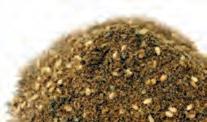

and chopped parsley slipped under the skin. Roast at 180C/356F/Gas Mark 4 until tender (about 30mins). Serve with a yogurt and harissa dip, alongside a mint and chunky cucumber salad (skinned and deseeded).

British Stilton has its own PDO (Protected Designation of Origin) and can only be made in certain parts of the Midlands. Young Stiltons are turned daily for at least a month because humidity, temperature and draughts all a ect the quality. Look for a creamy texture—if it’s crumbly it’s probably immature, or it’s been frozen. ■
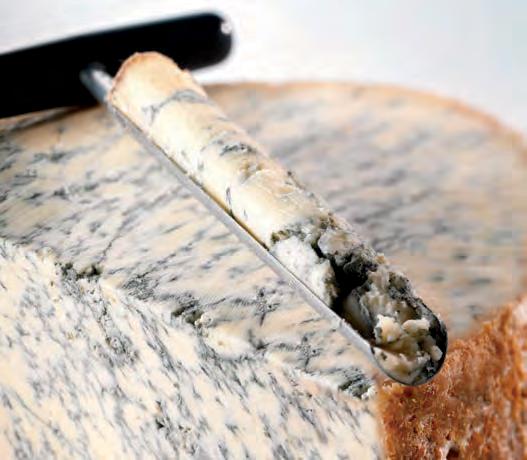
✰ CHRISTMAS FOOD SPECIAL
HOW TO…
BY LINDA GRAY

1,001 THINGS EVERYONE SHOULD
Welcome to the pages that help make life simpler, easier and—we hope— more fun!
How to BEAT DENTAL PHOBIA
IF YOUR TEETH ARE straight out of Bart Simpson’s Big Book of British Smiles, you may be one of the 40% who’d rather clean the toilet than go to the dentist. Or maybe you’re the one in three who’s scared witless, according to the same survey*. In which case, well done for reading this.
“Even toothpaste ads can trigger a panic attack if you’re phobic,” says Sandra Morris of the support group Dental Fear Central.
Once you can see the word “dentist”
KNOW

102
IMAGEBROKER/ALAMY * By Simply Health insurance
without hyper-ventilating, search for one who welcomes anxious patients, checking out the forum recommendations at dentalfear central.org and looking for those practising “gentle” dentistry. These usually o er sedation or hypnosis, and use gizmos such as The Wand for needle-less injections, and air abrasion instead of drills.
Next, ring the dental practice (this may take a few attempts). “Don’t ask if they deal with phobic patients, but how they deal with them,” advises Morris. If all’s well, book an appointment to discuss your fears, making it clear that that’s all you want. Ask for a slot first thing in the morning, so you won’t be kept waiting—and, if you need to, take a friend.
During the session, the dentist should explain what will happen and agree a “stop” sign you can give. If you’re still terrified, ask about sedation. Gas and air (nitrous oxide) can relax you completely, and with intravenous Valium you may not remember a thing.
Sadly, gentle dentistry is rarely available on the NHS, though it’s worth asking for a referral to an NHS sedation clinic or the Community Dental Service. If you choose private treatment, sedation is extra—you’ll need to pay around £80 for gas, and £150-plus for IV. But at least you can do it with a smile.

How to GET NIFTY WITH A TOUCHSCREEN
VIDEOS OF iPAD-TOTING TOTS ARE ALL OVER YOUTUBE, but those of us who weren’t born yesterday often struggle to prod a touchscreen into life. Which is often the problem, because the latest screens are capacitive—they respond to the body’s electrical charge, not pressure.
Using the pad of the fingers rather than the nail is often all you need to whizz round the screen. A quick tap should do the trick—pinching and flicking zooms in or out; swiping scrolls up and down; and press ’n’ hold selects. Screen won’t respond? Check the temperature. Touchscreens can be stymied by cold weather or poor circulation—both interfere with conductivity. Gloves won’t help unless they contain metal, like the silver gloves from The Raynaud’s Association (£8, raynauds.org.uk). Or buy a capacitative stylus, from 99p at Amazon.
to access your smartphone? Touch a
Stuck without either and need to access your smartphone? Touch a banana, apple, or crisp packet on the screen —and enjoy a very di erent working lunch.

103 NOVEMBER 2012READERSDIGEST.CO.UK
IMAGE SOURCE/GETTY IMAGES
►
How to SOLVE CRYPTIC CROSSWORDS

TORQUEMADA, XIMENES, THE TOUGHIE...cryptic crosswords can be torture. But there are ways to dissect the clues if you avoid these mistakes. Thinking of the clue as a whole. “Read it as separate words, not a sentence, and
How to GROW THE RIGHT ROSE
never be fooled by the surface meaning,” says Dave Morton, who has a beginner’s guide on Big Dave’s Crossword Blog. Not realising that every word counts. Cryptics should contain a definition (which comes first or last), a “subsidiary indication” or qualifying phrase, and no more. But don’t ignore the little words—they can tell you if the answer is an anagram (look for words meaning new or mixed up) or a soundalike (“sounds” and “heard” are giveaways). Others indicate hidden
AT PRESENT THEY’RE an unpromising bunch of sticks, but next summer those bare-root roses will burst into glorious life. Or at least that’s the theory. To make sure yours have more blooms than blackspot, look for the RHS Award of Garden Merit or the Gold Standard for new roses, given for performance and resistance to disease. Here are some of the best for...
Fragrance Chandos Beauty is blush-coloured with an award-winning scent.
words (amid, contains) or tell you to home in on the first or last letters of words (initially, at last).
Ignoring word play. Lateral thinking is key. “An evening out” can mean a plateau, while “lack of balance” equals bankrupt. And you’ll need good grammar to realise that the answer to “Maybe wearing some larger undies” is gerund. (“Wearing” is the definition, while “some” means part of “larger undies”.)
Forgetting the number of letters. Ultimately, the answer has to fit.

apricot blooms from spring until winter. Gloomy walls Climbers include Crème de la Crème, whose ivory blooms keep on coming, even against a north-facing wall, and New Dawn, once voted the world’s favourite, which tolerates partial shade.

Productivity Champagne Moment is a former rose of the year that produces
Groundcover Try Flower Carpet Pink, a spreading rose that’s scooped both RHS and Gold Standard gongs. Pots Flower Power Gold is guaranteed to cheer up the patio.
Old-world charm
Gertrude Jekyll—deep pink double blooms and a wonderful old rose scent.
Va-va-voom Buxom Beauty is a pink rose with super-sized blooms, developed for bra-makers Charnos.

104 READERSDIGEST.CO.UK NOVEMBER 2012
LOUIS FOX/DIGITAL VISION/GETTY IMAGES 1,001 THINGS

How to SAVE A VILLAGE SHOP
IT’S AN EVERYDAY STORY OF COUNTRY FOLK: the local shop is threatened with closure when a bunch of volunteers comes to the rescue, turning it into a community-owned venture. But it’s not just an Archers plot—there are almost 300 such shops in the UK.
To join them, you need to prove there’s demand. The Plunkett Foundation (plunkett.co.uk), which helps rural co-ops, suggests doing a survey, using the questions on its website. If the results are positive, hold a public meeting and elect a committee. Then choose a suitable legal structure (such as an Industrial and Provident Society), find premises and start fund-raising.
Grants are available from charities, councils and the Lottery’s Village SOS, but accessing them can be a full-time job. “I went through every charity on the Charity Commission’s list,” says Marie Winckler, who helped raise £300,000 for The Burrow, an underground shop and cafe in Exbourne, Devon. Grants are slow to come through, so you may have to start out in temporary premises and take out a loan to cover any shortfall. Equipping the shop is another expense (scouring eBay for bargains or begging for donations can cut costs).
Volunteers are key, and it’s wise to include a core group of professionals willing to work for free. “Look for a treasurer (preferably an accountant), an ex-local-authority person who understands the regulations, and someone with experience of retailing,” says Winckler. “And because it takes time, you also need someone with the patience to keep it all going.”


105 NOVEMBER 2012READERSDIGEST.CO.UK
MARK PASSMORE/APEX
with ►

How to KEEP THE PEACE
NOISE CAN TRIGGER high blood pressure, anxiety and even heart attacks— yet 40% of us live with levels that can be harmful. Here’s how to cut the risk.
SWOT—sheer weight of tra c a problem?
Double glazing with 100mm between the glass helps, and closeboard or acoustic fencing (better still, a wall) suppresses noise, but you need planning permission for high barriers facing the road. If a new/ improved road is an issue, you may be able to get compensation from the council or Highways Agency (highways.gov.uk).
Hammer blows Construction work is often limited to 7.30am–5.30pm during the week plus Saturday mornings. If that’s the case, complain if the hours are exceeded.
Jet stream Fit maximum loft insulation, triple glazing and acoustic door seals. Near a big airport? You might get a grant. Washday blues Appliances with the Quiet Mark lower the tone. See quietmark.com
Loud locals Keep a diary and record neighbour noise, especially from 11pm–7am, then complain to your local Environmental Health department. That’s it, I’m o ! Noise Maps for major urban areas (noisemapping.defra.co. uk) show areas to avoid. For details of flight paths, roads and shipping lanes worldwide, go to globaia.org
WHAT YOUR ONLINE STORE WON’T TELL YOU
● You have more rights than on the high street. Distance Selling Regulations apply if I sell by phone, mail order or online, because you can’t try before you buy. But the regulations only apply to traders in the EU, and don’t cover auctions (including eBay) or stores that usually do business face to face. So if I do you a favour by posting the goods, I’m exempt.
SOURCES: CITIZENS ADVICE; DEPARTMENT OF BUSINESS, INNOVATION AND SKILLS; MONEY SAVING EXPERT; OFFICE OF FAIR TRADING
● You can change your mind and send goods back, even jewellery or cosmetics or ones you’ve tested to make sure they work. If you notify me by post or email within seven working days of delivery (14 next year), I have to give a full refund, including standard postage. But you can’t return tights unless they’re faulty because they change shape when worn, or perishables, custommade goods, opened CDs and software, or mags.
● Want delivery before Christmas? Order by November 24. Goods must arrive within 30 days unless I tell you otherwise.
106 READERSDIGEST.CO.UK NOVEMBER 2012 STOCKBYTE/GETTY IMAGES
1,001 THINGS
● A PO Box won’t do. I’m legally obliged to give my full postal address on the website if I ask for payment upfront, or by the time goods are delivered in all other cases. How else will you chase me up?
● Don’t let me see you in the shop. If I find out you’ve looked at goods in store before buying them online, you’ll lose the right to cancel.
● I may have to collect your rejects. Unless I state that you’re responsible for returning the goods, I have to pick them up. I can’t insist you use the original packaging, and if you need


to assemble that flat-pack computer desk to inspect it, I can’t make you take it apart.
● Why don’t you look for the “s”? It stands for secure in “https”—http isn’t enough when you’re buying online. You’ll find it in the website address bar, often alongside a padlock icon. If clicking on that makes the padlock turn green, the site o ers the highest level of protection. But if there’s a padlock anywhere other than the address bar or the status bar at the bottom of the browser, log out—it may be a fraudulent website.



● Mind that “free” trial. You may unwittingly agree to pay for the service when the o er ends—and if you’ve given me your credit-card number for postage, I’ll help myself to the cash. It’s called a continuouspayment authority, and your bank or card issuer should cancel it if I won’t. If they refuse, contact the Financial Ombudsman. And read the Ts&Cs next time.
● Good luck with that complaint. 90% of e-tailers are hazy about Distance Selling Regs, 70% restrict cancellation rights, and only 30% give proper refunds. You can go to court, but can you face the hassle? If the goods cost £100 or more, it’s easier to pay by credit card and get your money from the bank.


goods cost £100 or more, card and get your money down.

My profits are going 0870 numbers on customer-service lines and excessive charges for processing debit and credit cards are about to be banned, so look out for changes in the New Year. But be equally alert for new “admin” charges, or a sudden hike in delivery costs. ■

“admin”
107 NOVEMBER 2012READERSDIGEST.CO.UK
MEDICINE WITH MAX PEMBERTON

NOTE PERFECT
How a visit to the opera taught me something medical school couldn’t
For all my years of studying medicine, one of the most valuable learning experiences I ever had was when I missed a ward round to go to the opera. I’d like to think it made me a better doctor, too.
Mrs Richards was in her sixties with spectacles perched on the end of her nose. She was prim and proper, but painfully thin. “Hello, I’m a medical student. Do you mind if I ask you some questions?” I said as I approached her bed. “Of course not, dear. It’s boring just sitting here,” she beamed. She leaned forward: “I think I should tell you, dear, that I’m dying.” I stared at her. Dying? For what? A dry Martini? “I’ve got cancer in my bowels and it’s spread to my liver.”
This was not good news. I didn’t know what to say to dying people

This was not good news. I didn’t know what to say to dying people. Throughout medical school, this was the one area that was never touched on. I was taught about the most obscure conditions that a ect only a handful of people, but death—that most universal of problems? Not a thing. So I had a choice. Either I made my excuses and left, or I stayed and chatted. Just because Mrs Richards was dying didn’t mean we should give up on her. There
must be something we could do to make things a bit better. It’s not easy for doctors to admit that medicine won’t always help. After all, we’ve spent years studying it, only to realise that it can’t o er a panacea. But talking to Mrs Richards I realised that being a good doctor is about much more than passing exams and doing exciting procedures. Sometimes you have to find other ways to help your patient.
“It’s a blessing in a way,” said Mrs Richards, cheerily. “I’ve got a few months to do all the things I’ve ever wanted.” So not knowing what else I could do, I set about making a list with her. At the top was seeing Verdi’s Nabucco at the Coliseum in London. It was the opera she
108 READERSDIGEST.CO.UK NOVEMBER 2012
DIGITAL VISION/GETTY IMAGES
Max Pemberton is a hospital doctor, and the Mind Journalist of the Year 2010
saw with her husband on their honeymoon 50 years ago. But it was sold out.
I should have been on a ward round by now, but I didn’t go. Instead, a few hours later, Mrs Richards had a ticket to Nabucco in her hand, courtesy of a very kind boxo ce manager.
As I left the hospital that night I bumped into my consultant: “Where were you this afternoon?” he asked sternly. “I had to go to the opera,” I winced. His face changed. “Good for you, nothing like a bit of opera. Much better than all that studying,” he smiled. I couldn’t agree more.

Want to shift a few pounds? Then listen to MAX’S PODCAST on losing weight at readersdigest. co.uk/magazine
KNOW YOUR MEDICATION CHEMOTHERAPY
WHAT DOES IT DO?
Chemotherapy—a large, disparate group of drugs—is used to treat cancer. All chemo drugs share one quality: they are “cytotoxic”—they kill cells.
HOW DOES IT WORK?
Cancer is caused by cells multiplying out of control— chemotherapy targets and kills more of these rapidly dividing cancerous cells than the body’s other cells.
WHO TAKES IT?
Those who have cancer. Some patients receive chemo on its own, while for others it’s given alongside radiotherapy and/or surgery. Some chemotherapy drugs are also given to people with conditions such as Crohn’s disease or multiple sclerosis.
are given as a drip into the arm; others are given as injections, or tablets.
SIDE EFFECTS?
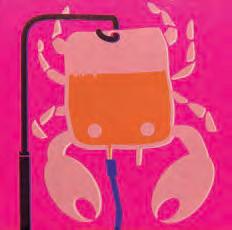
Some people have none or only minor side e ects. Others experience quite unpleasant side e ects, but these have to be balanced against the potentially lifesaving benefits of the drugs. Some chemo can result in hair loss, but not all. Patients can be at increased risk of infection while having chemo because the drugs weaken the immune system while they attack the cancer cells.
COMMON TYPES
HOW DO YOU TAKE IT?
It’s usually given in carefully controlled cycles that allow the body time to recover between treatments. Many of the drugs
There are over 50 di erent chemotherapy drugs. Some such as methotrexate are given to cancer patients, but also used in tablet form in lower doses to treat arthritis. ■
NEXT MONTH: antiepileptics
109 NOVEMBER 2012READERSDIGEST.CO.UK
ILL U ST R ATED B Y DAVID HU M PHRIES / MONSTE R

DEEP
Nine things you (probably) don’t know about psoriasis
1 It makes your usual skin-replacement process go wonky—cells take just a few days to renew themselves rather than a few weeks. Your body mistakenly thinks it’s fighting a bug or healing a wound and you break out in nasty, raised, red patches that can be flaky and scaly, and itch like crazy.
2 Psoriasis can a ect any area of the body, including the hands, feet, nails and scalp, even— painfully—your genitals and buttocks.


4
Ten per cent of psoriasis su erers have only one or two episodes and then it disappears.
3 But don’t fret, it isn’t catching, nor is it caused by not washing. It’s an immune condition. But it can be irritated by soaps and other perfumed products, and children and teens in particular can develop psoriasis after a throat infection.
HOW TO SHAVE PROPERLY

5 The most likely times to be hit by a bout are from your late teens to early thirties, and between 50 and 60.
6 There’s a family history of the condition in a third of cases, but you have a 50-50 chance of getting it if both your parents su er.
Barber rash and razor bumps are common in men (80% of Afro-Caribbean guys are a icted), and some shaving problems can be bad enough to require treatment. But chin up—shaving correctly helps: Use warm water to soften the skin and reduce irritation. Apply shaving cream or foam in the opposite direction to hair
growth. This helps to lift the hair and moisturise the skin. Shave in the direction of hair growth. This won’t give you the closest shave, but you’re less likely to have ingrown hairs, cuts and irritation.
Don’t stretch the skin too taut—you could end up shaving hair below the surface of the skin and getting
110
HEALTH WITH SUSANNAH HICKLING SKIN
WOODYSTOCK/ALAMY
7
It tends to get worse during the winter and better during summer. UV light definitely helps (phototherapy is one treatment on o er), but don’t overdo it as sunburn can trigger a flare-up.
8 Coal tar is a traditional remedy, but fortunately there are other creams and lotions available, along with tablets and injections that stop your skin or immune system overreacting.
9 Famous su erers include comedians Alan Carr and Justin Lee Collins, Jason Donovan, and, er, Stalin.
ingrown hairs. Shave the chin, upper lip and lower lip last. The hair here takes longer to soften.
» Find out more about men’s health at the Men’s Health Forum (malehealth.co.uk)
Simple exercises to build balance and strength can cut falls by older people by a third, according to a new study from the University of Sydney.
DON’T FALL FOR IT!
Here are a few ideas for moves to build into your everyday routine. (Check with your doctor that these are the right kind of exercises for you.)
l Stand on one leg when ironing to improve balance.
l To strengthen knees, squat rather than bend from the waist to close a drawer or pick something up o the floor.
l Stand on your heels while
chatting on the phone; go as far as you can while still remaining stable.
l Move from foot to foot as you do the washing up.
l Practise getting up from a chair without holding on to the arms.
l Carry a tray or a drink in a cup while tandem walking— where the toes of your back foot touch the heel of the front foot with each step. Carry groceries from the car to the house while walking sideways.

DAYDREAM BELIEVER
l Climb the stairs frequently.
l Step over objects.

Always thought daydreaming was for slackers? Not at all. Researchers believe daydreams help us make sense of events in the past, while allowing us to rehearse future scenarios and make smarter choices.
Swiss psychiatrist Carl Jung created an active imagination technique that helped him ease his own emotional turmoil. You too can use it to tune in to your unconscious:
STOP Find an environment where you can be alone to think, such as on a walk, or sitting in a chair with your eyes closed.
THINK Pick an idea that pops into your head, or something that’s on your mind and allow your thoughts to flow freely, even if they don’t make sense.
WRITE Jot down or sketch your thoughts. Don’t look for solutions.
REPEAT Keep using this technique and eventually you’ll recognise patterns or discover insights.
► STEVEN E RRICO/GETTY IMAGE S PURE S TOCK/GETTY IMAGE S
DOCTOR, DOCTOR ARE SOME PEOPLE NATURAL OVEREATERS? HEALTH








In my weekly clinics, at least one person is bound to say something like “I just can’t resist cake,” or “I only have to look at chocolate to put weight on.” A natural response might be simply to disbelieve them. After all, if they were only looking, they wouldn’t be at a weight-loss clinic. Yet might there really be an element of compulsion about some food choices?
Do people with weight problems, in fact, respond di erently to certain food types?
Studies have shown that “cue exposure” (the sight and smell of food) can have a profound e ect on our readiness to eat, increasing hunger, pulse rate and salivation. More importantly, cue exposure also promotes the selection and consumption of larger portions.
The key question,
though, is whether “cue exposure” works more powerfully on those who are already overweight. A recent British study has gone some way to answering this.
Fifty-two people of normal weight and 52 who are overweight were exposed for a minute to the sight and smell of a “cued” food—in this case, pizza—and their responses were measured.
The overweight participants reported a greater desire to eat both a cued food (pizza) and other non-cued foods (scrambled egg, chips and beans). They also had a stronger salivary response. These observations are important because they suggest that overweight people are in some way “primed” to over-consume.
But is this heightened response genetic, or is it learned behaviour? While there is some evidence of a genetic influence, many experts feel the likelier explanation is that cue-reactivity is learned during childhood from parents who encourage habits such as “plate cleaning”. In other words, it’s a good idea to think carefully before encouraging your children to eat more than they want to.

SHARING CARING INFORMATION
Dr David Ashton of Healthier Weight
Carers’ Rights Day falls this month—it aims to alert carers to the financial help they might be missing out on. Amazingly, up to 60% of carers’ benefits go unclaimed. It’s worth checking whether you’re eligible for Carers’ Allowance, or, if not, extra allowances for carers paid as part of Income Support or Pension Credit. There’s also Employment and Support Allowance, Jobseeker’s Allowance and Tax Credits. And don’t overlook opportunities for grants to adapt your home to meet the needs of the person you’re looking after. The Carers UK’s adviceline is on freephone 0808 808 7777. ■
112
FOR MORE ON HEALTH, GO TO READERSDIGEST.CO.UK/HEALTH
VETTA/GETTY IMAGES

BEAUTY WITH ALICE HART-DAVIS

UPDATE YOUR LOOK
Use the holiday season to have a complete makeover…or three
So you’re o to a few Christmas parties? Wearing make-up? The same look that you’ve had for the past 15 years? Here’s a suggestion: have a think now about an update, while there’s time for experimentation.
The good news is that it’s perfectly possible to wear make-up that’s di erent, or stronger—or generally more modern—than what you’ve become used to, without looking inappropriate or like mutton dressed as, well, mincemeat.
Put aside any instinctive resistance you may feel towards the beauty counters of department stores. These are great places to start, and their sales sta are often trained make-up artists and just love having faces to practise on. Tell them your make-up woes and dreams, and see what they can do for you. If you don’t like
the results, wipe your face clean—there’s no harm done and no obligation to buy. Bobbi Brown’s counter sta are especially good at doing grown-up, sophisticated but understated looks; their “smoky eyes” lessons are very popular.

For detailed inspiration for the no-longer-youthful face, check out top make-up artist Louise Constad, who is the brushes-of-choice for actresses including Kristin Scott Thomas and Helena Bonham Carter. When she’s not on set, she runs beautyqueenwork shops.com, teaching women how to do e ective make-up (from £250 for a morning one-to-one, or £350 for a small group), and she knows the challenges of the ageing face.
“When we get to 50, our faces seem to disappear,” she says. “Our eyebrows fade
PRODUCT OF THE MONTH




(£60) is a thing to treasure, but then so is





Dior’s new Grand Bal make-up collection for Christmas is beyond gorgeous. The palette (£60) is a thing to treasure, but then so is the dumpling of a nail-varnish bottle (£20). And wouldn’t either make a lovely present —for you? Just tear this page out and leave it lying around. At Dior counters nationwide.


MOTHER IMAGE/GETTY IMAGES
FAST FIX

and our lips and eyelashes get thinner. So these are my miracle tips:
• Get your eyebrows professionally shaped and tinted, to frame your eyes and bring back shape to your face.
• Fuller, thicker lashes make eyes look younger. I’ve been using a lashgrowing product called M2Lashes (£123 at Harrods); a cheaper alternative is Rapid Lash (£36 at Boots). My lashes seem twice the size, so any mascara has more e ect.
• Regain your lips, which shrink with age. I use a stay-put bold lipstick (MAC’s and Maybelline’s are best) and draw it right to the edge of my lip line to give my lips back their old size. If you hate strong lipstick, try using a highlighter pen just above the Cupid’s bow to give the impression that your top lip is larger.”
Perfect for party hair, Kérastase’s new Initialiste serum is skincare technology for the scalp. Use it for a month and it claims to thicken and strengthen your hair by nourishing the stem cells that help its growth. More immediately, it leaves hair soft, shiny and easy to style (£40; 0800 316 4400).
THE BEAUTY BASH
If you fancy hosting a rather di erent sort of party (no, not Ann Summers, but yes, it’s home-selling), take a look at myshowcase.com. Using this site, you can buy products, host a beauty party (their stylists mastermind the details, which means you and your pals can enjoy the evening), or become a stylist yourself. The editorial and brand director is the brilliant beauty writer Kate Shapland, so the selection of products is terrific, and her blog posts— including a masterly blast on her Top Ten Beauty Commandments— are required reading for informed beauty-buyers.

Daphne Brouard, 54, from Southampton, loves Nurture Replenish Neck and Décolletage Cream—a quickly absorbed anti-ageing treatment that firms and smooths. Containing retinol, antioxidant and ca eine, it helps tackle the signs of ageing from jaw to décolletage.



“I love the light feel of the cream, and I’ve noticed a big di erence in the texture and tone of my skin,” explains Daphne. “It’s not too expensive and has helped pigmentation patches, too.” (£15.90; nurture skincare.co.uk) ■
115 NOVEMBER 2012READERSDIGEST.CO.UK
I JUST LOVE...






SIZE DOES MATTER
Why do women have an uncanny instinct for the correct length?
Women have always considered themselves a better judge of length than men, and are only too happy to chide us on our very personal miscalculations. This thought occurred to me when I saw a major high-street sandwich store o ering six-inch and foot-long rolls filled with glorious bits of your choice.
I’d received a Tweet from a reader who claimed that his six-inch roll was considerably shorter than advertised. But I noticed that he’d been served by a man, and while that wasn’t significant to our complainant, it seemed very relevant to me. Is it possible, I considered, that men consistently overestimate the length of the rolls they give customers—serving up four-inch rolls, say, instead of six-inch ones—while their female colleagues accurately cut their lengths with surgical precision?
With some trepidation
I put it to the test, and ordered one footlong sandwich and two sixinch rolls cut from separate
loaves. Then, at the back of the shop, I surreptitiously took out my measuring



tape, ready to answer one of life’s great questions. Sadly, it transpired that the men did indeed cut their rolls an inch shorter from a full gauged the exact distance of six inches.
loaf, while the women accurately gauged the exact distance

Perhaps women are just experts at this distance, and have a innate talent when it comes to slicing six-inch rolls— something that clearly requires further evaluations and research trips to sandwich shops for the betterment
and improvement of mankind. So I shall continue to seek out great knowledge on your behalf, with my trusty measuring tape of truth in one hand and a cheese roll in the other.
The things I do for you!



CONSUMER WITH DONAL MACINTYRE
ISIFA IMAGE SERVICE S.R.O./ALAMY ► 117
IF YOU DON’T ASK...
Donal answers your questions. Please email queries to excerpts @readers digest. co.uk
QI had an issue with the plumbing in my flat leaking down to the three flats below. That was all covered by insurance, but when I got a plumber in to fix the problem it appeared that pipe fittings fitted by the previous owners were defective. I’d had a full structural survey done, and I feel that this should have been pointed out. Do I have a claim against the survey company?
A
The previous owners could be liable, but only if they didn’t tell you when you directly asked about it. When buying a house, it really is a case of buyer beware. Your bible or inventory is the property information form, which asks the seller a series of key questions, and if they lie or don’t report works that they have done on the property, you may have a claim against them. In the likelihood that they didn’t lie, recheck the survey done before you bought your property to check they did their job properly. If it appears they didn’t, you may have a case for compensation against them.
next door so I could enjoy the pizza I really wanted. After some consideration, the manager of the store said I could get the can and they would use them (which they did), but she insisted that I wouldn’t get a reduction for providing one of the ingredients. Is this fair?
A
I can believe this because I once went to a pizza restaurant that had run out of cheese, of all things. The issue for the store is one of liability and bad manners—if, for example, the anchovies were contaminated, you could sue them because they chose to serve up ingredients they hadn’t quality controlled.

Donal MacIntyre is an investigative journalist and a former presenter of ITV’s London Tonight
Q
I went to a high-street pizza chain and ordered a pizza with extra anchovies. The waiter came back and told me they were all out of anchovies. I said I’d get a can from the shop
The question really is not whether you’re entitled to a reduction, but whether—if it was a good store—you should be entitled to get the whole pizza free on account of their failure to give you the one you wanted. I went to a Starbucks recently that actually ran out of water—which we can all agree is a key ingredient—and the entire sta spent the day handing out free co ee tokens.
If you write to the head o ce of the restaurant chain, I’m sure they’ll compensate you out of embarrassment at the very least. ■
118 READERSDIGEST.CO.UK NOVEMBER 2012





MONEY WITH JASMINE BIRTLES

A NEW EQUALITY
Will a new EU rule make your insurance more expensive? Depends on your sex
WHAT IS THE EU GENDER DIRECTIVE?
Passed by the European Court of Justice on March 1, 2011, it’s a ruling designed to ensure that there’s no discrimination between women and men in insurance premiums. It will change the way insurance companies assess and calculate individual packages. So as of December 21, 2012, insurers cannot use gender as a rating factor when pricing risk or paying benefits.

“And do you have any other pre-existing conditions—besides being a man?”
The new directive is applicable to annuities, life insurance, critical illness, income protection, health insurance and car insurance. Travel and home-insurance premiums aren’t a ected.
HOW DOES IT AFFECT YOU?
Car insurance. Insurers have previously considered that women have fewer accidents compared with men, therefore their premiums have often been lower. This will no longer be permissible.
Life insurance. Basically, the cost of life insurance will go up, particularly for women. Linda Winder at finance company LV= says, “Because women have a longer
life expectancy than men, they currently pay less for life cover. But they pay more for income protection as they’re more likely to be unable to work due to illness.
“When protection prices switch to being gender-neutral they won’t simply settle in the middle—they’re likely to lean towards the ‘more expensive’ sex. So most women will have to pay more for life cover, but less for income protection. Men might enjoy some reductions to the cost of life and critical illness cover, but they’ll pay more for income protection.”
As well as the gender changes in December, from January 2013 most lifeinsurance companies will have to pay more
120 READERSDIGEST.CO.UK NOVEMBER 2012
CARTOONS BY
IAN BAKER
tax under new laws, which will push up prices for us. This double-whammy e ect means that most of the savings on protection products that could have been made from the changes in gender pricing will be wiped out by the tax changes. Great!
So the message is, if you’re thinking of taking out a protection policy, act sooner rather than later to make sure you don’t pay more by missing the gender deadline.
Annuities. An annuity is the money you get paid when you draw your pension. Annuity providers currently assume that women will live longer than men, so they tend to give men better annuity rates than women (5%–8% better). This is set to change under the new rules
Linda Winder says, “On or after December 21 women must get the same annuity rate as men. So rates are likely to fall for men, but could improve for women.
“We expect unisex rates to drop closer to the current female rates. But over time, we think rates will settle more towards the midpoint of the current male and female rates. The di erence in rates between genders isn’t constant, it also depends on other factors, including age and health.”
So if you’re a man approaching retirement, consider buying an annuity before the gender directive comes in, but don’t rush into it. It’s a purchase for life, so it’s as important to ensure the product is right as it is to maximise the annuity rate.
If you’re a woman, you might put it o until the directive comes in. But be careful. Both investment markets and annuity rates could change between now and December 21, and this could work for or against you. You also have to consider the income you miss out on in the mean time.
THE FUTURE OF FINANCIAL ADVICE
I’ve always said you should pay for financial advice because if you get it free the “advisers” make money from the products they recommend, so they’ll suggest products that pay a good commission, not necessarily the ones that are right for you.
Now the FSA has ruled that as of 2013 all advisers will have to charge. The Retail Distribution Review has forced financial services to charge di erent rates for giving advice on investment products such as ISAs and pensions, eradicating tuckedaway commission charges.
How will you pay?
From December 31, instead of being paid by commission, advisers will have to agree charges with you upfront. They may charge an hourly fee (say around £150) or a percentage of the amount you are investing (maybe 1%).

Rather than paying a fee upfront, you might be able to agree with the adviser to have their fee taken from your investment.
Where do you go for the best advice?
The new rule means that if your advisers say they’re independent, they can advise on all of the products you could invest in. If not, they’re o ering “restricted” advice. Restricted advisers will either specialise in specific areas, such as pensions, or
121 NOVEMBER 2012READERSDIGEST.CO.UK
PETER DAZELEY/GETTY IMAGES ►
o
er limited advice on a smaller range of products. Your adviser will have to explain what they can advise on. (It’s best to go for advisers that have access to the whole market.)
Financial advisers will also have to gain an annual Statement of Professional Standing (SPS) certificate as proof they’ve met, and are keeping to, professional standards.
These changes should help to:
l Increase confidence and trust in the advice you receive, as you’ll know it has been recommended to suit your needs.
l Show you exactly what you’re paying for. Costs will no longer be included in the charges of products you buy.
l Give you access to a higher level of technical expertise due to the new standards advisers must meet.
MAKE £70 AN HOUR AS A TUTOR!
Do you have a university degree, particularly in maths or science? Whatever your age, you could make as much as £70 an hour tutoring children for GCSEs or A levels.
How does it work? Tutors are usually employed on a short-term basis to help kids make it through the weeks leading up to their exams and get them properly prepared.
What qualifications do you need? You don’t necessarily have to be a qualified teacher (if you have a degree, your skills in that subject will still be sought after). University students studying for their degree can make themselves some much-needed cash, too. You need to be patient, and a positive, enthusiastic communicator, who’s good with teenagers (remember they’re a di cult age group). Along with aiding their learning, you’ll need to be able to inspire confidence in them. Don’t forget that unless you work through an agency, you may need to have a Criminal Records Bureau (CRB) check.
How do you get work? Put adverts up in your local area: in the library, post o ce, supermarket or newsagent’s,

“Today we’ll start o with how to orientate a monitor properly…”
122
◄ MONEY
FOR MORE ON MONEY, GO TO READERSDIGEST.CO.UK/ F INANCIALSERVICES ►
NEWS JUST IN...
Gender law could lead to rate increase

From 21 December 2012, new European gender law means that men and women will have to be treated the same when it comes to insurance premiums. This means that the rates you would pay for any new insurance products will change.
For this reason, it really makes sense to think about financial services products before the 20th December 2012 deadline. To find out more about the range of products offered by Reader’s Digest phone 0800 022 3822 or visit readersdigest.co.uk/financialservices
Liverpool
Society
Vivat
Friendly
Liverpool
Victoria Friendly
Limited: County Gates, Bournemouth BH1 2NF
Finance Limited (trading as Reader’s Digest Financial Services) acts as an introducer appointed representative to Liverpool Victoria
Society Limited for life protection products. Vivat Finance Limited is registered in England No. 07205138. Registered office: 157 Edgware Road, London W2 2HR LV= and
Victoria are registered trade marks of Liverpool Victoria Friendly Society Limited (LVFS) and LV= and LV= Liverpool Victoria are trading styles of the Liverpool Victoria group of companies. LVFS is authorised and regulated by the Financial Services Authority, register number 110035. LVFS is a member of the ABI, AFM and ILAG. Registered address: County Gates, Bournemouth BH1 2NF. Tel: 01202 292333 21229437 09/12
for instance. Alternatively, go online and advertise there. Schoolstrader.com is a great option—it covers 30,000 independent primary and secondary schools across the UK and Ireland. Placing an ad there is free, and it’ll stay up on the site for three months.
Or you could work for an agency— you’re likely to earn more, but they often have strict requirements about your educational background. They’re unlikely to employ anyone without teaching qualifications or a firstclass degree.
Have a look at the Good Schools Guide (which is expensive, but your local library should have a reference copy) to see which agencies they recommend.
Over the past five years Bright Young Things (brightyoungthingstuition.co.uk) has been recruiting high-flying students as tutors. They say that some of their Manchester graduates last year were earning over £100 for four hours’ teaching through their online one-on-one service.
Online tutoring? This is becoming a popular option—it’ll save you travel costs, and it’s more convenient for families, particularly those in remote areas.
Tutors can speak to children remotely using a Skype headset, and work is done on a virtual whiteboard. Check out hometutoringonline.co.uk.

Want to cut your food bill? Then go to readersdigest.co.uk/magazine and listen to JASMINE’S PODCAST
THIS MONTH’S BARGAIN
Aquaneed, which specialises in creating bathrooms and kitchens for elderly people or those with disabilities, is o ering 15% o a complete project for anyone who quotes “Reader’s Digest” when calling them on 01784 895077*.

JARGON BUSTER LIBOR
This is the London Inter Bank O ered Rate. It’s the rate at which banks in London lend money to each other for the short term in a particular currency. A new Libor rate is calculated every morning by financial data firm Thomson Reuters based on interest rates provided by members of the British Bankers’ Association.
THE ONE THING YOU MUST DO THIS MONTH...
...is make money for Christmas. Now’s a good time to sign up for seasonal work in department stores such as Debenhams and Marks & Spencer. They often have ads in store, so go in and ask.
Or sign up for Christmas work at the post o ce.
Check out
royalmail.com/ jobs-home-page/ xmas.
Also, try my new moneymaking tool (go to readersdigest. co.uk for the link). You just put in the amount you want to earn per hour and it will come up with a host of ideas.
Give it a go! ■
Jasmine Birtles is a personal finance writer and the founder of moneymagpie.com
*O er only applies to the South East
READERSDIGEST.CO.UK NOVEMBER 2012 124 ◄









GARDENING WITH BOB FLOWERDEW

CUTTING BACK
Easy on the secateurs! Roses require less e ort than you might think
QI’ve moved house and inherited a nice bed of roses. My new neighbour says he prunes his similar bed hard each winter, and insists I should do likewise. But I’ve heard this isn’t strictly necessary.
Can you help?

AA light prune is all that’s needed for plentiful roses



Some pruning is necessary or rose bushes soon get huge, with some disproportionately large compared with others. However, the old-fashioned hard pruning was mostly in order to produce fewer—but much larger—blooms, so unless you’re taking them to a garden show, a lighter prune is enough most years. Just shear the outside o each bush to make a neater blob. This is the muchderided “lollipop on a stick” method, which annoys experts but does, in fact, work rather well—next summer, you’ll have a longer show of many more, albeit slightly smaller, blooms.
POND LIFE
QWhen’s the best time to clean the muck out of my garden pool without doing too much harm to the wildlife in it?
A Now is probably as good a time as any, as soon as the current fall of leaves has finished. Save as much of the water in buckets or butts as you can, and bail the rest away. Then, using a plastic bucket,

as much of the




127
CAROLINE CORTIZO/ALAMY; FRANCESCA YORKE/GETTY IMAGES (PRUNING) ►
scoop out the gunge and spread it on a plastic sheet, so any larger critters can be caught and saved. This is rich material and is good added to the compost bin, but it could also be spread under soft fruit, roses, shrubs or a vegetable bed.
If refilling from the tap, leave the pool to stand a few days to de-chlorinate before adding back the saved water and critters.
SLUGGING IT OUT
QMy garden has had a terrible year —it’s been blighted with plagues of snails and slugs. Is there anything I can do to stop them coming back in such vast numbers next year?
AA really thorough tidy can help thin out the snails, which will have started hibernating by now. Sort through neglected corners, especially those with piles of pots or junk. Turn over planks of wood, bricks, pots and so on, and look underneath garden planters and ornaments. Some slugs will also be found, but lots more over-winter in the soil. Many can be brought to the surface under a plastic sheet if one is laid down and held in place for several days, then removed one morning for the birds to have a feast.

When digging and planting, watch out for and destroy any “nests” of translucent spheres—these will be their eggs.
Bob Flowerdew is an organic gardener and a regular on BBC Radio 4’s Gardeners’ Question Time. Send your gardening questions to Bob at excerpts@readersdigest.co.uk
BOB’S JOBS: NOVEMBER



Pack fallen leaves in bin bags; store for two years to become leaf mould.
Buy and plant any new trees, soft fruit and shrubs while your soil is still warm.
Burn woody or thorny prunings, saving the ash to apply in spring.
Top up mulches; spread manure or compost on veg beds and around certain plants.
Divide and replant overgrown hardy herbaceous plants. Prune soft fruit, apples, pears (but not plums or stone fruits), roses and most shrubs.
If the grass is still growing, give it a last cut and get the mower serviced.
READER’S TIP
Recycle your used co ee grounds by sprinkling them around your hostas (pictured) or other acid-loving plants. They will act as a slow-release nitrogen fertiliser and—as an added bonus—the ca eine will deter slugs.

Submitted by Nancy Briddon, by email ■
» Email your gardening tips and ideas— with photos, if possible—to excerpts@ readersdigest.co.uk. We’ll pay £70 if we use them on this page.
128 READERSDIGEST.CO.UK NOVEMBER 2012
◄
STEVE SPELLER/ALAMY; POLLEN PHOTOS/ALAMY


































































This Christmas treat yourself or a loved one to a whole year of inspiring real-life stories, hilarious jokes and fun puzzles, delicious recipes, great gardening advice, must-know tips and much more. Plus, with this special o er you save 64% o the cover price!







Special subscription o er Get 12 issues of Reader’s Digest for only £14.90! Order now! Call 0800 652 4048 and quote the code RDXMAS12 Or visit www.readersdigest.co.uk/subscribe



























Terms and conditions: This o er is only available for new subscribers
WILDLIFE WITH MARTIN HUGHES-GAMES

WARNING SIGNS
Birds of a feather flock together—and chat to those of a di erent plumage
Look up into treetops this month and you may notice large flocks of little birds fluttering about. In autumn, di erent species of small birds often travel around in mixed flocks— in a big group, there are lots of eyes on the lookout for danger.
Communication breakdown?
Here’s an interesting thing: although di erent species of bird don’t recognise each other’s song, they do recognise each other’s alarm calls. When danger threatens, they often speak the same language, but it’s more subtle than that. Many birds have distinct calls for di erent types of danger—the call
CHUBBY PUPPIES
Not for these bohemian waxwings





for an aerial predator such as a sparrowhawk is quite di erent from a call for a predator on the ground (say, a fox). Birds’ alarm calls for aerial attackers tend to be “non-directional”, as if throwing their voices like a ventriloquist, so it’s almost impossible for the attacker to locate where the call is coming from (although other birds in the area will be alerted).
If the enemy is on the ground or perched, however, the alarm call used is easy to locate and other birds will be attracted to provide support—perhaps joining forces to mob a perched owl.
The UK has two types of seal—the common seal and the grey seal. The Latin name for the grey seal translates, rather cruelly, as “hooknosed sea-pig”! Grey seals “haul out” to give birth this month. It seems an odd time, but as a new pup gains over three pounds a day and mum loses around 130lbs (as she doesn’t eat), it might be she needs the summer to build up her reserves. Pups are brilliant white, making them very conspicuous. It’s thought the coat is an evolutionary throwback to far colder times, when there was snow on the ground—the pups would have been well camouflaged for the first weeks of their lives, when they’re on land being suckled.
One fascinating grey-seal fact: quite a few healthy, yet completely blind, grey seals have been found, clearly able to survive without sight.
130 READERSDIGEST.CO.UK NOVEMBER 2012
STEFAN MEYERS/ARDEA.COM; ROBERT CANIS/FLPA; RICHARD AUSTIN/SECRET WORLD
CUBBY HOLES
This year has been hard for my local animal-rescue centre, Secret World. The sodden summer washed out many fox and badger setts, greatly increasing the numbers of orphans they had to deal with. It costs around £1,000 to look after each cub and get them back to the wild. But after all the e ort, how well do the orphans do when they’re released?
It’s clearly an important question. Secret World’s release programme finished last month, and now they’re using the latest technology to try to monitor how the orphans are doing. Trap cameras, triggered by movement, photograph cubs returning to feeding points. They want to be sure the cubs don’t bolt but stay in the area, finding their feet. Cubs are individually marked by fur clippings. All badger cubs are microchipped and vaccinated against bovine TB (they won’t be released anywhere near the current cull zones anyway). By placing receivers that detect the microchip near badger setts, Secret World can tell if animals are being incorporated into existing groups.
One female badger cub, released in 2009, was spotted this year having joined an existing badger sett, and cubs have been photographed actually being “picked up” by adult females.
So far, release manager Andy Parr says he’s been pleasantly surprised by the number of “good outcomes”.
Andy is always on the lookout for potential badgercub release sites, and if you think you could help, you can call the centre on 01278 783 250. n

Martin Hughes-Games is a host of BBC2’s Springwatch and Autumnwatch
131


CAST OF MILLIONS
The US election in 2008 was a digital watershed—now, everyone’s doing it
Four years ago, Obama won by 170,000 votes in Florida. Renowned as the swing state for the White House, 320,000 older Jews backed him—because their grandkids told them to.
Is this an oPad, perhaps?

Called the Great Schlep (schlep is “to drag oneself” in Yiddish), and comprising a website and online film— and also faith that bubbies and zaydes would listen— young Jews were inspired to visit, call or email their grandparents and tell them why to vote Obama. Within days, the campaign went viral—and the rest is history.
Back then, Obama and his supporters were lauded for innovative use of technology. Now, at the climax of the 2012 clash, it’s a given that both camps will maximise digital potential. Facebook, Twitter, apps, and platforms such as Obama’s Dashboard (which allows volunteers to coordinate local campaigns, find like-minded souls, and use social mediatype tools while giving organisers a bird’s eye view)... you name it, they’ve got it, and crowdsourcing public ideas and creativity is the new frontier. like-minded souls, organisers a bird’s eye view)... got it, and crowd-
TRY THESE
While looking worldwide is a great way to glean good ideas, there are heaps of top tools and projects underway in the UK that could do with your time and skills. Here are my favourites:


▪ Epetitions.direct.gov. uk lets us create and sign petitions online. Unveiled last year, over 36,000 have been submitted, attracting 6.4 million signatures—that’s 12 people signing up every minute. Petitions can cover anything that the Government’s responsible for, and if a petition collects more than 100,000 signatures, it’s considered for debate in Parliament—resulting in six debates so far.
▪ People-Powered Change is the concept behind all Big Lottery Fund projects in the UK—enabling individuals and communities to develop and implement ideas to change lives.

FOX
ONLINE WITH MARTHA LANE
AFP/GETTY IMAGES
Check out people poweredchange.org for a map of current projects such as newsnet.media trust.org, which provides tools and connections to

help people become citizen journalists, and yoursquaremile.com, which enables anyone to transform where they live with pride in their area, belief in local people, good advice and the right tools—16 community pilots are already underway. Use the interactive map for a slice of the action around you—from volunteering and donation, to reports on problems flagged with your local authority.
▪ 38degrees.org.uk
o ers a new way to take action on the issues you care about: from tackling poverty, protecting schools and hospitals, to the
environment. Inspired by advocacy groups such as MoveOn in the US, GetUp in Australia and Avaaz around the world, anyone can join, and campaigns are chosen by members —recent ones include stopping the sale of national forests and convincing the Government to sign up to an EU Directive on human tra cking.
▪ Data.gov.uk has over 8,600 sets of public stats. Add your own, create apps for public use, or enjoy ones shared by others. (I liked “Where Can I Live?”, which tells you where you can a ord to live, and “Commuter”, which integrates live info on UK transport services into one simple screen.)
▪ Nesta.org.uk helps bring big ideas to life. One of its competitions, Make It Local Scotland, is unlocking the digital potential of localauthority data to improve and develop services, by rallying digital-media developers and forwardthinking councils.
ABSOLUTE BEGINNER
WHAT’S A PLUG IN?
PLUG-INS let you do lots of extra stu that websites or programmes can’t do on their own —like watching videos, listening to the radio, or playing games. When you’re surfing the web, you might be asked to download one—maybe Adobe Flash Player (which you need for lots of pages on bbc.co.uk), QuickTime or Windows Media Player. They’re super-simple to install —just follow the steps when prompted.

Give an hour of your time to help an internet beginner. Go to go-on.co.uk for more. Or to find a taster session near you, call freephone 0800 77 1234.

Martha Lane Fox is the UK’s digital champion and chairs Go ON UK (go-on-uk.org)
133 NOVEMBER 2012READERSDIGEST.CO.UK
MOTORING WITH CONOR McNICHOLAS

AUTO RECYCLE
Today’s newspaper isn’t tomorrow’s chip paper—it could be tomorrow’s car
Would you buy a car made out of paper?
Or maybe soya beans? It’s not as mad as it sounds, because car manufacturers are now looking at all sorts of new materials to build the cars of the future.
Separate out the materials in a standard family hatchback and you’d end up with piles of steel, glass, rubber and plastic. It’s quite staggering to think of the complexity needed to bring that combination together and have a car up and running.
We’re not surprised to see any of those materials in a car these days, but it wasn’t always this way. Back in the early 20th century, Henry Ford made the leap from wood to steel in car bodies and started a manufacturing revolution. But he was also, at one point, looking at soyabean plastics for the interior before the company eventually settled on
the petro-chemical plastics we know today.
Car materials have been chosen for cost and ease, but globalisation is changing the rules. Materials that were cheap are becoming more expensive through excess demand, and the fear of oil running out is forcing manufacturers to look beyond traditional plastics. Even cheap and plentiful materials are now being judged on their environmental impact.
Companies are looking at compressed bamboo, bio-plastics from corn and sugarcane, and even seaweed for new sources of massproduceable materials.

However, French manufacturer Peugeot has taken a di erent tack with a recent concept car exhibited in Paris, looking at how they can use materials with as little processing—and therefore environmental impact—as possible. The interior uses compressed newspaper (producing a wonderful grain of newsprint) and felt. Externally, it has hand-beaten copper that will take on an oxidised patina.

The Peugeot Onyx concept car, with fetching newspaper interior
So next time you’re in your car, have a look around at what you’re touching and driving.
We take it all for granted at the moment, but in a few years’ time it might be a very di erent place indeed.
ONE TO BUY

Volvo V40 D3 ES (£20,995) It’s taken me a while to get behind the wheel of the new V40, but it’s been a very pleasant surprise. If you value smoothness over sportiness, then the Volvo will deliver a driving experience like pouring double cream. It’s classy inside, too, with lots of lovely design touches. A definite recommendation.
ONE TO SPOT
Mercedes CLS Shooting Brake 350 (£53,000) Taking the swoopy four-door coupé of the new CLS and lifting up an estate-like boot at the back has generated a graceful, elegant but very practical car. You can even specify a cherry-wood boot that looks like the deck of a yacht. Nice.
ONE TO DREAM ABOUT


Maserati GranCabrio MC (about £100,000) You’ve always promised yourself a Maserati, right? If not, you probably don’t have a pulse. Just the name is enough to set the blood flowing faster. Masser’s GranTurismo megacoupé has been around for a while, but this latest souped-up and top-chopped GranCabrio MC represents the thrillingist of the bunch, and is still enormously desirable.
STRETCH A POINT
£150k-worth of stretch limos in the UK have been taken and crushed...by a government department. The Vehicle and Operator Services Agency—the people who run the MOT —are making a strong safety point to the chau eur industry by confiscating illegally operated limos and handing them over to local fire brigades, who drive trucks into them and rip them apart with cutting gear. The chau eur industry is up in arms, though, arguing that limousine travel is safer than any other form of road transport. ■
 Conor McNicholas
Conor McNicholas
is the former editor
of BBC Top Gear Magazine
135
TRAVEL WITH KATE PETTIFER

MY GREAT ESCAPE
Christine Taylor from Dorset went sailing through the Panama Canal
I was on board the P&O liner Oceana at Gatun Lock, the final stage of an awe-inspiring transit of the Panama Canal. My adventure—the highlight of a Caribbean cruise—had begun nine hours earlier at 6am. The air was already warm and humid when, in the dawn light, I saw a colossal queue of ships waiting for the canal to open: huge oil tankers, tiny yachts and every kind of vessel in between—like a tra c jam at sea—set against the stunning backdrop of tropical forests and the distant skyline of Panama City.

My husband Steve and I had booked the holiday to celebrate our 30th wedding anniversary. Our trip started in Acapulco and continued along the Central American coast, stopping in Nicaragua, before the journey into the Caribbean—we thought experiencing these places would be more interesting than island hopping. Sailing the Pacific, we saw schools of dolphins, flying fish and numerous giant turtles.
The Panama Canal is a series of three locks and 50 miles of man-made lakes, carved through the Isthmus of Panama
A tight squeeze: Christine’s ship navigates Gatun Lock; (inset) Panama City on the horizon

a century ago to connect the Pacific and Atlantic Oceans (25,000 lives were lost during its completion). Each of the lock systems, though bustling and noisy, is e cient. As the liner squeezed its 106-foot bulk through the 110-foot gap, I found it hard to believe we were
CANAL DREAMS
P&O (0843 374 0111; pocruises.co.uk) has a 23-night cruise from Southampton via the Panama Canal to San Francisco on the Aurora, departing January 7 (from £1,699pp, full board, including return flight).
136 READERSDIGEST.CO.UK NOVEMBER 2012
PHOTOS COURTESY OF THE TAYLORS
being lifted 85 feet above sea level. In contrast to the locks, the lakes are tranquil: islands of green jungle with tropical birds overhead, the only sound being the noise of the rainforest’s wildlife. This passage is often wet, so we packed raincoats, but the skies were sunny throughout. The cruise was just what we wanted, but with only a short time on each island, we missed out on the laid-back Caribbean lifestyle —so it might be worth booking extra days at the end of the cruise.
Send us a photo of your favourite holiday, tell us briefly what made it so special, and if we include it on this page we’ll pay you £70. See address on page 4.
TRAVEL WEBSITE OF THE MONTH

Howard Carter explored the tombs of the Valley of the Kings 90 years ago, and now you can do it yourself on the Nubian Express trip with Encounters Travel. The eight-night tour, with an Egyptologist guide, starts in Cairo; continue via sleeper train to the Aswan temples, before a twonight Nile felucca cruise to Luxor to the tomb itself. From £475pp excl flights (0800 088 6002; encounterstravel.com).

Many outdoor skating rinks open this month. The Eden Project’s rink in Cornwall is already open (from £6; edenproject. com). From December 16, you can glide in the fabulous courtyard at Somerset House in London (from £7.50; somersethouse.org. uk). Head to York Designer Outlet on the outskirts of the city from December 24 (from £8.75 per child; theicefactor.co.uk). See readersdigest.co.uk/magazine for more.

Single-room supplements are the solo traveller’s bugbear, so it’s good news that tour-specialist Voyages Jules Verne has extended its range of trips where there’s no additional cost for individual travellers wanting rooms to themselves (on selected dates). Additions include Danube trips (left), holidays to Iceland and several African adventures. See the full list in VJV’s online brochure (vjv.com; 0845 166 7035).
holidaypad.net features regularly updated listings of unusual places to stay, be it lighthouses, converted containers or beach huts. Entries are bite-size, understated and factual, and read like small ads with a simple directive to click to each property’s website. It’s like a searchable blog—find properties by tags such as “England” or “Countryside” (the newest entries are listed on the home page). Deceptively simple and deliciously addictive! ■
137 NOVEMBER 2012READERSDIGEST.CO.UK
GO NOW STAY NOW BOOK NOW THINGS TO D O THIS M O NTH
AN ITALIAN LOVE AFFAIR
Combine the charms of the Eternal City with the seaside romance of Sorrento
As temperatures drop in the UK, it’s tempting to seek out your next dose of sunshine. Luckily, Reader’s Digest Holidays, brought to you in association with escorted-travel experts Travelsphere, has all the holiday inspiration you need. This month, we’ve put together 24 sun-packed pages of travel ideas with a Mediterranean focus in our brandnew brochure, included free with this month’s magazine.
Take our eight-day Rome & Sorrento itinerary, starting at £799. A tale of city and seaside, the trip teams the highlights of the Italian capital with the natural beauty of the Neapolitan coast. Stay for three nights in Rome, just west of the city centre in four-star luxury. You’ll enjoy a full-day tour of the capital, hosted by a local guide and featuring many of the major sights, including the Colosseum (below) and Vatican City, as well as the iconic Spanish Steps and the Trevi Fountain. Your second full day in the city is yours to spend as you choose. You can either soak up the sights at your leisure or opt to join our excursion to St Peter’s and the Vatican, including entrance to the arts-and antiquities-stu ed Vatican Museums.


The second leg of the trip takes you further south to the stunning port of Sorrento. Four nights on the Sorrento coast, overlooking the Bay of Naples, gives you all the time you need to enjoy its highlights. Optional excursions include the chance to explore the lavapreserved city of Pompeii, cross the sea to glamorous Capri, or venture along the Amalfi Coast, stopping in the picture-postcard town of Amalfi. Reader Tim Mutum gives his verdict on the trip (see right). And you can discover the full range of Reader’s Digest Holidays on our website. Book with us and not only will you benefit from Travelsphere’s 50 years of experience as part of the Page & Moy Travel Group, but you’re also guaranteed financial peace of mind, because all of our holidays are ABTA and ATOL protected. Now there’s another warming thought to keep those autumn chills at bay.
in association with

Bay of Naples view Advertisement Feature
TRIED AND TESTED
Tim Mutum from Ipswich went to Rome and Sorrento in August 2009

“I don’t want to have to think too much when I’m on holiday, and travelling with Travelsphere means you get the benefit of their expertise on a trip that still o ers flexibility. Their tour managers, in my experience, have lots of good advice, but are always unobtrusive – there when you need them, but not overbearing. One of the most memorable aspects of this trip for me was the visit en route between Rome and Sorrento to see the Monte Cassino Abbey and war cemetery; it was very moving and peaceful. I also greatly enjoyed the excursion along the Amalfi Coast: the Italian countryside and the dramatic coastline are naturally breathtaking and unspoilt. And part of the joy of a twocentre trip like this is that you can take it at your own pace.”
WHAT’S INCLUDED?
All transport Prices include scheduled flights from the UK (with regional options, for a small supplement), transfers and other transportation.
Carefully chosen hotels You’ll stay in a four-star hotel, on a b&b basis, for three nights in Rome; in Sorrento, our three-star hotel is in the heart of the town. All properties are selected for their high levels of service, comfort and their convenient location. The services of a tour manager One of our expert sta accompanies the trip to ensure it runs smoothly.
A full day tour of Rome with a local guide, who can not only speak the language, but also o er an insider’s perspective on the Eternal City.
A visit to Monte Cassino Abbey On the way to Sorrento, we also visit the British Commonwealth World War II cemetery.
Guaranteed value
Know the cost of your holiday from the outset, and enjoy financial security with a holiday that’s ABTA and ATOL protected.
MORE IN THE MED
Discover Croatia
Explore the Istrian peninsula on this eight-day trip based in Rabac.

Jerusalem, Galilee and seaside Tel Aviv feature in this eightday spectacular.
Apulia & Vieste
Discover the heel of Italy on an eight-day

To find out more about Reader’s Digest Holidays in association with Travelsphere or visit readersdigestholidays.co.uk
FIND OUT MORE
Advertisement Feature
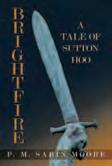

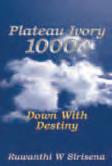











NOVEMBER FICTION
REVIEWED BY A N WILSON
EXTRACTS FROM OUR FAVOURITE NEW RELEASES
WHY WE’RE ALL FOOD OBSESSIVES NOW AND THE SCIENTIST WHO SAW GOD BOOKS THAT CHANGED MY LIFE: ARLENE PHILLIPS
EDITED BY RD BOOKS EDITOR JAMES WALTON

November fiction
Standing In Another Man’s Grave
by Ian Rankin (Orion, £18.99)
The wonderful Rebus is back! Ian Rankin fans will have been missing the anarchic, alcoholic Edinburgh detective since his creator started a new series about Malcolm Fox, whose job is to investigate dodgy police o cers. Hilariously, in the new one, the straight-laced Fox is looking into the irregular methods of our old friend,

who’s applied to rejoin the force, and meanwhile is helping out on cold cases. A chance meeting with a woman who thinks her daughter has been murdered then sets Rebus o on another adventure.
The result is vintage Rankin. Lord knows how many fags get smoked and malt whiskies downed in the course of this thoroughly absorbing, endlessly twisting tale. But I was gripped from first page to last—and so will you be.
Flight Behaviour
by Barbara Kingsolver (Faber, £18.99)
Dellarobia Turnbow, a spirited, bored young farmer’s wife with red hair and a Rebus-like addiction to cigarettes, is walking in the Appalachian mountains
A N Wilson welcomes back an old friend

when she comes across a valley that appears to be on fire. In fact, what she’s seen is a gigantic swarm of monarch butterflies.
This should be a great tourist opportunity for a depressed region, but soon a team of scientists arrives to find out why the butterflies have left their native Mexico. The answer turns out to be climate change—and it’s here that the novel gets really interesting. Dellarobia throws in her lot with the
CLASSICS CORNER: THE MURDER OF ROGER ACKROYD

With The Mousetrap celebrating an astonishing 60 years in London’s West End (and with the nights drawing in), November might be a good time to curl up with one of Agatha Christie’s novels. And, according to most critics, The Murder of Roger Ackroyd is the best of the lot. When it was published in 1926, its shock ending did provoke controversy as well as admiration—but that didn’t stop it becoming her breakthrough book. Now, Christie (right) is, by some distance, the biggest-selling novelist of all time.
142 READERSDIGEST.CO.UK NOVEMBER 2012
scientists, and her story becomes one of selfeducation and discovery. The contrast between the scientific world view and that of the American Bible Belt is inevitably stark— but Kingsolver handles it beautifully.
Two Brothers
by Ben Elton (Bantam Press, £18.99)
In 1956, Paul Stone, a shy civil servant at the Foreign O ce, is interviewed about his sister-in-law Dagmar Stengel, the girl he’s always loved, going right back to Germany in the 1920s. Now, though, she seems to be of interest to MI6.
As Paul’s memories unfold, we learn that he was born Otto Stengel, and that his mother was a brilliant Jewish doctor. And from there, we relive the whole familiar nightmare: the rise of the Nazis, the Holocaust and the descent of the Iron Curtain.
There are some fairly

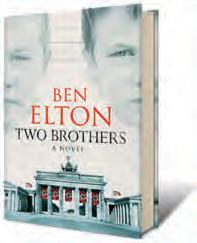
clunking stereotypes, and I winced whenever Stone’s West Indian girlfriend opened her mouth . (She speak like dis, man.) Yet, as you’d expect, the novel is well-crafted; and there’s no denying it’s a page-turner.
The Small Hours
by
Susie Boyt (Virago, £15.99)
The small hours are when we’re kept awake by anxiety. Or the small number of hours in a troubled life when we’re at peace. Or the hours for small people, for children.
This tightly written book is about a very unhappy, very self-centred, very rich woman called Harriet
Mansfield. Harriet is just concluding a long course of therapy when she inherits a large sum of money from a monster father and decides to start a primary school. She wants it to be a paradise, where the pupils know the kind of happiness she never had in her own demon-filled childhood.

Boyt exercises iron control over her material, but Harriet’s pain is still clear through the fine mesh of taut and witty prose.
» A N Wilson’s latest novel is The Potter’s Hand (Atlantic, £17.99)
QUICK QUIZ
Can you name the fictional character— celebrated in a new paperback out this month—from these clues? (And, of course, the fewer you need, the better)
1. His favourite book is The Oxford Book of English Verse.
2. His wife is called Hilda…
3. … aka “She Who Must Be Obeyed”.
4. He was played on television by Leo McKern. Answer on p146 ►
143 NOVEMBER 2012READERSDIGEST.CO.UK CORBIS/ALAMY
An abattoir for sacred cows
A fearless new book takes a blowtorch to our modern obsession with the once-simple business of cooking and eating food
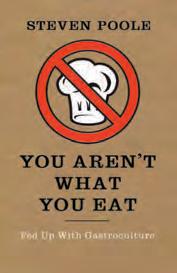
Remember when food was just something you ate? If so, you’re probably not young—because over recent decades it’s become much, much more than that. In fact, as Steven Poole (pictured right) suggests in his bracing new book, food is now little short of a secular religion. Think of how many cookbook-titles contain the word “bible”—or of the claims made on food’s behalf: that it nourishes the spirit, cures us of disease and even, according to Heston Blumenthal, gives “meaning” to our lives.
But, wonders Poole heretically, isn’t this all getting a bit out of hand? Armed with a brilliantly chosen series of quotes (although perhaps a few too many references to modern French philosophers), he shows how the preparation and eating of food has also taken on the language of drugs, art and, of course, sex. More heretically still, he reminds us that the theological definition of gluttony isn’t just “overeating”, but “taking an excessive interest in food”—which, in our quest for the perfect olive oil and the like, now applies to quite a lot of us.
In any case, many current food doctrines are simply fashions. Not so long ago, you proclaimed your social superiority by eating white bread and fruits out of season. These days, even the poshest restaurants o er “peasant food”—although not at peasant prices. But back at home, we seem to have forgotten that the most important aspect of sharing a meal with people is the people. (As Poole says, if your guests are genuinely bothered about the quality of your food, you’ve invited the wrong guests.)
And from there, the book gleefully demolishes almost all the other claims made by “foodists”—a term Poole prefers to the over-cuddly “foodies”. Localism, organic farming, slow food and, especially, the depressing idea that we should “live to eat, not eat to live”: one by one, they’re dispatched with such witty, erudite

THEY CANNOT BE SERIOUS!
Some of the foodists quoted in the book
“This is fine dining now, so Steve must remove the outer skin from each individual pea.”
Voiceover on MasterChef: The Professionals, 2011
“The act of eating engages all the senses as well as the mind. Preparing and serving food could therefore be the most complex and comprehensive of the performing arts.” Heston Blumenthal ►
144 READERSDIGEST.CO.UK NOVEMBER 2012
RD RECOMMENDED READ: 1
and ultimately thrilling relish that the book ends up as a kind of abattoir for sacred cows.
The real trouble for foodists, though, is that he’s so often obviously right. Take, for instance, this passage about the language of restaurant menus…
For some examples of the modern state of the art, let us consider L’Enclume, the Michelin-starred restaurant in the Lake District, and its bill of fare as advertised on its website in November 2011. The first dish I propose for our consideration is this: ‘Carrot sacks with brawn and juniper, fried cake and cress’. It is surely a masterpiece of tantalising obscurity. I confess to having no idea what ‘carrot sacks’ are: probably not the kind of coarse hessian sack in which one might transport twenty kilos of carrots, but then what? Tiny pretend bags made out of thin shavings of carrot artfully woven together? This dish also features ‘fried cake’, which has me pondering the desirability of frying a chocolate or sponge cake, but that cannot be it. Could it be a fishcake? Who knows?
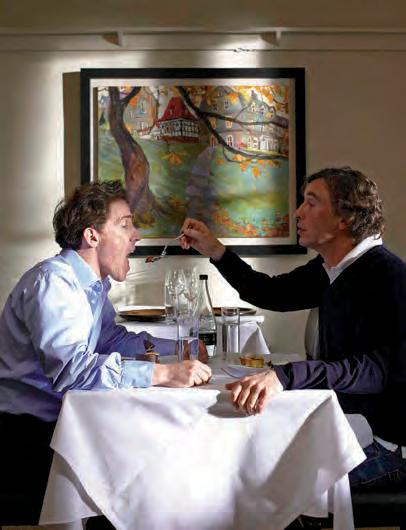
One thing I do know is that ‘brawn’ is pâté made from a pig’s head: an obvious example of menu euphemism. Another is that verbs tend to ascribe benign agency to the parts of a dead animal—as with the L’Enclume waiter in Steve Coogan and Rob Brydon’s TV series The Trip who explains that ‘The baby queen scallops are resting on grilled baby gem and parsley coulis.’ When the waiter leaves, Brydon comments: ‘Rather optimistic to say they’re “resting”. Their days of resting have been and gone. They are dead.’ (It is an interesting question, incidentally, why the word ‘baby’ in menu descriptions does not disgust us. Surely the last things we want to eat are babies.)
“Fancy a carrot sack?” Rob Brydon (left) and Steve Coogan in The Trip—a show that, according to Steven Poole, is “among other things, a wonderful satire on foodism”
You Aren’t What You Eat: Fed Up With Gastroculture by Steven Poole is published by Union Books at £12.99
145 NOVEMBER 2012READERSDIGEST.CO.UK
►
‘‘
A second dish on o er at L’Enclume is ‘Gott’s Holker milk-fed spring lamb, sheep’s milk curds, turnips, ramsons’. Well, obviously no one in the world knows what ramsons* are. But a word about ‘spring lamb’. It used to be that a ‘spring lamb’ was a lamb you ate in spring. The old English breed of Dorset Horn ewes gave birth in autumn, which gave the lambs just enough time to grow and be sco ed at Eastertime. But most breeds of sheep actually give birth in spring, so a spring lamb from those mothers ought to be eaten in winter.

“Hello, London. Here’s one you might recognise”: Jamie Oliver cooks live at a three-day food-androck festival on London’s Clapham Common
Confusingly, now people want ‘spring lamb’ all year round, in the industry it means nothing more than a lamb ‘raised on grass and butchered at the right weight rather than a certain time of year’. All this makes the designation ‘spring lamb’ entirely unreliable except as a spur to a cheerful mental image of the meat on your plate having once gambolled happily over the meadows.
L’Enclume’s ‘spring lamb’ is also ‘milk-fed’, which is reassuring, because you don’t want to eat one of those lambs that are force-fed ground-up cow skeletons and spongiform panda brains. The ‘Gott’s Holker’ part, meanwhile, turns out to mean a sheep from Holker Farm, which is run by a sheep farmer named Martin Gott. Hence, ‘Gott’s Holker milk-fed spring lamb’. So tastily named, I am sure it is the more delicious for it.

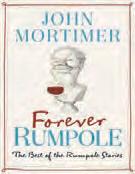
...AND THE QUICK QUIZ?
The answer was everyone’s favourite barrister Horace Rumpole. Forever Rumpole: the Best of the Rumpole Stories by John Mortimer is published by Penguin at £9.99.
OUR COVER STARS’ FAVOURITE BOOKS?
David Mitchell: Decline and Fall by Evelyn Waugh.
Robert Webb: Waterland by Graham Swift. *wild garlic!

“Chocolate
mousse remains the thing
I
feel
most
strongly about.” Tom Mitchelson, journalist, in The Times, 2011
“Preparing tripe is a transcendental act.” Thomas Keller of California’s French Laundry restaurant
“Eat Right for Your Blood Type”
Chapter title in The Optimum Nutrition Bible by Patrick Holford And more sensibly…
“Of course, I couldn’t actually write down what it had been like. You can’t make ‘fine’ run to 1,000 words.” Novelist Sebastian Faulks on his brief time as a restaurant critic
“It isn’t so much what’s on the table that matters, as what’s on the chairs.”
W S Gilbert
“At the end of the day, it’s just food, isn’t it? Just food.” Marco Pierre White
146
◄ ’’ ◄
IAN HARRISON/CAMERA PRESS LONDON; LONDON NEWS PICTURES/REX FEATURES
Imagine there’s a heaven...

A leading scientist couldn’t— until a near-death experience changed everything
Four years ago this month, Eben Alexander had a near-death experience in a Virginia hospital. The way he tells it, this began in primordial mud, continued with a ride on a giant butterfly and eventually brought him into the presence of God. All of which might sound like fairly standard (ie, flaky) New Age fare, except for two things. First, this took place after bacterial meningitis had shut down his brain completely. Second, Alexander is himself a respected neurosurgeon: the experience contradicted everything that he, as a man of science, thought he knew— including his scepticism about religion.
This same background also allows him to sift the latest academic theories that might explain what happened to him. Yet in the end, he rejects them all (on careful scientific grounds) in favour of a much more surprising one: that it was real. Months later, Alexander—who was adopted as a baby—even discovers from a previously unseen photograph that the young woman who’d welcomed him to the afterlife was a dead birth sister he’d never met.
Here, though, he tells us why he’s risking the scorn of his peers by writing the book at all.
On November 10, 2008, I was struck by a rare illness and thrown into a coma for seven days. My entire neocortex— the part of the brain that makes us human—was shut down. In essence, absent.
When your brain is absent, you are absent, too. As a neurosurgeon, I’d heard many stories of people travelling to mysterious, wonderful landscapes; of talking to dead relatives— even of meeting God Himself.
Wonderful stu , no question. But all of it, in my opinion, pure fantasy. I didn’t claim to know what caused these experiences,

Dr Eben Alexander is known worldwide for developing advanced neurosurgical technologies for complex brain disorders. During his 15 years on the faculty at Harvard Medical School, he authored and co-authored more than 150 peer-reviewed papers in neurosurgery
147 NOVEMBER 2012READERSDIGEST.CO.UK
RD RECOMMENDED READ: 2
‘‘ ►
but I did know that they were brain-based. All of consciousness is. If you don’t have a working brain, you can’t be conscious. Or so I would have told you before my own brain crashed.
During my coma my brain wasn’t working improperly—it wasn’t working at all. Many of the near-death experiences happen after cardiac arrest. In those cases, the neocortex is temporarily inactivated, but generally not too damaged. But I was encountering the reality of a world of consciousness that existed completely free of the limitations of my physical brain.
Mine was in some ways a perfect storm of near-death experiences. As a practising neurosurgeon with decades of research behind me, I was in a better-than-average position to judge not only the reality but also the implications of what happened to me.

Thanks to what happened during his coma, Dr Alexander now believes that “God cares about each one of us, and about the universe itself”
Those implications are tremendous beyond description. My experience showed me that the death of the body and the brain are not the end of consciousness, that human experience continues beyond the grave. More important, it continues under the gaze of a God who loves and cares about each one of us and about the universe itself.
My experience showed me that human experience continues beyond the grave
The place I went was real. Real in a way that makes the life we’re living here and now dreamlike by comparison. This doesn’t mean I don’t value that life, however. In fact, I value it more than I ever did. I do so because I now see it in its true context.
This life isn’t meaningless. But we can’t see that from here—at least most of the time. What happened to me in that coma is hands-down the most important story I will ever tell. But it’s tricky to tell because it’s so foreign to ordinary understanding. At the same time, my conclusions are based on a medical analysis of my experience, and on my familiarity with the most advanced concepts in brain science and consciousness studies. Once I realised the truth behind my journey, I knew I had to tell it. Doing so properly has become the chief task of my life.
Proof of Heaven: a Neurosurgeon’s Journey into the Afterlife by Eben Alexander is published by Piatkus at £12.99
148 READERSDIGEST.CO.UK NOVEMBER 2012
’’
◄ BLOOMSB U RY PH OTO P RODU CT ION/FLIC KR /GETT Y IMAGE S

Books that Changed my Life
Choreographer Arlene Phillips first entered the public eye when she created the dance group Hot Gossip in the 1970s. Her work has since featured in film, TV and theatre. She also spoke recently about her father’s dementia for Bupa’s support initiative Dementia Hub.
Little Women
by Louisa May Alcott
As a child, I lived for visits to the library. I read all the dancing books because that was my passion, but it wasn’t until Little Women that I realised the power of great novels. I identified with each of the girls—I wanted to be like Beth, kind and unselfish, but was really more like the determined go-getter Jo.
Beth resides in my consciousness to this day— I still try to do the good and charitable thing. When I wrote my series of children’s books Alana Dancing Star, I had this novel strongly in mind. Alana is an amalgamation of Meg, Jo, Beth and Amy, and a character I hope my young readers identify with as strongly as I did to those “little women”.
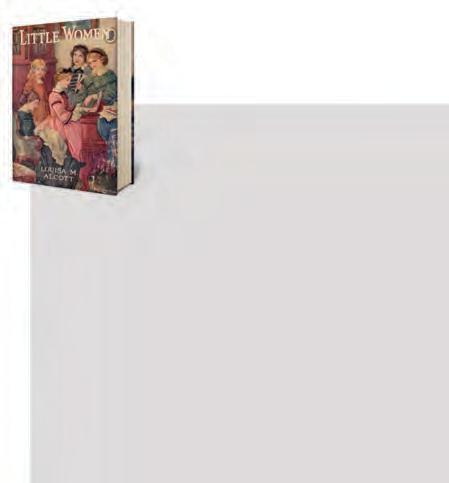
Six Fairy Tales by the Brothers Grimm, with etchings by David Hockney
Another second-hand find. When I saw the illustrations, I became an instant Hockney fan and my ardent wish was to own a print of his—though, at the time, I didn’t dream that I’d ever a ord

As told to Caroline Hutton
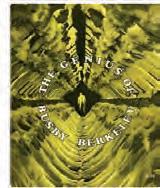
The Genius of Busby Berkeley
by Bob Pike and Dave Martin
This cost me £2.75 in a second-hand bookshop in the 1970s. Berkeley was a visionary musical choreographer and film director who, from the early 1930s, created staggering ensembles of dancers in often-complex kaleidoscopic patterns in classic films such as 42nd Street and Footlight Parade. The book not only explained how he crafted his films, it was also full of extraordinary photographs of the dance formations.
At the time, I was working on a complex Dr Pepper ad with over 40 dancers, and I turned to this book for inspiration.
one. Although my father often took us to exhibitions, art seemed unattainable. Now I’ve got a few Hockney prints— they’re my dearest possessions. When I went to his recent London exhibition, I just stood with tears pouring from my eyes at the wonder of his talent. ■

149
SISTER IN SECOND-HAND SEQUINS






















154 READERSDIGEST.CO.UK NOVEMBER 2012 ACROSS 9 Discordant sounds (9) 10 Cordiality (5) 11 Useless structure (5) 12 Popeye’s enemy (5) 13 Shade of colour (3) 14 Concept (4) 16 India’s “Silicon Valley” city (9) 20 Very wicked (7) 22 Fortress, castle (7) 23 Appeasing (9) 25 Roman emperor AD54–AD 68 (4) 28 Crunchy lettuce (3) 29 Manlike in appearance (5) 31 Cornish river (5) 32 Spanish winegrowing region (5) 33 Variety of black co ee (9) DOWN 1 Scrape mark (5) 2 Mounted, climbed (6) 3 Active, nimble (4) 4 Underground vault for the dead (4) 5 Gallows site in old London (6)
Crossword ACROSS: 9 Cacophony 10 Amity 11 Folly 12 Bluto 13 Hue 14 Idea 16 Bangalore 20 Heinous 22 Citadel 23 Pacifying 25 Nero 28 Cos 29 Butch 31 Camel 32 Rioja 33 Americano DOWN: 1 Scu 2 Scaled 3 Spry 4 Tomb 5 Tyburn 6 Halo 7 Richmond 8 Byte 15 Aloof 16 Bus 17 Anton 18 Elle 19 Shop 21 Incision 22 Cog 24 In tray 26 Ramsay 27 Elbow 28 Cart 29 Bran 30 Heep 31 Cain 6 Sign of sainthood (4) 7 State capital of Virginia (8) 8 Computer’s set of binary digits (4) 15 Unapproachable (5) 16 Large red vehicle in London (3) 17 Chekhov’s first name (5) 18 French word for “she” (4) 19 Retail outlet (4) 21 Medical cut (8) 22 Wheel tooth (3) 24 Desktop container (2,4) 26 Surname of celebrity chef Gordon (6) 27 Funny-bone joint (5) 28 Farm trailer (4) 29 Grain husks (4) 30 Surname of Dickens’ character Uriah (4) 31 Brother of Abel (4)
Test-Your-Knowledge
* Entry is open only to residents of the UK, Channel Islands, Isle of Man and Republic of Ireland aged 18 or over. It is not open to employees of Vivat Direct Limited (t/a Reader’s Digest), its subsidiary companies and all other persons associated with the competition.


1. Noughts and crosses
Put a nought (O) or a cross (X) in each cell so that there are no lines of three (OOOs or XXXs) in any direction.
3. Pathfinder
Beginning with the highlighted letter, follow a continuous path to find 20 circular objects. The trail passes through each and every letter once and may twist up, down or sideways but never diagonally.

Teatime Puzzles
2. Suko Place the numbers 1 to 9 in the spaces, so that the number in each circle is equal to the sum of the four surrounding spaces, and each colour total is correct.




£50 prize question (answer will be published in the December issue)
Wordladder Change one letter at a time (but not the position of any letter) to make a new word—and move from the word at the top of the ladder to the word at the bottom using the exact number of rungs provided.

The first correct answer we pick on November 1 wins £50!* Email excerpts@ readersdigest.co.uk
Answer to October’s prize question:
One solution is: Part, pare, bare, bake, take, tame, time
And the £50 goes to… Gladys Dawson from Aberdeenshire
155
1 2 3
ALL CONTENT SUPPLIED BY PUZZLER MEDIA LTD
THIS MONTH’S ANSWERS
Laugh!


WIN £70 FOR EVERY READER’S JOKE WE PUBLISH. EMAIL EXCERPTS@ READERSDIGEST.CO.UK OR GO TO FACEBOOK.COM/READERSDIGESTUK
¶ Edward Deidde, the man who spent his entire life explaining that his surname was said “deed”, has collapsed.
He was airlifted to hospital, where he was pronounced dead. Seen at experienceproject.com
¶ I’ve got nothing against people being spontaneous; I just think there’s a time and a place for it.
Ian Drummond, Cromer, Norfolk
¶ Cover star David Mitchell’s favourite joke:
Q: What’s grey and can’t climb trees?
A: A car park.
And Robert Webb?:
Q: What’s red and goes “beep beep”?
A: A strawberry in a tra c jam.
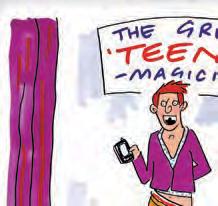





“OK,
you there—text me a number, any number…”




¶ A WIFE TEXTS HER HUSBAND ON A chilly winter’s morning. “Windows frozen!”
Her husband sends the message back, “Pour lukewarm water over it.”
Five minutes later comes the reply, “Computer completely messed up now...”
Catherine Hiscox, Hemel Hempstead
¶ I’ve been told that when you meet the right person, you know immediately. How come when you meet the wrong person, it takes a year and a half?
US comedian Phil Hanley
¶ I really didn’t want to get out of the bed this morning. Sadly the sta in Ikea were quite insistent. Comedian Tiernan Douieb
156 READERSDIGEST.CO.UK NOVEMBER 2012

¶ An optimist walks into a bar and says, “I’ll have a free pint, please.” Seen on the internet
¶ A hyena swallowed an Oxo cube. He became a laughing stock. Derry Jones, Harrogate
¶ My grandad just paid £1,000 for a pair of binoculars. They must have seen him coming.
Comedian Matt Rudge
Just
If Big Ben fell on your head, it would hurt big time
Comedian
Milton Jones
¶ Not impressed by these socalled rescue cats. I’ve been stuck on the roof for half an hour now and mine hasn’t budged.
¶ Say what you like about the Queen—she’s always on the money.
¶ In the Eighties, my nickname was Drugs, because when I asked girls out they’d just say “no”.
All three by comedian Gary Delaney
joined an underground laryngitis club. The first rule of Laryngitis Club...
Comedian Dave Johns, by Twitter
LITTLE EPIPHANIES
# 19: LIFE’S TOO SHORT FOR CLEANING SHEETS



 BY ALUN COCHRANE
BY ALUN COCHRANE

Comedian Alun Cochrane inhabits a daydreamy world of surreal realisations and whimsy. This is his monthly moment of revelation
I was recently performing overseas and, on day two, a letter was put under my hotel-room door. It said, “The sta are on strike. We hope it’s OK with you, but we won’t be able to change your bedding or restock your mini bar.”
It’s only when away from home that we expect our bedding to be cleaned with a frequency that can be numbered in days. My wife is the chief bedding changer (don’t judge us. I deal with massive spiders—we all have roles in a relationship). I think it’s changed weekly, but I don’t know because I only notice it after it’s changed. But never once in my life have I got in the bed and thought, This bedding needs changing. Never.
Left to my own devices, I might change it—perhaps once every 18 months. I’d be approaching Christmas and think, Shall I? But there’s a lot on at the moment—I’ll leave it till Easter. I’d change a pillowcase quarterly to keep things fresh—a bit like when a woman in a hurry washes her fringe instead of her hair.
I wash myself, so why bother with bedding too? Who’s thinking, I played football today. Some good sliding tackles, so time for bed without washing this mud o . Even the most time-pressed Premiership star gets in the bath. Five days of no room service taught me that beds don’t need changing at all.
157 READERSDIGEST.CO.UK NOVEMBER 2012
►
►
WORST MONEY-SAVING TIPS EVER SEEN AT CRACKED.COM
Humour website cracked.com has collated the ten most dignity-destroying pieces of penny-pinching wisdom they’ve come across. Here’s a taster.
► Separate the two layers of your loo roll to make it last double the time.
“Inexplicably, there are sites out there that o er up this tip to save cash—at the cost of dignity, pride and hundreds of hours of your time. One site (thehappyrock.com) even does the calculations for you, based on a 100-sheet-per-day scenario, and comes up with a whopping saving of almost £5 a year.”
► Knit jumpers from your pet’s fur instead of wool.
“With only minimal shame and an excessive amount of e ort, you can buy a book (Knitting with Dog Hair by Crolius and Montgomery) that will show you how to spin your dog or cat’s fur into yarn, which you can then knit into sweaters, purses, thongs or whatever hideous thing you choose.”
► Going on holiday? Who needs a hotel when you can...sleep in the airport!
“Really, if you can put up with not having a bed, a shower, a kitchen, or privacy, or thousands of people looking at you all night, then this is the money-saving tip for you. Oh, and in an ironic twist, Sleepinginairports.net also o ers up a list of the worst airports to kip in, with Charles de Galle in Paris ranking highly. Why? Because of the number of bums who sleep there.”

SIGNS OF THE TIMES
It’s a tough economic climate for small businesses, but these are doing their best to keep us entertained.



158 READERSDIGEST.CO.UK NOVEMBER 2012
¶ Everyone is entitled to their opinions, but if their opinions di er from mine, they’re idiots. In my opinion.
Online comedian Roger Quimbly ¶ Just watched all the Lord of the Rings films back-to-back with a friend. Stupid really, because it meant I couldn’t see the TV.
Comedian Jon Richardson, by Twitter
¶ It’s a ten-minute walk from my house to the pub. Weirdly, it’s a two-hour walk from the pub to my house.
Twitter user Jon Taylor, @jontaylor180
¶ I missed last night’s Hairdressing World Championships. Anyone know if there were any highlights?
Comedian Tony Cowards
¶ To take a liedetector test, ironically one must sit down.
Comedian Paul Foot, by Twitter
60-Second Stand-Up
Ladies and gentlemen, please welcome Paul Tonkinson
FAVOURITE ONE-LINER?
Q: What’s the di erence between a kangaroo and a kangaroot?
A: A kangaroo is a marsupial from Australia. A kangaroot is a Geordie stuck in a lift.
BEST JOKE YOU’VE EVER WRITTEN?
A bit where I talk about my son, who thinks he’s a gangsta rapper. He calls himself B-Boy Fresh—he’s nine! I talk about him wearing a cap and his jeans really low; he looks like he’s been surprised in the act of dressing and forced to leave the house. Either that or he’s been playing Buckaroo with himself.

Paul Tonkinson is now on a UKwide tour. See paultonkinson.com
FUNNIEST THING THAT’S EVER HAPPENED TO YOU? Funny things happen to me because of my inability to process how things work. On my first day driving, my car broke down in London. I got out and a guy o ered to help me push it to the side of the road. We both started pushing from behind the car. It was only when we’d pushed the car down a small hill into another car that the bloke gave me a look. He said, “I assumed someone was steering...?” I said, “I didn’t know anybody was meant to!”
FAVOURITE TV SHOW?
Modern Family. It’s about three interconnecting families, and it’s so funny and bright and warmhearted, but very intelligent as well. It’s winning loads of awards constantly, and anybody can enjoy it.

FINALLY, WHO’S YOUR COMEDY INSPIRATION?
Billy Connolly. I like people who bring joy to others’ lives, who are passionate and furious and fun. He ticks all those boxes. I’m not particularly into cynicism or trying to shock a crowd; I like to lift them. So I love Connolly. n
159 READERSDIGEST.CO.UK NOVEMBER 2012
Beat the Cartoonist!
WIN £100 AND A SIGNED ILLUSTRATION

Think of a witty caption for this picture and you could beat the experts at their own game. The three best suggestions will be posted on our website in mid-November alongside an anonymous caption from our professional cartoonist. Visitors can choose their favourite—and if your entry gets the most votes, you’ll receive £100 and a framed copy of the drawing. Submit to captions@readersdigest.co.uk or the address on page 4 by November 9. Enter and vote online at readersdigest.co.uk/caption. We’ll announce the winner in our January issue. ■ winner in our January issue.


NEXT MONTH…
SEPTEMBER’S WINNER

The cartoonists’ comeback continues!
David McNeill’s caption, “Look, there’s no easy way of saying this. The circus is downsizing and we’re going to have to let you go,” secured victory by just a single vote. This, surely, means war!
SCOREBOARD READERS 5 CARTOONISTS 4

“You’ll never guess what happened to me over Christmas!”
Readers’ tales of festive follies...
What’s stressing you?
Quick tests and tips to tackle tension

Britain’s quirkiest shops
Original places for perfect presents

PLUS
• What your wine merchant won’t tell you
• Your ideas for making Christmas simpler/easier/better

• Ian McKellen
Madhur Ja rey

Follow us at twitter.com/rdigest. Like us at facebook com/readersdigestuk


Building on over 30 years of innovation and research, the new Bose® Wave® music system III delivers awardwinning, room-filling quality sound, yet this compact, all-in-one system takes up less space than a single conventional speaker.
New features.
notes – and experience clarity at even the highest frequencies. Exclusive Bose® waveguide technology allows this uniquely compact system to outperform larger, more elaborate hi-fi – at a fraction of their price.
Music from your iPod, iPhone, computer or tablet. Available accessories bring music from your iPhone or iPod, or wirelessly from your tablet, computer or other Bluetooth® device. And being compact, the Wave® music system III fits neatly just about anywhere – so you can enjoy all kinds of music in all kinds of places.
Hear it for yourself, risk-free.

The new Wave® music system III now has a built-in DAB tuner with improved FM/AM reception, while a digital display shows artist and station information as you listen. New touch-top controls turn the system on, off and snooze the alarm; a slim, credit card-style remote offers one touch control of the system’s full functionality. Add the new dual alarms for two different wake-up times and the Bose Wave® music system III offers you more convenience than ever before.
Music. As it was meant to be heard. The Wave® music system III reproduces music with the most accuracy we’ve ever produced in a system this small. You’ll hear details you’ve never noticed in songs you know by heart, feel a fullness and power of bass
We believe the best way for you to appreciate the new Wave® music system III is to experience it in your own home. So call now and listen for 30 days without risk or obligation. Why wait any longer? Hear for yourself why Bose is one of the most respected names in sound.
*Payment plan is available on credit/debit cards only and is subject to status. An initial deposit is due at the time of order and all payments will be charged to your credit/debit card. If the product is returned, the deposit is fully refundable. ere will be no interest charges from Bose. In the event of late payment, credit/debit card company interest charges may apply. Delivery is subject to product availability, clearance of payment and security checks and can be up to 10 days from when Bose receives the order. Price/Payment plan/Offer subject to change without notice. Free shipping offer applies to UK standard delivery only. Risk free refers to 30-day home trial only. ©Bose Corporation 2012. All rights reserved. e Wave® music
WAVE® MUSIC SYSTEM III NEW
system’s distinctive design is a registered
e Bluetooth® word mark is a registered trademark owned by Bluetooth SIG, Inc., and any
iPhone
trademarks of Apple Inc. Registered DAB Digital Radio used with permission of
One Ltd.
in
Registered Office: Bose Ltd., 1 Ambley Green, Gillingham Business Park, Gillingham, Kent ME8 0NJ.
trademark of the Bose Corporation in the U.S. and other countries.
such use by Bose Corporation is under license. iPod and
are registered
Digital
Registered
England no 1187672.
Product shown in Titanium Silver. Also available in Graphite Grey and Platinum White. It’s
wanted.
better. TO ORDER OR TO LEARN MORE Call FREE on 0800 081 3546 quoting reference 40051 or visit www.bose.co.uk/wms NOW WITH BUILT-IN DAB Place your order now 30 DAYS Easy payment options - 0% interest charges from Bose* FREE shipping to your home To try it, with no obligation Not delighted? FREE return shipping Monday to Friday 9am – 6:30pm, Saturday & Sunday 10am – 5pm FOR A FREE INFORMATION PACK TEXT ‘BOSE40051’ TO 84118
what you’ve always
Only


























































































 bride: Helena Bonham Carter as Miss Havisham
bride: Helena Bonham Carter as Miss Havisham







































































































































 David is a regular on panel shows such as Have I Got News for You, QI and Would I Lie to You (left),
sketch show
David is a regular on panel shows such as Have I Got News for You, QI and Would I Lie to You (left),
sketch show









































































 BY LOLA BORG
BY LOLA BORG





























 A model of Charlie Chaplin stands in the Kinema foyer
Bristol Cube: the revolution will not be projected in 3D
A model of Charlie Chaplin stands in the Kinema foyer
Bristol Cube: the revolution will not be projected in 3D












 BY DANNY SCOTT
BY DANNY SCOTT


































































































































































































































 Conor McNicholas
Conor McNicholas



























































































 BY ALUN COCHRANE
BY ALUN COCHRANE
















